Abstract
A few puzzles relating to a small fraction of my endeavors in the 1950s are summarized herein, with answers to a few questions of the Editor-in-Chief, to suggest that the rules of variability in time complement the rules of genetics as a biological variability in space. I advocate to replace truisms such as a relative constancy or homeostasis, that have served bioscience very well for very long. They were never intended, however, to lower a curtain of ignorance over everyday physiology. In raising these curtains, we unveil a range of dynamics, resolvable in the data collection and as-one-goes analysis by computers built into smaller and smaller devices, for a continued self-surveillance of the normal and for an individualized detection of the abnormal. The current medical art based on spotchecks interpreted by reference to a time-unqualified normal range can become a science of time series with tests relating to the individual in inferential statistical terms. This is already doable for the case of blood pressure, but eventually should become possible for many other variables interpreted today only based on the quicksand of clinical trials on groups. These ignore individual differences and hence the individual's needs. Chronomics (mapping time structures) with the major aim of quantifying normalcy by dynamic reference values for detecting earliest risk elevation, also yields the dividend of allowing molecular biology to focus on the normal as well as on the grossly abnormal.
Introduction
This is a response to an invitation by Dr. Roberto Refinetti, professor of psychology and author of a book on Circadian Physiology [1], to contribute to the first issue of his new open-access journal, also focusing on circadian rhythms. This invitation is very greatly appreciated, since Roberto's genealogy is that of a clock-watcher (honi soit qui mal y pense), yet he also offers in his book some inferential statistical routines that can serve for resolving features of time series that are not immediately apparent to the naked eye. I learned much from Roberto, who reorganized the paper so that I offered him co-authorship, which, to my regret, he declined. In our discussions thus far, we agreed, above all, on the need for unity and a start with a discussion based on data.
To introduce material that can no longer be readily retrieved electronically, I have listed here a few puzzles from experience in the 1950s. It is hard, however, to single out any field to which circadians are not relevant, whether to scientists and other professionals, or even the proverbial person on the street. As a minimum, everyone should know about when to eat [2,3] and, if need be, when to treat [4-6], or rather one should try to prevent the need to treat. Prof. Refinetti's journal is welcome first of all because circadian rhythms are a most prominent and useful aspect of our everyday physiology and thus deserve a medium that can be retrieved free of charge by everybody interested worldwide. The challenge of this invitation also stems from the circumstance that like many fields coming of age, chronobiology (the topic of the mechanisms underlying biological diversity in time) is practiced by many investigators in different ways, by some, like the editor, with main focus on circadian physiology, and by still others with exclusive focus on timekeeping along the 24-hour and calendar-year scales.
Prof. Refinetti asked me to prepare this article in response to six questions, each of which I address below. When possible, I provide illustrations and references, with the foregoing and following comments given in the first person, with scrutiny by co-authors again only insofar as possible. Of necessity, too often I rely only upon my 84-year-old (age-qualified) memory. When I am uncertain of exact or even approximate calendar dates, I describe circumstances that provide at least a bracket in time, such as first meetings with colleagues, for the first consideration of "circadian" or for the interpretation of free-running by others, also using a free-running oscillator as an analogy and then as a model for exploring the endogenous aspects of rhythms in the biosphere.
What was your initial interest in the biomedical field?
As a child I had none. In my earliest adolescence I wanted to become a poet (and recently indulged again in this pastime [7]). My father, to whom I owe more than I can express in words – an international attorney who would have preferred to be a physician himself – kindly urged me to take up medicine, which I did. I in turn urged my daughters to do the same, not by words but by example and deeds as a family affair [8-14].
I started in high school accompanying physician friends of my parents in their practice and helping out in hospitals during vacation, when not travelling. Thus, as an interested student, I was just in time, before I went to medical school, to learn first-hand that cases of pneumonia for which there was then no treatment as yet, lasted about a week, before recovery or death, or as it was put in antiquity, before the occurrence of the lysis or crisis. This was my first encounter with timing in disease, namely with the biological week, which was known to Hippocrates in Greece, to Galen who had settled in Rome, and to the Islamic physician Ibn Sina (Avicenna) in Persia. They all knew that many diseases lasted about 7 days, the very lesson that I would have missed about single stimulus-"induced", or rather -"manifested", circaseptan periodicity, had I not observed patients before the advent of sulfonamides and penicillin [15-19].
During medical school, I dabbled in endocrinology and infectious disease research, including a study in a Rockefeller Institute in Budapest and at an institute on Lake Balaton. While trying to help in the improvement of a vaccine for typhoid, I managed to catch a severe case of it myself, perhaps by not washing my hands thoroughly before playing tennis over the noon hour. Subsequently, with an interest in the adrenal cortex in post-World War II Innsbruck, I was a university assistant, who, i.a., lectured to students in physical education who skied or otherwise exercised during the daytime and came fatigued to evening classes (I was popular with them since after a sentence or two I turned out the lights, showed slides and allowed those so inclined to sleep). At meetings, I also learned, only in theory, about the importance of probability in close contacts with the physicist Arthur March, a friend of Erwin Schrödinger, and wrote briefly about "rather than" vs. "yes/no" [20]. But the major findings of that time in health care seemed to be fully deterministic. The discoveries first of sulfonamides and thereafter of penicillin attracted the attention of many, including myself [21]. My concern earned me a much appreciated invitation to work with Sir Alexander Fleming, the discoverer of penicillin, in the bacteriology department of St. Mary's Hospital in London. I did not accept this invitation since I preferred a fellowship at Harvard in endocrinology (my love in classical medicine), but gratefully kept the few packages of cigarettes Sir Alexander kindly offered when he visited Innsbruck.
The successes of both sulfonamides and penicillin were splendid and changed the practice of health care insofar as certain infectious diseases were concerned. Seemingly no statistics were needed. We dealt with true wonder drugs, we believed then, if not now. (Concern arising from findings of bacterial resistance came later.) By the 1940s, patients who received these antibiotics recovered, say from pneumonia, or so it appears, irrespective of treatment time. The ~7-day interval between the onset of a certain disease and its end, one way or another, was soon forgotten. To keep abreast clinically while it also helped to augment my income, I further took care of a dermatology and venereal disease ward in a French-occupation army hospital, where two cases stimulated my interest in timing to the point of producing a publication [22].
Arthur March had taught me caution, so I did not generalize when, on the same day, I diagnosed gonorrhea, again without statistics, in two young soldiers and started their treatment with penicillin concurrently [22]. In talking to the soldiers, I learned that they had had sexual intercourse with the same prostitute a day apart. As the treatment continued, the one who had been exposed later was first to show a negative smear for the infectious agent. The result suggested that the time elapsed between the infection and start of treatment could be important. With only two cases to compare, there was no way to attach any probability to the interpretation that timing was important, as stated in print [22].
In Innsbruck, I also regularly took vaginal smears from prostitutes, stained by Erhard Haus, to follow changes in mucus described in a book by George Papanicolaou, another excursion into a cycle, but for whatever reason we could not find the reported changes. Mapping of changes with an about-monthly period had to wait [16].
The general adaptation syndrome
Already in Innsbruck, I had learned about theories concerning the adrenal glands' corticoids, secretions then and now believed to be triggered by the wear and tear of everyday life (stress). Originally corticoids were of interest in military medicine, as support for vigilance by pilots in combat. In a much broader context, a general adaptation syndrome, based on ubiquitous responses of the adrenal cortex to various stimulations, was looked upon as the mechanism of all chronic disease [23-29]. In a general way, many stimuli to which an organism is exposed were recognized to elicit an unspecific secretion of adrenal cortical hormones in an "alarm reaction" that continued during a stage of resistance until the gland was "exhausted". At that time, timing was not considered as a dimension to be specified for a given response tested, as for instance was dosing for any stimulus tested, even though physiologists like Pavlov had recorded the clock-hour of each step in their experiments, even without the application of a stimulus [30].
With Hans Selye, the proponent of stress studies, in the limelight urging an interest in the adrenal, zoologist Samuel H. Williams, a U.S. government talent scout, singled me out in Austria after World War II. With help from others, including Dr. Dr. Mr. Gustav Sauser (whose doctorates were in medicine and theology; "Mr." stands for Magister of Pharmacy), my department head, then dean and eventually rector in Innsbruck, I received a fellowship from the World Health Organization (WHO) and Williams got me round-trip passage on a liberty ship to New York, to join the group of endocrinologists led by Fuller Albright and Frederic C. Bartter at the Massachusetts General Hospital ("Mass General") in Boston. By the time I arrived in October 1948 in New York, however, Albright's deteriorating health would no longer permit him to accept any new fellows, and I was reassigned to the Peter Bent Brigham Hospital and Harvard Medical School, also in Boston (visiting Mass General every so often).
New wonder drugs
Once cortisone injections, like a pharmaceutical Lourdes, restored the ability to walk to people who had been lame for years, adrenocortical hormones gained a very important clinical status and came into the limelight. It became highly desirable to identify corticoids in body fluids on the one hand and to find substances that acted like them on the other hand. For both aims, I was assigned the development of an external bioassay, a test to determine corticoids and related compounds with action similar to that of corticoid. At the time, corticoids were scarce. Hence, I implanted substances under the skin of mice and determined corticoid-like activity in blood and other body fluids collected from patients. The endpoint I was to use was the count of certain circulating white blood cells in mice, i.e., the number of cells called eosinophils because they stained with the acid dye eosin [31]. Eosinophil mouse cells could not be seen and hence could not be counted with the stain used to count the corresponding cells in humans. A method had to be developed to see these cells under a microscope in blood drawn with a pipette after I made a nick in the mouse's tail. Once these cells could be counted, which was a matter of changing the dilution factor used for staining human cells, I also found, as had many before me, that the counts varied greatly, and I had to solve many puzzles [32], Figs. 1,2,3,4,5,6,7,8,9,10,11, before an external, and as it turned out to be, also an internal bioassay was to succeed; but this would occur after I moved to Minnesota.
Figure 1.
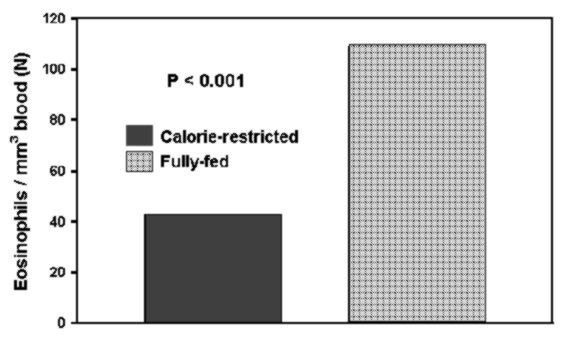
Eosinophil counts lowered by "fasting" and/or "stress". Effect of a 50% reduction in dietary carbohydrates and fats (with proteins, vitamins and minerals as in control group) in C3H mice with a high breast cancer incidence (not shown), which is greatly lowered by a diet reduced in calories. Is an adrenocortical activation, then assessed by eosinophil depression, an answer for treating breast cancer and for prolonging life? A large and exciting finding – a difference in eosinophil count between two groups of mice – was found, and of course it had to be replicated on a larger group of animals because of its importance to the etiology of cancer. Steroids that depress eosinophil cell counts and perhaps mitoses could be a mechanism through which caloric restriction and ovariectomy act in greatly reducing cancer incidence. This may be the mechanism to prevent breast cancer, or was this very reasonable and plausible hypothesis a premature extrapolation? (My chief had taken these results as a statistically significantly validated, most promising report to Paris.)
Figure 2.
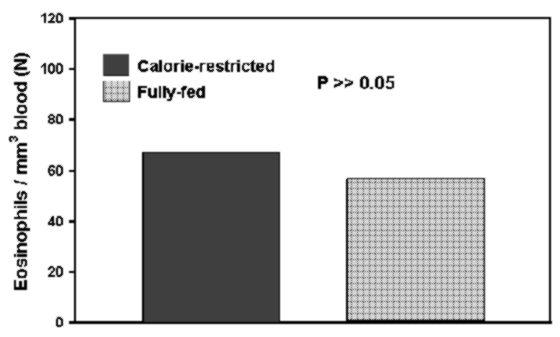
Confusing results one week later: follow-up with more animals starting at an earlier clock hour shows "no difference". A phase difference between the two groups was predicted. The large inter-group difference in eosinophil count was not replicated when more animals were used with an earlier start.
Figure 3.
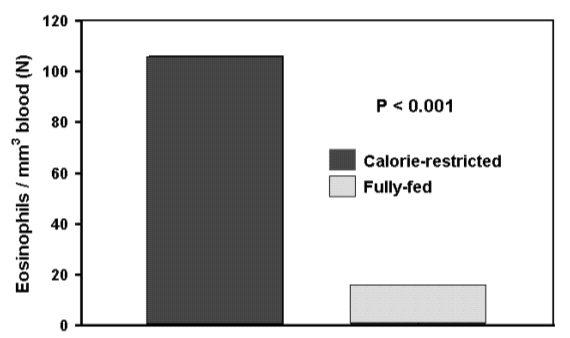
Opposite outcome observed another week later: has "stress" become "allergy"? Erroneous conclusions from ignoring a phase difference in circadian rhythm due to competing synchronization. Results from another follow-up with even more animals at a yet earlier clock hour. A difference in the opposite direction as compared to the difference observed first (Fig. 1) is noted.
Figure 4.
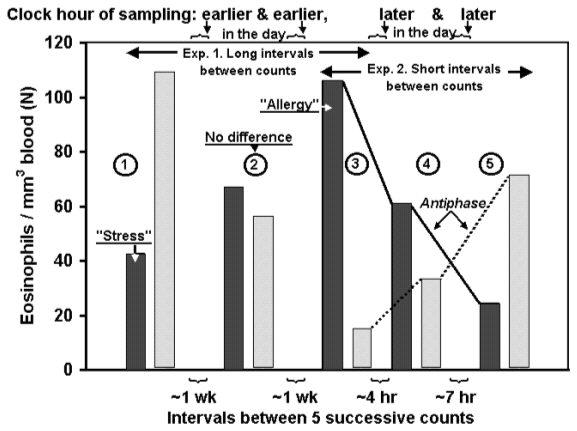
Recognition of circadian phase difference between two groups of mice prevents the drawing of false conclusions. Light gray: fully-fed group; dark gray: calorie-restricted group. Two groups of C3H mice (with differing breast cancer incidence) compared at single but different clock hours, first at near-weekly intervals (1, 2 and 3) and then at about 4- and again about 7-hour intervals (4 and 5) on the same day. The first 3 samplings at weekly intervals were made at earlier and earlier clock hours on two groups whose circadians were in antiphase, since one was fed a calorie-restricted diet in the morning, while the other group was fed ad libitum and fed mostly during the nightly dark span. To validate this assumption, the final two samplings at about 4- and then at about 7-hour intervals on the same day showed, as anticipated, the predicted reversal of the inter-group difference. (A progressive lowering of count associated with repeated blood letting had been demonstrated separately.) The time of day of sampling was the same for the two groups compared, but it differed from comparison to comparison in Figs. 12,3 (circled 1, 2 and 3); this fact confounded the results, as documented by repeating sampling at different clock-hours on the same day (circled 4 and 5). This circumstance accounts for the different results in Figs. 1,2,3: 24-h synchronized rhythms were compared on the same lighting but on different feeding regimens, as we realized and then documented the dominant synchronizing role of feeding time (overcoming the effect of lighting) on a diet restricted in carbohydrates and fat by 50% [86].
Figure 5.
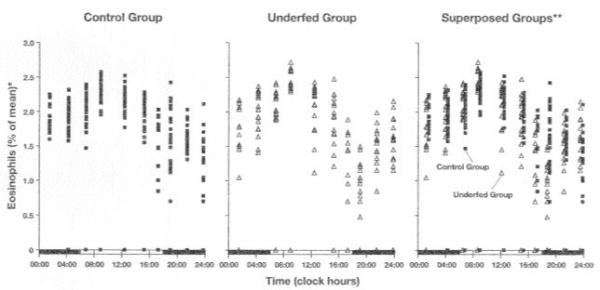
Effect of food restriction on circulating eosinophils in mice. *After log10-transformation of data expressed as percentage of mean. **To reveal the difficulty to resolve differences by the naked eye alone, and the even greater difficulty of quantifying the patterns of each group and any inter-group differences. There is a need to cover the 24-hour time scale to look for intergroup differences in the face of a large variability, what the active Claude Bernard rightly called the "extreme variability of the internal environment" [264]. Our analysis of variance reveals statistically significant time and group effects and interaction in this time-macroscopic approach, shown elsewhere [303].
Figure 6.
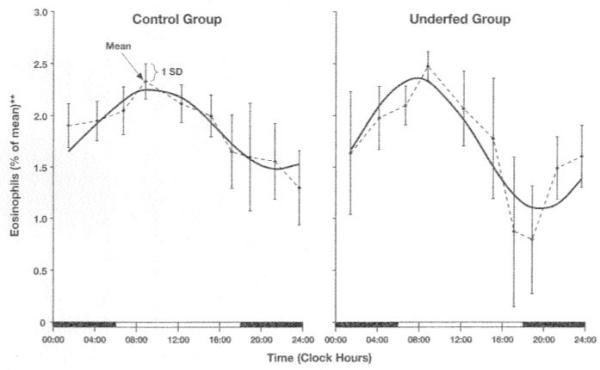
Food restriction amplifies circadian rhythm of circulating eosinophils in mice.*P < 0.001 from test of equality of amplitudes. ** After log10-transformation of data expressed as percentage of mean. Parameter estimations and comparisons can be derived from the fit of a 24-h cosine curve (shown with original timepoint mean values ± 1 standard deviation). Circulating eosinophil counts of the underfed group are lower (P<0.001) than those of the control group. The circadian pattern of the underfed group has a larger amplitude (P<0.001) and an earlier acrophase (P=0.003) as compared to that of the control group. This microscopic approach quantifies the effect of food restriction upon the eosinophil counts, also documented by an analysis of variance as a statistically significant time-group interaction [303].
Figure 7.
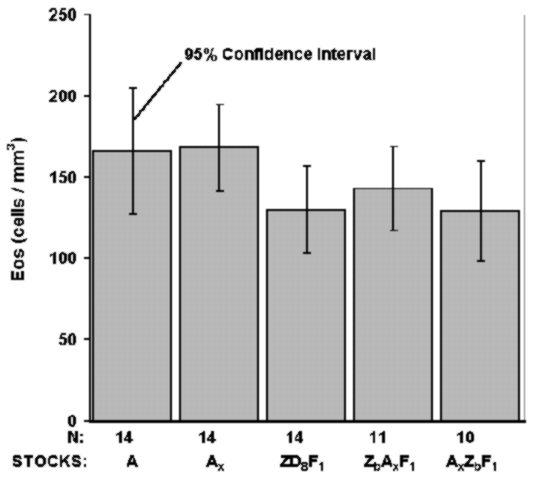
Genetic uniformity in averages? (spurious in the light of more stocks examined). Data on eosinophil counts (Eos) in five stocks of mice (from Halberg et al. J Hematology 6: 832–837, 1951; cf. Proc Soc Exp Biol & Med 75: 844–847, 1950). Mice kept in L6-18D18-6. Sampling during fixed clock hours: 06:00 – 10:00. When the time of day of sampling is fixed along with the lighting and feeding regimens, seemingly reproducible results are obtained on five stocks of mice, namely the A strain (with the mammary cancer agent [MCA]) and the A× (foster-nursed without the MCA), and various first-generation hybrids of the C3H mice (Z with and Zb without the MCA) and the Dilute Brown subline 8 (D8 with the MCA) mice, again a premature extrapolation.
Figure 8.
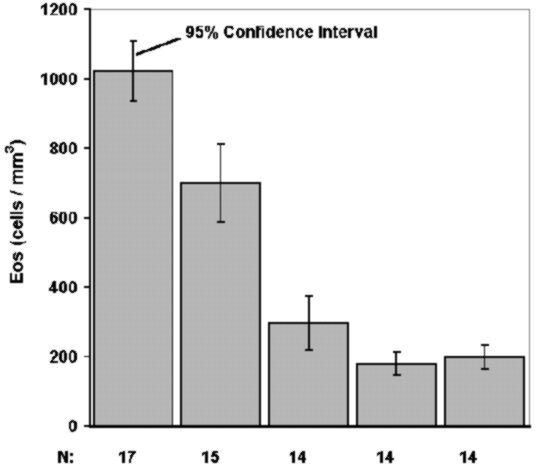
Genetic diversity in averages requiring complementary examination of further genetic diversity in variability as such and of diversities in time. Data on eosinophil counts (Eos) in five stocks of mice (from Halberg et al. J hematology 6: 832–837, 1951; cf. Proc Soc Exp Biol & Med 75: 844–847, 1950). Mice kept in L6-18D18-6. Sampling during fixed clock hours: 06:00 – 10:00. Concurrent study of additional stocks at the same fixed time of day reveals differences in mean value.
Figure 9.
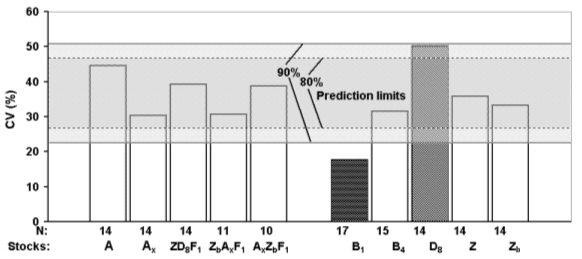
Genetic diversity in variability as such, gauged by coefficient of variation (CV). Beyond genetic diversity in averages of eosinophil counts in five stocks of mice (from Halberg et al. J Hematology 6: 832–837, 1951; cf. Proc Soc Exp Biol & med 75: 844–847, 1950). Mice kept in L6-18D18-6. Sampling during fixed clock hours: 06:00 – 10:00. Prediction limits, derived from first 5 stocks of mice, are exceeded when 5 additional stocks are examined (hatched). Of interest with the genetic diversity in space among different stocks of mice (Fig. 8) is a genetic diversity in the coefficient of variation.
Figure 10.
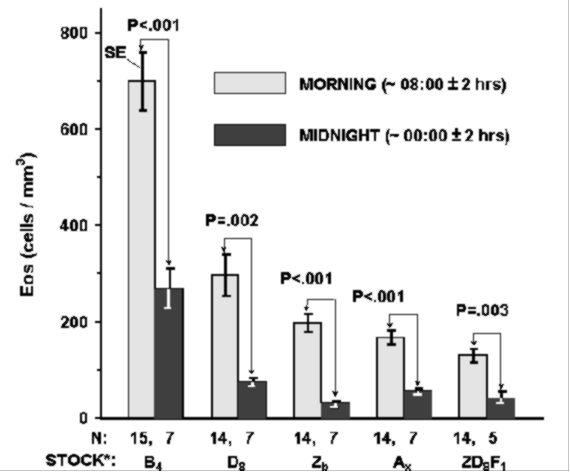
Circadian physiological variation in murine eosinophil counts (Eos). In four inbred strains and a hybrid (F1) stock (F Halberg and M Visscher. Proc Soc Exp Biol & med 75: 844–847, 1950). Note 1. Large genetic differences, gauged by one-way ANOVA across stocks at 08:00 (F=43.1; P < 0.001) and 00:00 (F=21.3; P < 0.001) representing differences in genome, and 2. Equally impressive diversity in time, in each stock, gauged by 08:00 vs. 00:00 difference, approximating, by only two timepoints, circadian component of chronome (t=11.3; P < 0.001 from paired t-test of relative 08:00 vs. 00:00 differences, expressed as percent of mean). The ever-present within-day difference can differ among stocks of mice.
Figure 11.
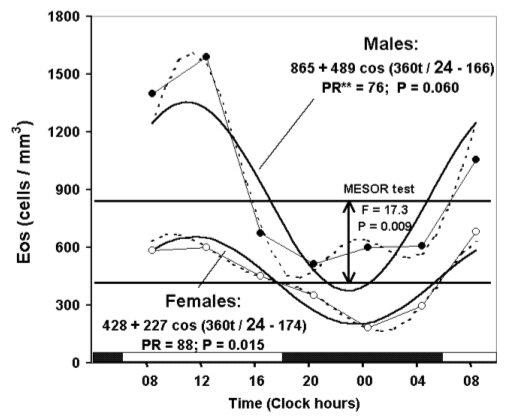
Sex difference in circadian rhythm of circulating eosinophil counts (Eos) of mature C57 subline 1 mice. Data on eosinophil counts (Halberg et al. Science 125: 73, 1957). PR = percentage rhythm (proportion of variance accounted for by fitted 24-hour cosine curve). Solid lines: one-component model; dashed lines: two-component model. Sex differences in MESOR found with attention to strain and rhythm.
I had to move since I was urged to use my return ticket to Austria and my one-year fellowship at Harvard was not renewed: I could not confirm an epinephrine test of adrenocortical function published for clinical use in an era before direct hormone assays were developed. Theoretically, epinephrine was believed to stimulate the hypothalamus, which secreted a substance stimulating pituitary ACTH secretion, which latter hormone (in turn) resulted in corticosteroid secretion. If the adrenal cortex was absent or deficient for whatever reason, such as atrophy or tuberculosis, an epinephrine injection should fail to depress the eosinophil count, since the critical adrenocortical hormone was missing from the patient with Addison's disease as a presumably indispensable step. The test worked for a number of senior visiting fellows, but not in my adrenalectomized mice, even after removal of all visible ectopic adrenocortical tissue on both sides of the spinal cord, including further the removal of the scrotal fat of male or of the large ligaments of female mice. In my hands only (and within a year in the hands of others), epinephrine considerably depressed the blood eosinophil count even after removal of the adrenal glands and adrenal cortex-like tissue elsewhere in the body. This result, at variance with those of others on the Harvard team was the first confrontation in my research, but hardly the last. In parting, my chief told me that he admired my "sticking to my guns" (these are the precise words I remember him saying), but it seemed unlikely to him that studies by others up to that time had to be re-examined.
The epinephrine test was reconsidered and eliminated within a year, thanks to work by others, but by then I was at the University of Minnesota. Maurice B. Visscher, then an opinion-leading physiologist (who had worked on a "law of the heart" with Ernest Starling, the coiner of "hormone") whom I had met while he was visiting Innsbruck, gave me an opportunity to continue work in his department there, which included a division of cancer biology headed by John J. Bittner (the discoverer of the first mammalian cancer virus). Thanks to John, plenty of inbred mice were available, which he had himself mated brother-to-sister for well over 20 successive generations. When John became George Chase Christian Professor of Cancer Biology at the University of Minnesota, he had the necessary staff and facilities to breed thousands of mice each week, shipped all over the world, and every so often I could use hundreds of mice that were left unshipped to others. The vast majority of the genes in each of these animals of a given inbred strain was assumed to be identical to those of its siblings. To my surprise, I found that when I handled the mice less, by using separate but comparable groups of inbred mice at different times each subjected to the "stress" of sampling but once, the cell count showed possibly even more variation than before.
Now, however, the pattern of eosinophil variation was predictable. The average number of these particular white cells would drop from high counts in the morning to low counts in the evening, Figs. 1,2,3,4,5,6,7,8,9,10,11. The count changed in one inbred strain, the C57 Black subline 1 (B1) from ~1,500 per cubic millimeter (mm3) of blood to less than 600, Fig. 9, and in another subline (B4) from ~700 ± 59 to much less (369 ± 42), and in still other strains from a few hundred cells per mm3 to less than 60 per mm3, Fig. 7. There was also a genetic difference, not only in mean count [33], but also in extent of change [34]. As I reduced the exposure to irregular stimuli bringing about variations, a regular underlying cycle was uncovered with its genetic aspects, Figs. 1,2,3,4,5,6,7,8,9,10,11. The eosinophil cell count of mice varied in an about 24-hour (or circadian) cycle that depended upon genetic make-up [32,34], Figs. 1,2,3,4,5,6,7,8,9,10,11, just as did the varying traits (smooth/wrinkled seeds, purple/white flowers, tall/short stalks) of Mendel's pea plants in Brno.
While I was in Boston, I formed a lifelong friendship with Fred Bartter, who became chief of the Hypertension-Endocrine Section and eventually director of the Clinical Center at the U.S. National Institutes of Health (NIH). Our cooperation is documented in 36 published titles, listed in my bibliography on my website http://www.msi.umn.edu/~halberg/.
Of course, neither the number of publications nor the fact that they include a Current Contents "Citation Classic" [35] counts, but only their content. The mathematician Carl Friedrich Gauss went so far as to ask for "much" (multum) while explaining that he did not want "many things" (multum sed non multa). He may be right about "much", but too restrictive with "not many things". An inventory of joint publications constitutes at least a numerical approximation, albeit never an objective measure, of the intensity of motivation spent in cooperation. The reader can only be led to sources and is invited to judge whether, for a given endeavor, the Gaussian ideal of much is met. In circadian mapping as for a broader chronobiology, and certainly for the transdisciplinary chronomics, one can strive for "much", yet must also try to do so in each of many things (multum etmulta), and for many people once health care as well as mathematics is involved. The condition "for many" may be met if Fred Bartter's suggestion that "information by cosinor should become a routine" [36] comes true, if thereby early changes, e.g., in the circadian amplitude of diastolic blood pressure are picked up with objective inferential statistical methods and lead to efficient treatment for preventing strokes and other severe diseases: prehabilitation. Gauss' emphasis may then be changed to "much for many", the promise of chronomics.
Many elevated risks in everyday physiology are silent to both the individual concerned and to current health care and hence awaiting chronomic surveillance for detection in as many people as possible. The prevention of a massive stroke can mean very much for the individual and for society that pays for the financial burden directly or by insurance premiums. The greatest promise of circadian systems is a better universal health care at less cost and, for science, much new information, Fig. 12. When a kind of time-unqualified, single-sample- "evidence"-based medicine (what a misnomer for an art) changes from spotchecks in trials for the masses to a universal continued, chronomically interpreted self-surveillance, chronomics will be the indispensable complement for genomics and vice versa, of course. In this context, the behavior of circadian systems will remain essential to detect alterations that are still reversible, a procedure for cardiovascular disease prevention as important as vaccination. Bartter [36], Levine [37] and I [38] might have overstated our case, but the story told with Henry Nash Smith is not new [39,40]. Without the evidence in Fig. 13,14,15,16,17, Theodore C. Janeway concluded a century ago [41]:
Figure 12.
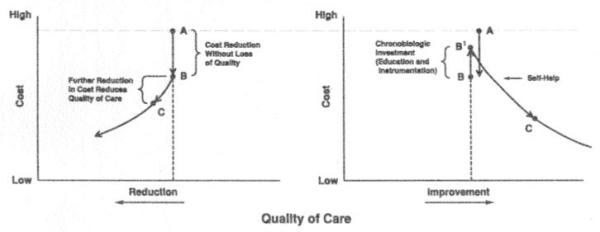
Cost and quality trade-offs (left) or instrumented self-help for health improvement (right) concerning blood pressure. Challenge to engineers, to civil servants dispensing government resources, and to each individual interested in self-help. Investment into physiological monitoring and education in chronobiology, to detect warning signs indicative of an elevated risk, rather than only of the fait accompli of disease, can prompt preventive intervention with the goal of avoiding the crippling of catastrophic diseases, also a major drain on financial resources. By placing added emphasis on prevention by general education in chronomic self-monitoring, health care costs could decrease while quality of care is individualized and improved [8,9].
Figure 13.
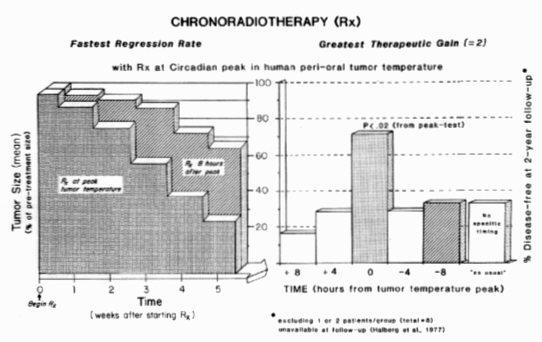
Clinical studies with timing by peak tumor temperature show faster regression and doubling of 2-year disease-free survival of patients with cancer of the oral cavity.
Figure 14.
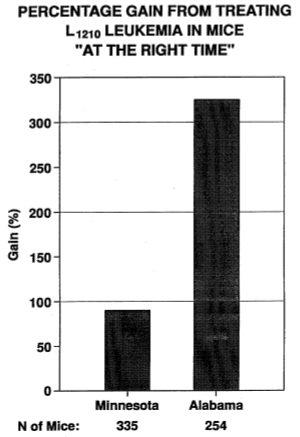
Gain in chronochemotherapy cures in the experimental laboratory in two different investigations [239-241].
Figure 15.
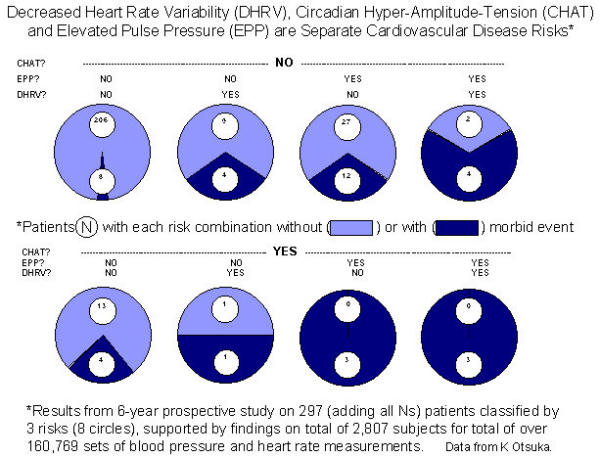
The incidence of morbidity among 121 normotensive and 176 treated hypertensive patients (so diagnosed by their time structure or chronome-adjusted mean, MESOR) with no cardiovascular disease at the outset is compared in a 6-year prospective study among patients presenting without or with 1, 2 or all 3 of 3 risks factors. The risk factors considered are:1. CHAT (brief for circadian hyper-amplitude-tension), a condition characterized by an excessive circadian amplitude of (diastolic) blood pressure (above the upper 95% prediction limit of clinically healthy peers of the same gender and a similar age);2. An elevated pulse pressure (EPP), defined as a difference between the MESORs of systolic and diastolic blood pressure above 60 mmHg; and 3. Decreased heart rate variability (DHRV), defined as a standard deviation of heart rate measurements at 15-min intervals for 48 hours in the lowest 7th percentile of the patient population. Risk was determined at the start of study, based on a 48-hour profile (acceptable for group studies only, one week's monitoring at 30-minute intervals being recommended for individuals) of automatic measurements of blood pressure and heart rate at 15-min intervals with an ambulatory monitor. Morbidity was checked about 6-monthly thereafter. Diagnoses considered were: coronary artery disease, cerebral ischemic events, nephropathy and retinopathy (related to blood pressure disorder). After 6 years, morbidity was diagnosed in 39 of the 297 patients. In the reference population of 214 patients presenting none of the 3 risk factors, morbidity was found in 8 cases (3.7%) (top left). The presence of DRHV or EPP alone raises the incidence of morbidity to 30.8% (top middle). When these two risks are both present, morbidity is doubled (66.7%) (top right). The presence of CHAT (bottom) invariably increases the incidence of morbidity, from 3.7% to 23.5% in the absence of the other two risk factors (bottom left), from 30.8% to 50% or 100% when either DHRV or EPP is also present (bottom middle), or from 66.7% to 100% when all 3 risk factors are present (bottom right). Except for a weak relation between pulse pressure and the standard deviation of heart rate, the 3 risk factors are mostly separate and additive. The results suggest the desirability to routinely assess blood pressure variability in addition to heart rate variability since even in MESOR-normotension, CHAT is associated with a statistically significant increase in cardiovascular disease risk (not shown) [8], and can be successfully treated [80]. Whereas the number of morbid events and the number of patients in this study are small, the results are supported by several other prospective and retrospective chronobiological investigations [8,38,78-82].
Figure 16.
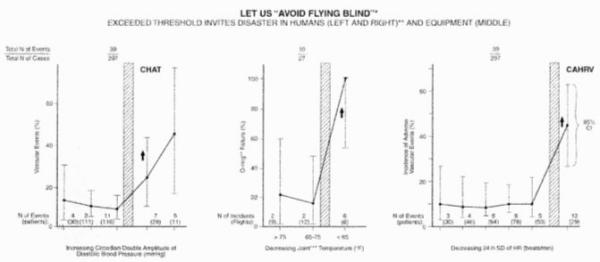
Disaster can result from literally and figuratively neglecting the range of operational environmental temperatures or in biology, the "normal range". For a relatively wide range of temperatures, a piece of equipment may be safe to use, but once temperature drops below a threshold, the likelihood of problems increases. The situation that led to the Challenger disaster (middle) is compared with the non-linear elevation of cardiovascular disease risk associated with a decreased heart rate variability (gauged by the standard deviation) (right) and also with an overswinging of blood pressure (CHAT) (left), also exhibiting a nonlinear behavior. Note that the increase in morbid events follows only after a threshold is exceeded, a nonlinear behavior that may have delayed the recognition of these risks. The use of chronomics is particularly indicated in populations at a high vascular disease risk.
Figure 17.
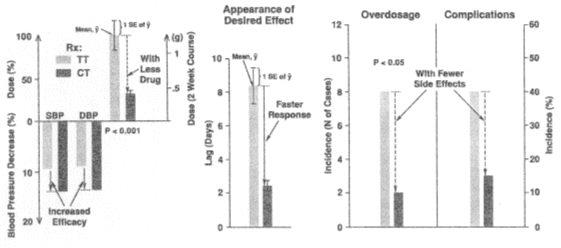
Efficacy, safety and cost-effectiveness of chronotherapy (CT) versus traditional therapy (TT) with propranolol. Twenty patients per group; hypotensive effect is more pronounced on CT (dark gray) than on TT (light gray) (P < 0.05); SBP: Systolic Blood Pressure; DBP: Diastolic Blood Pressure. Original studies by Rina Zaslavskaya on blood pressure chronotherapy compared with conventional treatment, eventually transferred from group studies with treatment at a fixed time in relation to the blood pressure acrophase, to individualized treatment optimized in the given patient with control by the monitored blood pressure analyzed as-one-goes by parameter tests and cumulative sums [80].
... it is essential that a record of the pressure be made at frequent intervals at some time previous [presumably to an examination], to establish the normal level and the extent of the periodic variations. When this is done, it may be possible to demonstrate changes of small extent, which, lacking this standard for comparison, would be considered within the limits of normal variation.
Now we have the monitors with a 90% reduction in the cost of their acquisition for all comers interested in self-help who care to write to http://corne001@umn.edu[42] and to acquire chronomic literacy. Attaining the goal of Janeway, Bartter and Levine is thereby greatly facilitated. But blood pressure literacy is just a step to universal chronobiological and chronomic literacy as the "hook" [39]. Right or wrong, the spirit of what we propose, is based on a parallel drawn from the history of universal "3-R" ("reading, 'riting and 'rithmetic") literacy in the USA to use education in chronomic self-help in health care [8,9], Fig. 12. As for science, Fig. 18 tries to tell the story by focus only upon the puzzles of the 1950s, with their implications for today and the future.
Figure 18.
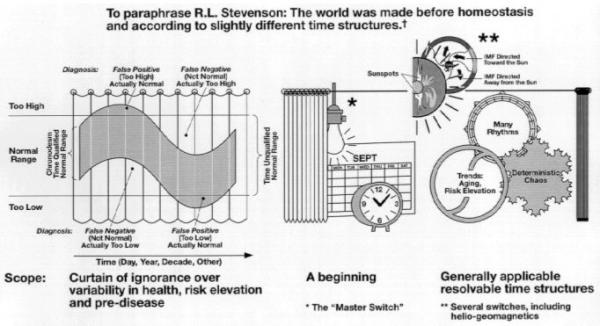
From homeostasis to clocks and chronomes. †Inferential statistical methods map chronomes as molecular biology maps genomes; biologic chronomes await resolution of their interactions in us and around us, e.g., with magnetic storms in the interplanetary magnetic field (IMF). The alignment of spectra – data transpositions from the time into the frequency domain of data series recorded on us and around us – has just begun and requires lifetime monitoring for critical variables that may provide the reference values for preventive health and environmental care. Homeostasis recognizes that physiological processes remain largely within relatively narrow (but hardly negligible) ranges in health and that departure from such normal ranges is associated with overt disease and still serves that purpose. But it can be improved upon in replacing time-unqualified ranges by time-varying reference limits as prediction and tolerance intervals (chronodesms). Most important, however, is that variability within the normal range is not dealt with as if it were random. The body strives for structured variation, not for "constancy". Learning about the rules of trends and further about rhythmic and chaotic variations that take place within the "usual value ranges" is not needed for the postulation of a "biological clock" that would enable the body to keep track of time. Not surprisingly, this restriction in the scope of chronobiology is most welcome to all of those who still wish no more than their normal ranges and usually only time-unspecified "baselines". The fact that single cells and bacteria are genetically coded for a spectrum of rhythmic variation indicates, however, that the concept of "clock" needs extension beyond the year as a calendar and beyond the beating trans-year, [8,171] and today beyond the recording in the experimental laboratory of lighting, temperature and feeding, among other obvious conditions. Magnetic storms must not be ignored [310-312]. There is a further need to extend focus beyond circadians. When the giant alga Acetabularia, a prominent model for scholars interested in the mechanism of a "clock", is placed into continuous light, after some days in light and darkness alternating every 12 hours (!), the spectrum of changes in its electrical potential reveals the largest amplitude for a component of about (no precisely!) 1 week rather than for one of about 24 hours. An Acetabularia population also shows a circadecadal rhythm [313]. The concept of a broad chronome takes the view that changes occurring within the usual value range resolvable as chronomes, with a predictable multifrequency rhythmic element, allow us to measure the essence of the dynamics of everyday life, and are essential to obtain warnings before the fait accompli of disease, Fig. 16 so that prophylactic measures can be instituted in a timely way.
After Fred Bartter and I met again at NIH in Bethesda, Fred set an example by around-the-clock measurements of his blood pressure for the rest of his life [43] and staunchly advocated a chronobiologic (now chronomic) interpretation of the record. He wrote about a patient who received different blood pressure diagnoses from two different physicians, one seen in the morning, the other in the afternoon:
By conventional standards, this patient is clearly normotensive every morning. But the blood pressure determined each day at 6 in the afternoon provides especially convincing evidence that this patient is a hypertensive. ... My plea today is that information contained in [data curves compiled under differing circumstances, such as 24 hours a day/7 days a week] become a routine minimal amount of information accepted for the description of a patient's blood pressure. The analysis of this information by cosinor should become a routine. It is essential that enough information be collected to allow objective characterization of a periodic phenomenon, to wit, an estimate of M [MESOR, a rhythm-adjusted mean] as given for the three statuses in this patient, an estimate of A [circadian amplitude] itself, and finally an estimate of acrophase. In this way, a patient can be compared with himself at another time, or under another treatment, and the patient can be compared with a normal or with another patient. [36]
Also taking around-the-clock measurements was another MESOR (midline-estimating statistic of rhythm)-hypertensive friend, Howard Levine [37], professor of medicine at the University of Connecticut. I had met Howard in Wels, Upper Austria, when he was a captain in the medical corps of a U.S. Army field hospital and I was in charge of an improvised hospital treating mostly patients with typhus. Together, we published 41 titles. I visited him the day before he died: despite his weakness from amyotrophic lateral sclerosis, Howard still completed sets of various self-measurements, as did Fred until his stroke, from which he died within about 10 days, as I learned from Catherine Delea, his right-hand colleague and a chronobiologist herself [44].
The major physician-friend who influenced my career was the late Agostino Carandente, whose only problem as head of the Hoechst Foundation in Italy was that he was too big for a national job, as Charles de Gaulle was too big a personality for postwar France. Agostino was ahead of his time in realizing the need for chairs, courses, meetings, journals, WHO contacts and a special laboratory for what was to be developed as chronopharmacology, chronotoxicology and chronotherapy [4-6,45]. My introduction to chronobiology is dedicated to him [15]; and he had the satisfaction of seeing his (and "my") daughter Franca hold the world's first chair in chronobiology, in Milan. With Franca, we published 90 titles. Our work with an antibiotic that also has immunomodulating properties still awaits use in the clinic. Agostino was responsible for the first drug to have built into its name the timing of its administration: Dutimelan 8 15, i.e., 8 am and 3 pm. I owe my acquaintance with Agostino to "carissimo" Norberto Montalbetti, with whom Germaine Cornélissen and I coined the term "chronome". Norberto represented chronobiologic laboratory medicine nationally and internationally at WHO at its best. His premature death was a great setback for chronomics, eventually carried forward with major contributions by Terukazu Kawasaki and Kuniaki Otsuka in Japan.
What led you to become involved in rhythms research?
Necessity, not choice. First, I encountered great variability as an assistant in medicine at the Brigham, and again across the street at Harvard, where I had been given a laboratory to develop, as already noted, a bioassay based on the depression by corticoids of counts of circulating eosinophil cells. In Minnesota, where I had a chance to continue work on the same topic thereafter, I could not confirm my own results, Figs. 1,2,3,4, until I solved the puzzles of opposite results that are sooner or later the inescapable finding at different clock-hours or weeks apart, whenever one unknowingly compares a group of animals with phase-shifted, Fig. 4, or one with phase-drifting (Figure 19 (IA)) rhythms, on the one hand, with a group that has the usual light-dark synchronized rhythm on the other hand [32]. This confusing situation applies to all rhythmic variables, whatever the period involved. Coping with variability led me to differing rhythms in inbred strains of mice [34]. The timing of rhythms and remove-and-replace approaches led me to a built-in adrenocortical cycle in humans [46] as well as in mice [34], that in turn led to free-runs [15,47,48] and thence to the ubiquity and critical importance of temporal organization [49,50].
Figure 19.
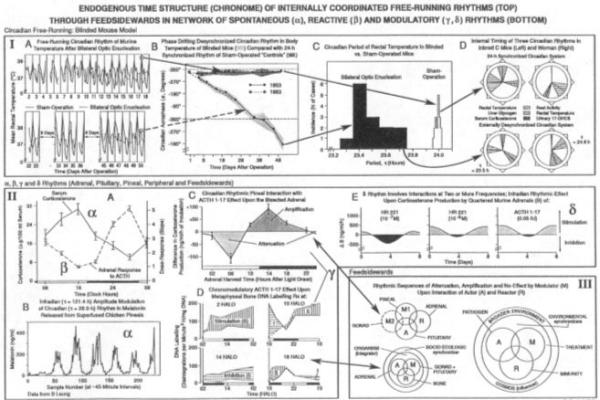
Endogenous time structure (chronome) of internally coordinated free-running rhythms (top) through feedsidewards in network of spontaneous (α), reactive (β) and modulatory (γ, δ) rhythms (bottom). Circadian desynchronization after blinding, seen time-macroscopically in IA, is also shown time-microscopically as a chronobiologic serial section in IB, as a summary of individual periodograms in IC, and as time relations among three variables at 24-h synchronized (top) or free-running (bottom) frequencies in mice (left) and a human (right) in ID. Section II shows a spontaneous rhythm in corticosterone (α), in antiphase with a reactive rhythm (β). The components of the chronome are internally coordinated through feedsidewards in a network of spontaneous (α), reactive (β) and modulatory (γ, δ) rhythms. For the case of circadians in experimental animal models (section I), some degree of endogenicity of a desynchronized rhythm was demonstrated, statistically validated and quantified by objective numerical characteristics given with their uncertainty. The role of the eyes as a transducer of the effect of the lighting regimen on the circadian variation emerged from studies in the blinded C mouse and the ZRD mouse born anophthalmic [48]. The slight but statistically significant deviation of the period from precisely 24 hours led to the concept of free-running, as an indirect test of some degree of endogenicity. The work started on eosinophil counts, Figs. 1,2,3,4,5,6,7,8,9,10,11, was complemented by measurements of rectal temperature which was more readily measured longitudinally for the lifespan of several generations of mice. Rhythms being a fundamental feature of life, found at all levels of organization, their coordinating role was also studied. Apart from the spontaneous rhythms characterizing variables such as serum corticosterone or melatonin (IIB), reactive rhythms are found in response to a given stimulus applied under standardized controlled conditions of a laboratory in vivo (α in IIA) or in vitro (β in IIA and IIC-E). A third entity such as melatonin may modulate, in a predictable insofar as rhythmic fashion, the effect of one entity upon the second, such as that of the pituitary upon the adrenal or may act directly upon the adrenal. Reproducible sequences of attenuation, no-effect, and amplification, the time-qualified feedsidewards, replacing time-unqualified feedbacks and feedforwards, can then be found (IIC to E).
When and why did you create the term "circadian"?
The first time I probably considered the term must have been when a dear friend (best man at my wedding), Henry Nash Smith, brought it up. In his time, Henry was rated by others as the foremost scholar in the field of American Studies; it must have been before 1951 when he left Minnesota for the English department at the University of California-Berkeley, where he eventually became head and editor of the Mark Twain Papers and literary executor of Twain's estate, and in 1969 served as national president of the Modern Language Association. Before he left, Henry polished the English on many of my early papers and would in fact have been a first, or at least a co-author on them had he allowed it. McKeen Cattell, the head of pharmacology at Cornell Medical School, was then editor of the Journal of Pharmacology and Experimental Therapeutics, where I submitted a paper with Henry's help [51]. Cattell knew me from when he had been a guest lecturer in Innsbruck, where I was an assistant to the dean, and had hosted me personally in New York after my arrival in the U.S. He accepted the paper on receipt, but it must have amused Henry greatly when Cattell added that I should consult someone conversant in English!
By the 1950s [34], I had found several kinds of differences among inbred mouse strains in counts of circulating blood eosinophils, namely in daily averages, and in extent of change within a day (Figs. 1,2,3,4,5,6,7,8,9,10,11). I had thus also learned about several already-noted puzzles [32] by the use of rectal temperature as a marker rhythm and the finding of periods that were one of the major reasons prompting the "circa" in "circadian": after blinding, rectal temperature showed an about (circa) 24-hour periodicity in each mouse, all happening to differ from precisely 24 hours, all happening in my hands (in the mouse, not in the rat) to be shorter than 24 hours and with the periods varying further among some of the mice themselves, Fig. 19. Another friend, Earl E. Bakken [52], the developer of the first implantable pacemaker for long-term use (and founder of the Medtronic company) [53], brought up the analogy of a free-running vs. 24-h synchronized oscillator, a master engineer's view of "circadian" vs. "dian" (Figs. 20 and 21).
Figure 20.
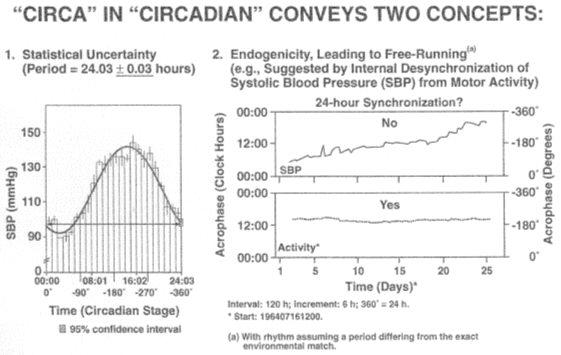
Terminology. "Circa" in "Circadian"."Diurnal" and "circadian" need not be used by us as synonyms. In our case, "diurnal" relates to the photofraction, and "circadian" means a cycle with a period of about 24 hours. Reasons for the use of "circa" in "circa-rhythms" include among several other considerations, inferential statistical uncertainties that qualify the estimate of period (top left), apart from a desynchronization (top right).
Figure 21.
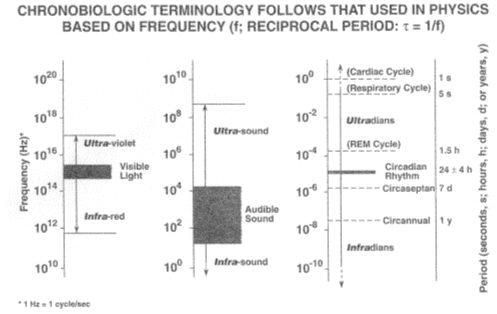
Terminology follows usage in physics. The broader division of biosphere spectra into 3 domains uses the circadian range of 1 cycle in 20–28 hours as a reference for frequencies (not periods!) higher (ultra) or lower (infra) than circadian, in keeping with precedents of nomenclature in physics.
Relatively early, I had become a member and later, for several decades, chairman of the nomenclature committees of the International Society for the Study of Biological Rhythms (now the International Society for Chronobiology), as well as being for decades the society's president [54], even though I resisted that invitation, urged by Arthur Jores, for many years. While batting for the society, nomenclature, designs, methods of sampling and analysis and popularization, notably in schools [9,10,55] then became my long-term concerns, as was and remains the development of standardized units to arrive at the equivalent of a metric system for spatio-temporal diversity, for what could turn out to be the ensemble of chronomics complementing genomics and vice versa [56]. I also served on a glossary committee of the International Union of Physiological Sciences (presumably nominated by Nathaniel Kleitman).
In Stockholm in 1955, I proposed "diel" and "dieloid" as terms intended to replace the ambiguous "diurnal", which was then confusingly used in health care to describe both the daylight hours (e.g., diurnal vs. nocturnal epilepsy or asthma) and the full 24-hour day. "Diel" was rejected with the argument, I believe it was from Frank A. Brown Jr, that its coiner from Harvard had not done meritorious work (I had only added "dieloid" to separate 24-hour synchronized from desynchronized rhythms). Eventually I reverted, for the same reason, to "circadian" and "dian" again [57], again with the intent to separate environmentally synchronized from free-running rhythms. At the time other committee members rightly objected to the use of two terms, which would create confusion since one would have had to document free-running by lengthy circadian studies before using the term, and not everybody could be persuaded to free-run in caves or in the laboratory before the proper term could be applied to one's rhythm, an overwhelming argument. References to the nomenclature of the time are discussed in reviews [35,57] and nomenclature used by us is defined in a glossary [58], and in encyclopedias of time [59], statistics [60], aging [61] and shift-work [62].
What were your major contributions to the study of circadian rhythms?
Whatever I tried to do rests on the discovery of hormones and many other contributions to the current invaluable body of physiological information. Otherwise, there would be no circadians and no chronobiology. We should all be particularly indebted to those who founded the study of life and health, whether by endocrinology and metabolism, the brain or a micro-organism [63,64]. These and earlier pioneers, up to and including me, as the endocrinologist with the "cosinor beast", as Jürgen Aschoff put it, are listed in a pictorial background to the field by Aschoff himself [65]. I am indebted to him for this genealogy, leading up to my contribution in the also-pictorial Capri [66-68] and elsewhere [69,70], and to Agostino Carandente for the settings he provided for courses that invariably led to many discussions Aschoff, Pittendrigh and Reinberg were invariably on top of my list of lecturers, even if Colin declined so of ten that eventually we had our meetings in Italy, bar one, without him.
Another bit of history is written in the context of a gallery of chronobiologists, which I began with Earl E. Bakken, the developer of the chronotherapeutic device par excellence, the cardiac pacemaker [52,53]. When asked to write such a gallery, which I plan to do should I live long enough to continue it, I wish to submit it to those concerned, a task which is no longer possible with the scholars selected by the editor, to my very sincere regret. The gallery started with Earl Bakken, also apart from the cardiac pacemaker, since for well over 50 years Earl has kept tabs on what we are doing and reviewed the evidence underlying an approach to diseases of civilization, my most urgent task [52]. I appreciate his help and that of others who kindly wrote succinctly [71], giving me a new forum to report on what we are doing. Some of the past is recorded by my wife Erna [72] and, in more detail, by my most appreciated co-worker and teacher Germaine Cornélissen [73] who has become the leader in what has developed into chronomics. Germaine's is perhaps the most extensive spelling out of what I tried to contribute, matched by biographical detail and comments by John Pauly and Lawrence Scheving [54]. What they all fail to mention is that others very often carried the lion's share, as did the innumerable past co-authors and current participants in the large-scale studies, replicated in the 1950s on the cell cycle and now in BIOCOS [56], with focus on the cosmos. With my first wife Erna, I shared 333 publications, and so far I have 95 titles with my second wife Othild.
I probably did more venipunctures on myself around the clock than most others; carried, with Erna, more rectal probes than others for years at a time (except for unavoidable removals) and had cuffs on my arm for years, second only to Erna and now to cardiologist Yoshihiko Watanabe. I also did more eosinophil counts on humans, mice, rats, monkeys, dogs and other species than most others in the past or present. Erna and others filled the counting chambers, e.g., during a full week when I bent sleeplessly over a microscope. (I had forgotten this until Dr. Dennis Lofstrom, while visiting, kindly reminded several of us, adding that I played tennis in between. Figuratively as well as literally, I tried to return every ball, and was University of Minnesota faculty champion in singles while playing figurative doubles with Erna and very many others who came to work with us.) During that sleepless week, Erna noticed, fortunately early, that we had counting chambers with two different depths, a non-periodic (purely artifactual) reason for a large variability; of course the more one focused on biological variability in its own right, the more the control of technical variability becomes essential, and vice versa. As on many other occasions, Erna's perspicacity saved the product of that week. In another case in Japan, her charm and down-to-earth personality mediated the successful implementation of an ambitious mapping of over two dozen clinical chemical variables on two continents.
My daughters Francine and Julia pulled their oar in 120 or 56 published titles, respectively. Both Francine and Julia had experience with several daily temperature and other psychophysiological self-measurements, Francine over 6 pertinent years, Julia over 4 years; they demonstrated among many other findings, very different individualized changes in relation to menarche [74,75]. As a family we traveled a great deal, always with research as our aim: often to Italy where Erna planned and then cared for a laboratory in L'Aquila; repeatedly all over India for the Smithsonian Institution; and repeatedly to Japan. In Chandigarh, India, Francine (then a high school student, now a radiation oncologist), Erna and I had an opportunity to plan a study with B.D. Gupta, implemented by Akhil Deka, using the peak in serial temperatures of accessible oral tumors as a marker for timing treatment. Thus, a first marker rhythm-guided tumor chronoradiotherapy doubled the 2-year disease-free survival rate of patients with advanced perioral cancers, Fig. 13[11,14]. The promise of chronochemotherapy is shown in Fig. 14[6].
My daughter Julia, now a physician specializing in occupational medicine with an MS in public health, also worked on a master's thesis in biology [12] with Phil Regal, the ecological chronobiologist at the University of Minnesota, another dear friend. Joined by her mother Erna, Julia measured the blood pressure of groups of ~40 spontaneously hypertensive stroke-prone Okamoto rats in 24-hour profiles repeated at intervals of months over the lifetimes of these animals. Since it took about 4 hours by tail sphygmomanometry after immobilization and heating under a gooseneck lamp to complete a measurement series on 40 rats, they were sleepless for 24 hours. They detected circadian hyper-amplitude-tension occurring transiently before an increase in the MESOR (chronome-adjusted mean), i.e., before MESOR-hypertension in the laboratory, as subsequently shown in humans by Yuji Kumagai [76], who also taught self-measurements to his two daughters Eureka and (no longer so "little") Erna, the latter the namesake of my late first wife (see Additional file: 1, Additional file: 2), Additional file: 3).
From there several steps led toward using the circadian amplitude of blood pressure as a risk marker in cooperation with Paolo Scarpelli, who introduced chronobiologically interpreted self-measurements into his routine clinical endeavors in Florence, Italy, with Max Halhuber in Germany and Japanese friends Teruo Omae, Terukazu Kawasaki and Keiko Uezono; Kohji Tamura and Yoshihiko Watanabe (see Additional file: 1, Additional file: 2, Additional file: 3). Kuniaki Otsuka, more than most, contributed critical data demonstrating a disease risk syndrome of an over-threshold blood pressure variability, an under-threshold heart rate variability, and an excessive pulse pressure as a group phenomenon, Figs. 15 and 16. Kuniaki extended his original research on a city-wide basis to individuals each monitored for a week up front (see Additional file: 2). From a clinical viewpoint, he started to meet the greatest challenge today: stroke prevention by 24-h/7-day blood pressure and heart rate monitoring for detection of changes in variability [8,38,77-80] and their treatment, Fig. 17[38,80-82]. He has now also started a similar city-wide project in a second location.
Concomitantly, another 24-h/7-day monitoring endeavor at St. Anna Hospital in Brno, Czech Republic (Mendel's home city), is being carried out by Pavel Homolka under the initiative of Jarmila Siegelova, Professor and Head of the Department of Functional Diagnostics and Rehabilitation at Masaryk University in Brno, and Bohumil Fiser, Head of the Institute of Physiology at Masaryk University and former Czech minister of health, now associated with WHO. Far beyond my personal family, I have been fortunate to have a broad international academic family. In this family, many members became independent, which is natural; others cooperated lifelong, and of course have my special recognition in a personal context [15,52,83,85,136]. A major lesson I learned is the merit of the inseparable activities in science and self-help in health care that can be an academic family affair today and perhaps a civic duty tomorrow [8].
Along with many other investigators, I started cartography in the mouse, Fig. 22; humans, Fig. 23[84,85]; and other species; we documented the amenability of circadians to phase-shifting at various levels of organization by manipulating lighting [86,87] and/or feeding in humans as in rodents [2,88]. In systematic studies, we learned about differences between advances of a circadian rhythm (which are usually slower than delays) and about polarity in such a way that in the same organism, some rhythms advanced while others delayed. In the laboratory, we were able to phase-shift a circadian rhythm in mitoses by studying the rodents for a sufficiently long time span and thus debunked the earlier view by others that mitotic rhythms cannot be phase-shifted [89]. Again at the cellular level, we phase-shifted circadians in RNA and DNA formation, in serum corticosterone and in susceptibility to audiogenic seizures. Different rates of phase-shifting [90] were found for liver glycogen in the first vs. the next 4 days following an abrupt change in lighting regimen and the rules of phase-shifting were mapped for circadians and only explored thus far for the much more slowly adjusting circaseptans that may be phase-shifted by 180° (after a transmeridian round-trip flight over 7 or more time zones). A transequatorial phase-shift of a circannual rhythm in the pre-trans-year era studied with the Marques family [314] awaits extension by a consideration of an even broader spectrum of intermodulating multifrequency rhythms.
Figure 22.
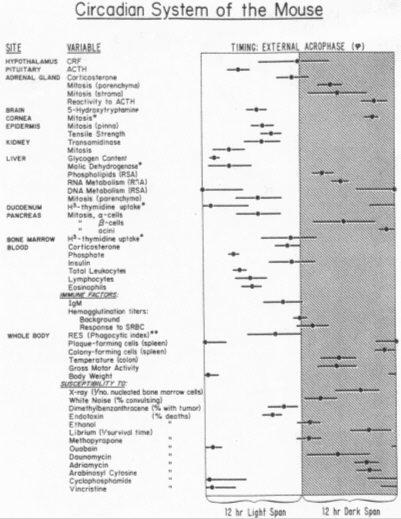
Partial acrophase chart of the circadian system in the mouse illustrates a sequence of physiological tasks among more than 50 variables mapped herein.
Figure 23.
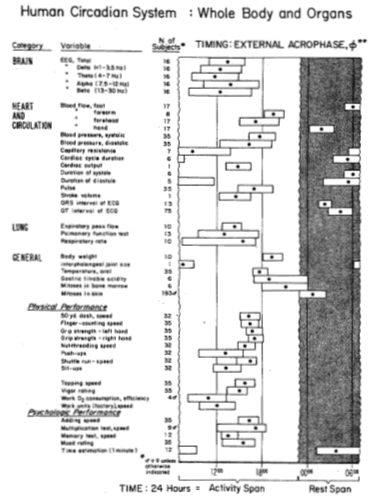
Partial acrophase chart reveals a relative synchronization of several aspects of human physiological and psychological performance.
A number of lifetime studies simulated shift-work on laboratory animals and a few studies of nearly yearly intercontinental flights complement circaseptan aspects of schedule shifts on insects with Dora K. Hayes and on Acetabularia with Hans-Georg Schweiger. These establish circaseptan aspects of circadian phase-shifting beyond a reasonable doubt, as does follow-up investigation by Mirian Marques, albeit the underlying mechanisms remain an unsolved, important puzzle. As many others did, we also studied circadians on mice kept in continuous darkness or continuous light, resulting, among others, in the persistence of a cell cycle, including rhythms in RNA and DNA formation [91]. The most impressive finding was that as a function superficially of clock-hour, the same physical stimulus, such as noise or whole-body irradiation or a drug, such as ouabain or many anticancer agents, or another chemical, or a bacteriological agent, such as alcohol or an endotoxin, respectively, would all have predictably (insofar as they are rhythmically) changing effects, as drastically different as survival vs. death, albeit only on a statistically (but not individually) highly significant basis. An individual dies just once, of course, but the point I am making is that we were dealing with differences in percent survival as a function of timing rather than with all or none responses. The context of these findings is described in puzzles, if not as paranoias, which is exactly what some were called at the time.
How does your work relate to that of other pioneers in the field?
My clinical work followed in the footsteps of Arthur Jores, who was for long the president of the International Society for the Study of Biological Rhythms as well as of the German Society for Internal Medicine and that for Endocrinology. I grew up with his textbook [92] and one by Henri Simonnet, who hosted me in Paris as a young man and led me to the pineal and, indirectly, to pineal feedsidewards, demonstrated by the indefatigable experimenter Salvador Sanchez de la Peña (Fig. 19). Jores fought what he called the "idiocy [Stumpfsinn] of 'three times a day'" [93], and wrote a critical review of the field in the 1930s [94] and hardly left a problem in chronomedicine untouched [93-114]. Werner Menzel, Jores' associate in chronomedicine, both in Hamburg, initiated curve-fitting, albeit without inferential statistical considerations, introduced a pump for clinical drug administration according to a preset schedule, and wrote a book on rhythms and shift-work, a source to the early literature [115], along with a book by Arne Sollberger [116]. These sources complement other books and the proceedings of other meetings [117-127].
In the perspective of the past half-century, I owe a great deal to Alexander Chizhevsky [128-132], whom I never met, whose hard data on a circadecadal rhythm in the incidence of cholera documented what he and Frank A. Brown Jr. independently called pervasive effects [133], albeit without inferential statistical time series analyses. In relation to sleep and other problems, Nathaniel Kleitman [134] was always supportive. He had monitored the physiology of his family, but unfortunately many of these records were lost. His daughter Esther Kleitman, however, provided us with self-measurements for many years, in which, among others, the new trans-year of human heart rate would be demonstrated. When Nathaniel turned 100 years of age, he offered to have his blood pressure and heart rate monitored for 24 hours. I felt that it was more important for his health to monitor for 7 days. He refused, and I lost out. I had re-used Kleitman's term "synchronizer", which was defined in the same way as Aschoff's subsequently defined Zeitgeber. Since both Aschoff and Pittendrigh had really spread, not only the word but also the concept of a self-sustaining oscillator much more than I would have done alone, it would have been only fair on my side to reciprocate. But all three of us redefined our terms, they a zeitgeber and I a synchronizer (as primary or secondary), respectively, as an external agent, usually a cycle that does not "give" time and merely synchronizes existing body time with its own (e.g., 12-hourly alternating light and darkness) schedule [48]. In discussing this view, I indeed referred to Aschoff's original demonstration and interpretation that "changes in length of cycle have been observed for the rhythm in bodily activities of rodents, kept in continuous darkness", i.e., that body time was rhythmic ("given") in the absence of a zeitgeber [48]. But he, like I, defined what could be called a Uhrzeit (clock-time) or Kalendarzeit (calendar-time) giver, whereas the internal time structure was given in the absence of the synchronizer. The use in chronobiology of "synchronizer" preceded that of the less ambiguous "entraining agent", a good synonym for "synchronizer". But why should we use two words instead of one, and in using "synchronizer", why not honor Nathaniel Kleitman? Brevity and ringing bells are the main criteria in coining terms.
Investigators coming to our laboratory included both medical and graduate students and accomplished scientists who became collaborators and are highly valued co-authors, including Kenneth Berge, Anand P. Chaudhry, Halvor Vermund and Ed Flink in the early 1950s, and thereafter Bernhard Arbogast, Brian Brockway, Franca Carandente, Yoshihiko Chiba, Gabriel Fernandes, Leopoldo Garcia Alonso, Mauricio Garcia Sainz, Denis Gubin, Erhard Haus, Ramon Hermida, Yuji Kumagai, Helmut Künkel, Francis Levi, Cristina Maggioni, Mirian and Nelson Marques, Norberto Montalbetti, Ana Portela, Alain Reinberg, Salvador Sanchez de la Peña, Kalva Shankaraiah, Michael Smolensky, Brunetto Tarquini, Zhengrong Wang, Yoshihiko Watanabe, Wu Jinyi and Rina Zaslavskaya, to mention just a few. I regard them all as my teachers, among many others who cooperated, sometimes with teams of their own, such as Teruo Omae with Terukazu Kawasaki and Keiko Uezono; Kohji Tamura, and in particular Kuniaki Otsuka, who co-initiated BIOCOS and a series of meetings with original focus on chronoastrobiology. Institutionally, Italy's Hoechst Foundation in Milan and the University of Florence, under the leadership of Mario Cagnoni, were homes away from home. We have a long-term relation with Theodor Hellbrügge, who singlehandedly built social pediatrics in Munich, and who sent us a long series of advanced medical students who wrote their MD theses in Minnesota [135,136]. A lifelong personal friendship with Theo culminated in a recent symposium on chronomics in child development [137].
With respect to the editor's specific questions concerning Curt Richter, Jürgen Aschoff and Colin Pittendrigh, I emphasize that we were complementary, although Colin, according to Cambrosio and Keating [138], fought the idea of chronobiology as a science in its own right. For these influential opinion leaders, and for Frank A. Brown Jr, Erwin Bünning, Arthur Jores, Nathaniel Kleitman and Gregory Pincus among other distinguished scholars, rhythms then and now were mainly phenomena to be displayed in the time domain, preferably by typical examples (time-macroscopically), a very convincing yet selective approach, missing, more often than not, even one, or usually all inferential statistical estimates of characteristics of the period, amplitude, acrophase and waveform involved. For me in turn, the t-test sufficed in 1950 [34] and the analysis of variance until 1953 [139], yet by 1954, in the case of longitudinal series, the periodogram became desirable [47,140,141], temporarily replaced by some too-conservative power spectra [142,143], soon replaced by cosinors, as prior information accumulated concerning the reproducibility of rhythmic change in a given aspect of a circadian system [144,145]. Resolution in the frequency (or period) and phase domains became indispensable as an essential, albeit most of the time complementary time-microscopy, even when the computation of a periodogram in the desk-calculator era of the 1950s took a week to complete and another week to check.
I had a lengthy conversation with Curt Richter only once, at a Cold Spring Harbor symposium in 1960, where he did not contribute a paper and did not accept as yet the proposition by most of us that there was a feature of endogenicity to circadians. I presented him with evidence about the extent of maintenance of an internal, albeit free-running structure, e.g., in time relations among rhythms in serum corticosterone and liver glycogen rhythms after blinding in mice and rest/activity, rectal temperature and urinary 17-hydroxycorticosteroid of humans in isolation from society, when the period synchronized is equated to 360°, Fig. 19 (ID) [15].
At that time, Richter had not yet discovered free-running in his rats. The rats I studied in continuous darkness had periods very close to 24 hours, in my hands usually 24.1–24.3 hours, lengthening with increased light intensity [146], in keeping with "Aschoff's rule" concerning rodents which Aschoff had earlier postulated and documented. After 1960, however, Curt Richter found free-running, as Colin Pittendrigh had earlier, and Aschoff before that [147]. It was my pleasure and privilege to fully support Richter's application for studies in chronobiology that I had to referee; he had made great scholarly contributions, already apart from chronobiology, again in our field, and he was a chronobiologist.
Incidentally, I supported all applications by scholars in the field of rhythms, whether or not their views differed from mine. Once when I chaired a site visit to a chronobiologist in New York, the late Dorothy Krieger, who also served on this visit, was astonished that I very strongly supported an applicant (who indeed received his support) who emphasized the merit of expressing time series as a percentage of the series mean [139]. Not only was the project not particularly novel or meritorious in her view or mine, but Krieger said that the applicant had nothing good to say about me. I thanked her and reminded her that the applicant was a chronobiologist after all, and in the land of the blind those with tunnel vision deserve support if they are to serve others.
I do not recall whether Jürgen Aschoff and I met before 1953, but we had several very friendly conversations that year at meetings of the International Society for the Study of Biological Rhythms in Basel [148] and thereafter of the German Physiological Society in Homburg/Saar [47]. We immediately "sent in the same frequency", but with different methods. At the latter meeting, I reported on free-running after blinding with periodograms. In the proceedings' discussion (Aussprache), Aschoff, as he invariably did in our relation when we met, wrote positively:
Halberg's investigations are so important because they are some of the very few experiments available at this time on the endocrine control of 24-hour periodicity ... that consider to a sufficient extent the possible effects of disturbance and have led for the first time to clear results.
(Halbergs Untersuchungen sind deswegen so wichtig, weil sie unter den wenigen bisher vorliegenden Experimenten zur endokrinen Steuerung der 24 Std-Periodik (siehe Lewis-Wright) die möglichen Störeinflüsse genügend berücksichtigen und zum ersten Mal zu klaren Ergebnissen führten.) [47]
As Aschoff and I conversed afterward, Albrecht Bethe, then the grand old man of German physiology, who had worked on the cardiac cycle, walked past. He said a few polite words to me, then turned to Aschoff and pointed out that his (Aschoff's) name had not been on the program. With his ready wit, Aschoff riposted that he had not been aware that cycles with a frequency lower than that of the pulse and respiration (Bethe's concerns) had become acceptable (salonfähig) in German physiology. Subsequently, Aschoff did as much as, if not more than anybody else to achieve this goal.
My wife Erna and I were delighted to have Aschoff and his wife as our house guests in Minnesota, I presume in the early 1950s. Later, my daughter Julia and I were pleased when Jürgen picked us up at the Munich airport in his nightshirt. We enjoyed his subsequent hospitality, I repeatedly on other occasions as well. It was a pleasure to have him regularly at our meetings in L'Aquila, Italy, as a guest of the Hoechst Foundation, which gave me a laboratory in L'Aquila and the journal Chronobiologia for two decades. Jürgen and I had both separately reinterpreted Johnson's data [149] as free-running, albeit Jürgen viewed them time-macroscopically while I preferred time-microscopy and laid primary emphasis on the genetic differences among inbred strains of mice, Figs. 1,2,3,4,5,6,7,8,9,10,11. We both interpreted documented free-running as an important tool, just as Colin Pittendrigh and Erwin Bünning did subsequently, albeit with a lag of some years. When Erwin Bünning visited Minnesota, we showed him Fig. 24, and he was also surprised to see the great difference in phase. We hosted each other in Tübingen and Minneapolis. When I was Bünning's guest and he gave a party for me, I requested that he show me his laboratory. He insisted that we wait until all the guests had departed; we then went to his lab, unannounced in the early morning hours, and found someone active in each room. Bünning certainly knew how to motivate his students!
Figure 24.
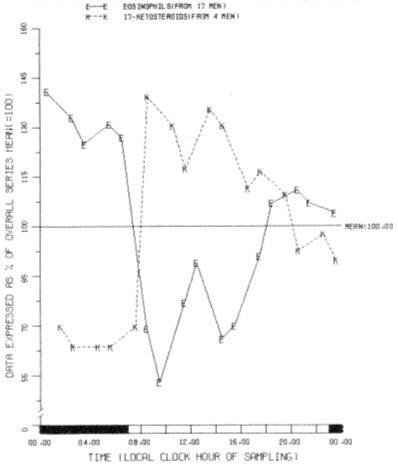
Cyclic adrenocortical activation in humans. The cyclic adrenocortical activation in humans, shown by a decrease in counts of circulating blood eosinophil cells occurring before awakening (endogenous eosinopenia), leads in phase the increase along the 24-hour scale in the excretion of breakdown products of steroidal hormones (17-ketosteroids) following awakening. The adrenal activation as an event in the sleep stage of a circadian system may be compared as a critical event to ovulation in the ovarian cycle. Ovulation prepares for the start of an entire new life; adrenal activation teleonomically prepares for a new day in life [46,88].
At a meeting in Pittendrigh's home to which Colin had invited Jürgen and me in Princeton, they advocated the importance of clocks as a way to interest the public in what we did. I favored a ubiquitous, critically important time structure that could be the subject of a new science. Of course, I had enthusiastically cited Johnson's "exceptionally substantial and durable self-winding and self-regulating physiological clock" in 1953 [46,149], for the case of the adrenal cortex, my first clock, still critical albeit no master clock. The adrenocortical cycle naturally led to the pituitary and the hypothalamus by studies in vivo and in vitro [85,150-152], not as a dictator – the sole head of an up-down hierarchical axis – but as a link in a democratic collateral hierarchy, which included, with the pineal-hypothalamic-pituitary-adrenal and broader neuroendocrine and paracrine network, an "oscillator" in each cell (49). Feedsidewards qualified in time were postulated for this network first in relation to a 3-way pineal/pituitary/adrenal interaction along the circadian scale [85,152] and were extended to the circaseptan scale [15], Fig. 19 (IIE) to replace time-unqualified feedbacks and feedforwards that acted as gods from a machine, without consideration of external and/or internal cycles. There was a sequence of time-varying effects ranging from stimulation, over no-effect, to the inhibition of corticosterone production by melatonin, as a function of timing, Fig. 19 (IIC). Feedsidewards also characterized the effect of ACTH upon DNA labelling, Fig. 19 (IID). Eventually, I encountered the ubiquity of circadian mechanisms beyond an adrenal clock and the importance of the circadians in tipping the scale between life and death for the body as a whole. To me, circadian systems, for which I subsequently organized a Ross Pediatric Conference [153], were much broader in scope than timekeeping. Mechanisms underlying diversity in time complement genetic diversity in space. A spatio-temporal view of the BIOsphere and the COSmos is the inescapable conclusion of the accumulating chronobiological evidence [56].
Aschoff was aware of the ever broadening scope of time structures and had the term in the title of a broad and scholarly review of rhythms with different frequencies in different physiological systems [154]. Again, we were complementary since I endeavored to tease out many frequencies in one and the same variable, notably in 17-KS to start [16,155] and thereafter in many other variables [56] (see Figs. 25,26,27,28,29,30,31,32,33 for the prominence of the biological week over circadians in the human newborn but not in adulthood for the case of blood pressure and heart rate). Aschoff was much more than a clock-watcher (again honi soit qui mal y pense), but he did not use the inferential statistical tools that are needed to map some of the less prominent structures time-microscopically. May the following summarize my attitude toward him: Many of the participants at a meeting on "Circadian Clocks" [156] went to the Andechs brewery near Aschoff's institute in Erling-Andechs for a drink and a meal. The late Josef Rutenfranz (a collaborator of the active Theodor Hellbrügge) was sitting next to me. We and many others saw Aschoff accosted by two rowdies. I asked Rutenfranz whether the incident was to be taken seriously. Rutenfranz said it could indeed be serious and was a common occurrence in breweries. Although Aschoff was great in wit and had an imposing voice, he was physically small, and I believe I was the only person there who went to help him. The incident proved to be a joke after all, with the "troublemakers" (unknown to me and Rutenfranz for sure) being two of Aschoff's non-professional employees in his institute.
Figure 25.
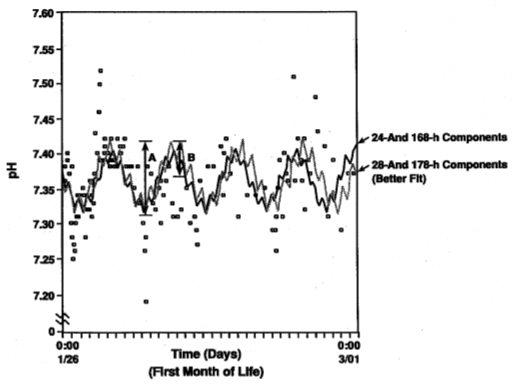
Circadian and circaseptan variation in preterm baby's blood pH. As compared to babies at term, prematures routinely monitored longitudinally have provided conclusive data; infradian, notably ~7-day (circaseptan) components in the circulation have an amplitude often larger than the circadians, as illustrated in this figure for blood pH of a very premature boy, JK, born in the 27th gestational week (who was monitored in the hospital for the first 26 months of his extrauterine life) [175]. Values for blood pH during the first five weeks are shown as quadrangles. Two curves are fitted to these data. The lighter curve, representing a model including a 28- and a 178-hour component, fits the data numerically better than the continuous curve corresponding to a model consisting of a precise 1-day and a 7-day component, a finding in keeping with the assumption of built-in free-running circadian and circaseptan rhythms. In this graph, the circadian is represented by the smaller ripples superimposed on the (nearly five) near-weekly cycles of much larger amplitude recurring with a period slightly longer than 7 days. But with either curve-fit, the greater prominence of the circaseptan vs. the circadian amplitude is readily seen. The circaseptan can predominate over the circadian, in humans for the first few weeks of extrauterine life, in a boy born at term, as shown in Figs. 26,27,28,29,30,31, with gliding spectral windows, each presented in two views, to introduce a new fact for circadian scholars and a method applicable further with emphasis also primarily on the circadian and ultradian spectral domains in Fig. 33. Also shown elsewhere [175] are least-squares spectra of 5 consecutive spans, each of about 4 months, showing changes in the development of a spectrum of rhythms. In the first 120 days of very preterm extrauterine life, the peaks corresponding to frequencies lower than 1 cycle/28 hours (infradians) predominate over any circadians, i.e., components with 1 cycle in 20–28 hours also shown elsewhere [175]. The circadian and circasemidian components are expressed by the time of birth, but are free-running and unstable, with a very low amplitude, as compared to circaseptan, circatrigintan (about 30-day) and other infradian components [175].
Figure 26.
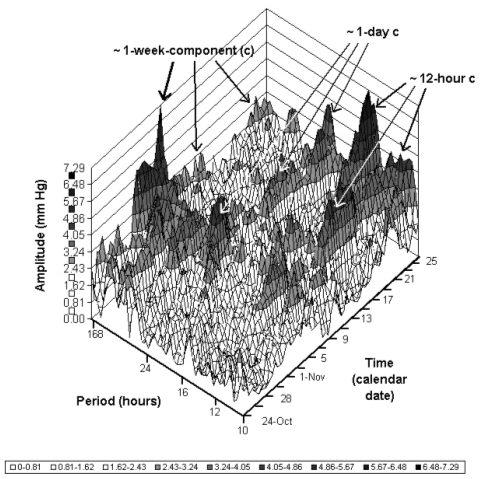
Changing amplitude of some components in a partial spectral element of the postnatal human systolic blood pressure chronome. Data from a healthy boy, born 19.10.1992, whose blood pressure was measured at mostly 30-minute intervals from 20.10 for the ensuing 40 days, and analyzed as a moving spectrum in separate weekly intervals, displaced in 12-hour increments through the data set. An initially greater prominence of infradians (see ~1 week c, left), shown by height and darker shading, corresponding to a larger amplitude, contrasts with the prominence of circadians and circasemidians in later weeks of life, while any ultradians with still higher frequencies and any trends and chaos, two other chronome elements, are here unassessed. Side view of a gliding spectral window of amplitudes of systolic blood pressure, focusing on infradians and circadians in the first 40 days of life of a boy born at term (FW). The prominence of the infradian spectral components immediately after birth is apparent from shading, height and arrows. In this side view, better than in a view from the top (Figs. 27, 29 and 31), a general impression is best gained of the time course of a gradual resurgence of a circadian component. The circadian is demonstrable on the day of birth as a group phenomenon (not shown herein). The circadian seems to be lost in this graph and the following graphs in Figs. 27,28,29,30,31,32 with the interval of one week used for analysis. Original data of Yoshihiko Watanabe.
Figure 27.
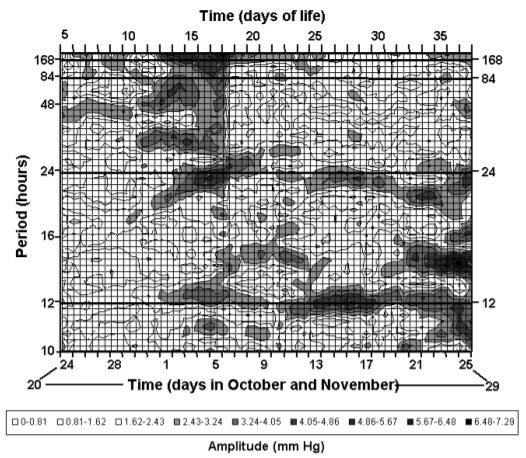
Changing amplitude of some components in a partial spectral element of the postnatal human systolic blood pressure chronome. Data from a healthy boy, born 19.10.1992, whose blood pressure was measured at mostly 30-minute intervals from 20.10 for the ensuing 40 days, and analyzed as a moving spectrum in separate weekly intervals, displaced in 12-hour increments through the data set. An initially greater prominence of infradians, shown by darker shading, corresponding to a larger amplitude, contrasts with the prominence of circadians and circasemidians in later weeks of life, while any ultradians with still higher frequencies and any trends and chaos, two other chronome elements, are here unassessed. View from the top, surface chart (or contour map) of a gliding spectral window of amplitudes of systolic blood pressure, focusing on infradians and circadians in the first 40 days of life of a boy born at term (FW). The prominence of the infradian spectral components immediately after birth is apparent from shading [165,166]. The change in shading observed around November 5 is an artefact related to a gap in the data collection. Original data of Yoshihiko Watanabe.
Figure 28.
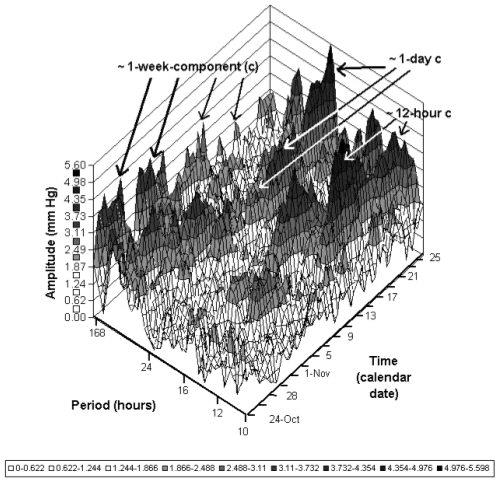
Changing amplitude of some components in a partial spectral element of the postnatal human diastolic blood pressure chronome. Data from a healthy boy, born 19.10.1992, whose blood pressure was measured at mostly 30-minute intervals from 20.10 for the ensuing 40 days, and analyzed as a moving spectrum in separate weekly intervals, displaced in 12-hour increments through the data set. An initially greater prominence of infradians (see ~1 week c, left), shown by height and shading, corresponding to a larger amplitude, contrasts with the prominence of circadians and circasemidians in later weeks of life, while any ultradians with still higher frequencies and any trends and chaos, two other chronome elements, are here unassessed. Gliding spectral window of amplitudes of diastolic blood pressure, focusing on infradians and circadians (side view) in the first 40 days of life of a boy born at term (FW). The prominence of the infradian spectral components immediately after birth is apparent from shading, height and arrows [165,166]. Original data of Yoshihiko Watanabe.
Figure 29.
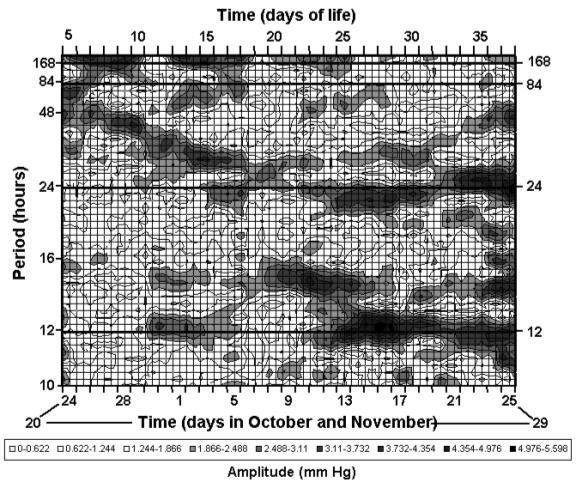
Changing amplitude of some components in a partial spectral element of the postnatal human diastolic blood pressure chronome. Data from a healthy boy, born 19.10.1992, whose blood pressure was measured at mostly 30-minute intervals from 20.10 for the ensuing 40 days, and analyzed as a moving spectrum in separate weekly intervals, displaced in 12-hour increments through the data set. An initially greater prominence of infradians, shown by darker shading, corresponding to a larger amplitude, contrasts with the prominence of circadians and circasemidians in later weeks of life, while any ultradians with still higher frequencies and any trends and chaos, two other chronome elements, are here unassessed. Gliding spectral window of amplitudes of diastolic blood pressure, focusing on infradians and circadians (view from the top; surface chart) in the first 40 days of life of a boy born at term (FW). Prominence of the infradian spectral components immediately after birth is apparent from shading [165,166]. The change in shading observed around November 5 is an artefact related to a gap in the data collection. Original data of Yoshihiko Watanabe.
Figure 30.
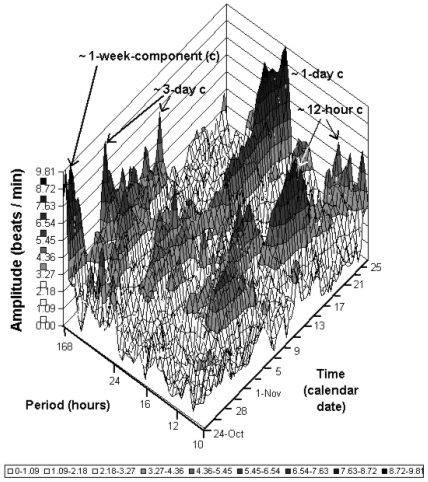
Changing amplitude of some components in a partial spectral element of the postnatal human heart rate chronome. Data from a healthy boy, born 19.10.1992, whose heart rate was measured at mostly 30-minute intervals from 20.10 for the ensuing 40 days, and analyzed as a moving spectrum in separate weekly intervals, displaced in 12-hour increments through the data set. An initially greater prominence of infradians (see ~1 week c, left), shown by height and shading, corresponding to a larger amplitude, contrasts with the prominence of circadians and circasemidians in later weeks of life, while any ultradians with still higher frequencies and any trends and chaos, two other chronome elements, are here unassessed. Gliding spectral window of amplitudes of heart rate, focusing on infradians and circadians (side view) in the first 40 days of life of a boy born at term (FW). Prominence of infradian spectral components immediately after birth is apparent from shading, height and arrows [165,166]. Original data of Yoshihiko Watanabe.
Figure 31.
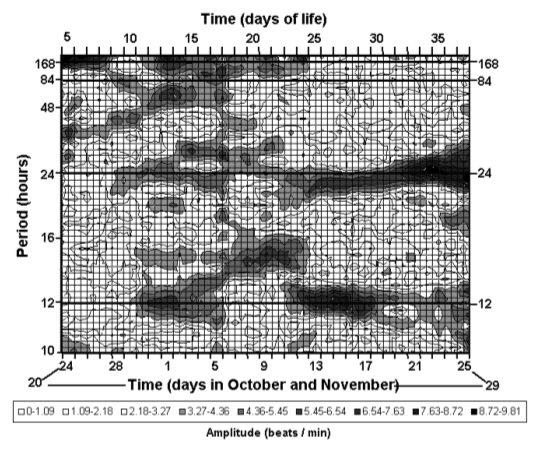
Changing amplitude of some components in a partial spectral element of the postnatal human heart rate chronome. Data from a healthy boy, born 19.10.1992, whose heart rate was measured at mostly 30-minute intervals from 20.10 for the ensuing 40 days, and analyzed as a gliding special window in separate weekly intervals, displaced in 12-hour increments through the data set. An initially greater prominence of infradians, shown by darker shading, corresponding to a larger amplitude, contrasts with the prominence of circadians and circasemidians in later weeks of life, while any ultradians with still higher frequencies and any trends and chaos, two other chronome elements, are here unassessed. Gliding spectral window of amplitudes of heart rate, focusing on infradians and circadians (view from the top; surface chart) in the first 40 days of life of a boy born at term (FW). The prominence of the infradian spectral components immediately after birth is apparent from shading [165,166]. The change in shading observed around November 5 is an artefact related to a gap in the data collection. Original data of Yoshihiko Watanabe.
Figure 32.
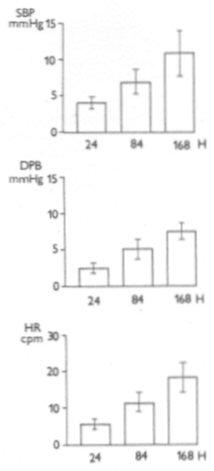
Infradian over circadian prominence of blood pressure and heart rate in early extrauterine life. Comparison of amplitudes of circadian (left), circasemiseptan (middle) and circaseptan (right) components of systolic blood pressure (top), diastolic blood pressure (middle) and heart rate (bottom) of groups of babies studied during the first few weeks of life in Brno, Czech Republic. Infradians are more prominent than circadians. Original data from Brno of Jarmila Siegelova [167], in keeping with data from Florence [164], Minneapolis, Moscow and elsewhere [168,15].
Figure 33.
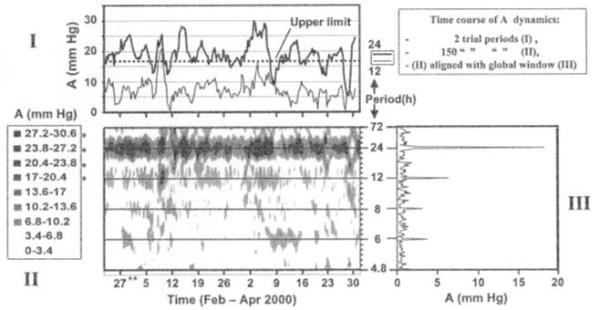
Gliding amplitude (A) in spectral window (I, II) shows relative prominence of spectral components, mostly intermittent CHAT, with occasional ultradian prominence. I – Amplitudogram, showing 24-h and 12-h amplitudes (solid lines) and upper limit for 24-h amplitude (dotted horizontal line). II – Gliding window of the time series (interval 28 h, increment 8 h, harmonic increment 0.1); shading of A values begins at P-value ≤ 0.05. III – Global spectral window of time series. CHAT: Circadian Hyper-Amplitude-Tension (upper 4 shadings of A from 24-h fit). **Sundays. During a 2-month section of a 5-year record of half-hourly automatically recorded blood pressures, the circadian rhythm in a human adult male is most prominent (as seen only toward the end of the first month of life in data of healthy neonates born at term or prematurely, Figs. 25,26,27,28,29,30,31,32[164].
I also appreciated that Aschoff advised Fred Sargent to send Michael Smolensky to me, as he sent his own medical disciple Jürgen Kriebl. I regret that my letter failed to persuade Aschoff to come to Minnesota for a blood pressure and heart rate variability profile; but I tried, as I did with others, e.g., Gunther Hildebrandt, Nathaniel Kleitman and Hans-Georg Schweiger. The offer to all interested parties of a 1-week profiling of blood pressure and heart rate, now extended by Germaine Cornélissen http://corne001@umn.edu, still stands as long as we can afford it.
Colin Pittendrigh was the clock-watcher par excellence, as he emphasized himself by the title of the summary of his life's work in the Annual Reviews of Physiology [157]. The field owes him a great deal, and hence and for other reasons, so do I, although some sociologists saw us as antagonists [138]. Our positions were very different: he was a powerful dean, on a number of important committees, while I had lost my laboratory over several of my puzzles. The development of temperature and other telemetry in the service of circadian systems might have been delayed for years had he not advocated with Woody Hastings and others that I might represent chronobiology in the task of preparations for a NASA Biosatellite study of free-running rhythms in extraterrestrial space [146]. While our experiment never led to a flight, that project resulted in much quantitative technical information, notably on the persistence of the temperature rhythm and other variables after the histologically validated ablation of the SCN, Figs 34 and 35. I enjoyed the opportunities to contribute to Colin's and Jürgen's meetings, and very greatly regretted that Colin came (with Jürgen) to only one of those meetings in Italy that I was asked to organize in the 1950s. To my particular regret, both Jürgen and Colin did not attend
Figure 34.
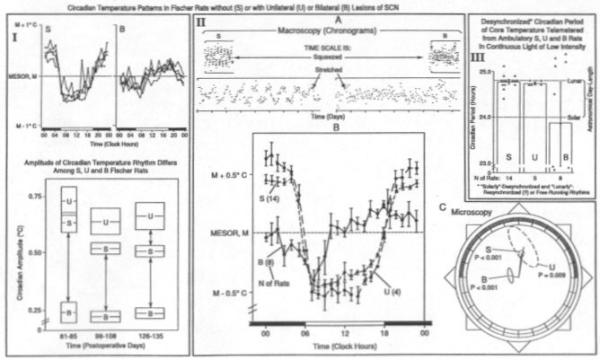
Circadian rhythm alteration rather than obliteration after lesioning of suprachiasmatic nuclei (SCN). By eyeballing alone of Section IIA, the circadian rhythm in telemetered core temperature, each measurement shown by a dot, is clearly seen in data from a sham-operated control on the left and seems to be lost in the rat with a SCN lesion on the right of this section, whether one examines squeezed values in the top row or stretched values in the second row (of dots). A circadian rhythm in temperature for individual animals is also displayed in Section I top, with a smaller within-day change of lesioned animals (IB) as compared to controls (IA). This finding is also seen after averaging in Section IIB (bottom). Microscopy, in section IIC, apart from quantifying the rhythm by cosinor, reveals, by a shorter arrow, a great amplitude lowering after a bilateral SCN ablation and a phase advancement seen as an earlier vector. Section IIC also validates the persisting rhythm by the non-overlap of the center (or pole) of the graph, by the error ellipse representing a 95% confidence region: the removal of the SCN is compatible with the persistence of a statistically highly significant circadian rhythm in core temperature quantified with its parameters and their uncertainties, after histologically validated bilateral SCN ablation. When the ablation unintentionally, as discovered at post-mortem, was unilateral (U), the circadian amplitude was enhanced (Section I, bottom), a finding suggesting a subtractive coupling between the two SCN. Section III is in keeping with the speculation of an effect by lunar factors upon the "free-running" (or rather lunar?) period of about 24.8 hours found in controls or unilaterally ablated animals at that light intensity. If this should be in part a lunar effect, it is lost in animals subjected to bilateral (B) suprachiasmatic lesions and apparently tightened by unilateral (U) lesions, a possibility requiring further experimental scrutiny.
Figure 35.
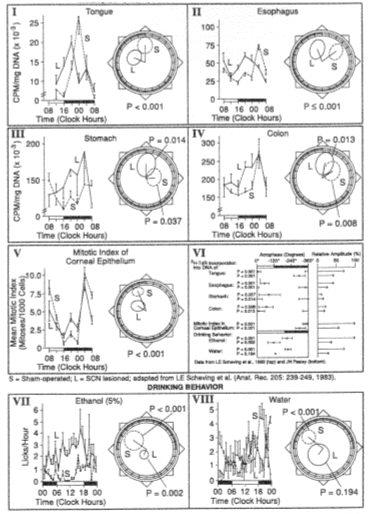
Persistent, albeit altered, circadian rhythmicity of 3H-TdR incorporation into DNA of different organs and of mitotic index of corneal epithelium of BD2F1 female mice after bilateral lesioning of suprachiasmatic nuclei (SCN) (rows 1–3); persistence of altered rhythm seen in ethanol (row 4; left) but not water (row 4; right) consumption after bilateral lesioning. Data from JN Pasley (Advances in Chronobiology. JE Pauly and LE Scheving, eds. Alan R Liss, Inc. New York, Part B, pp 467–471, 1987). The SCN coordinates a collateral hierarchy that can be quantified in terms of amplitude and phase: the major effect of bilateral SCN ablation is thus far invariably, comparably to the behavior of core temperature in Fig. 34, an advance in phase for the SCN-lesioned (L) animals in 8 cases out of 8, with a reduction in amplitude, except for DNA labelling in the stomach and colon, which may respond to food directly rather than by the SCN, Section III. Section VI shows a microscopic phase and amplitude chart summarizing the finding in the other sections (I-V, VII and VIII). This chart extends the scope of the lesson learned in Fig. 34 to a number of variables other than core temperature, studied as marker rhythm: rather than being a master clock leading to the loss of all rhythms when ablated bilaterally, the SCN is compatible with the rhythm's persistence in several of the variables investigated, except for water-drinking blood pressure and locomotor activity [201]. A subjective time-macroscopic interpretation-based impression, that led to the master clock illusion is replaced by the objective quantification of a mechanism for period, phase and amplitude in a network [15].
... the "First International Conference on Theoretical Physics and Biology" – a meeting held at Versailles in 1968 in the presence of several Nobel prize winners, and under the patronage of the French Ministry of State for Scientific Research and Atomic and Spatial Questions and the International Union of Pure and Applied Physics. [138,307]
Jürgen and Colin were invited, as was I, to elaborate on "the theoretical niche that chronobiology would occupy within a disciplinary topography" [138]. At the time, for them, chronobiology was premature, as it is today for too many. The reader must decide from the accumulating evidence whether this view is correct, whether apart from biological time measurement there is a much broader basic science and whether in practice we should continue to rehabilitate or try to pre-habilitate. The difference in viewpoints prompted me to place Jürgen and Colin invariably atop my list of those to be invited in the 1960s. I recognized them as masters of time-macroscopy, which is the safeguard of time-microscopists.
Colin was the best man at the wedding of John Tukey, a major statistician. Christopher (Kit) Bingham, then a young statistician and Tukey's colleague, advised and served Colin on data analyses (half of Kit's salary as a research associate in biology came from Colin's budget). Colin and Kit had no joint publications; according to Kit, there are indeed many cases when no statistics are necessary, and Colin had some splendid examples of phase drifts where this conclusion seems justified. Inferential statistical procedures were not conspicuous in Colin's and Jürgen's publications.
While for long Colin fought chronobiology, he came to realize its merits and, notwithstanding his former negative attitude, published the aforementioned phase chart; at least this is how I would like to view his publishing my Figure 13[157]. Be that as it may, in original data on over 50 variables, one cannot concomitantly explore any time relations at a given single frequency with the naked eye in original data. The phase chart at the circadian frequency allows this with estimated uncertainties. Furthermore, there are now ways to look again at time-varying phase synchronizations at multiple frequencies, as documented by the late Dr. Barbara Schack [169], findings that the unaided eye cannot follow in original data. In using Figure 13, Colin set an example toward unity. This is a reason to dedicate this paper to him and the other time-macroscopists, whether they were clock-watchers or cosmos-watchers. In them, the field has lost eloquent and powerful advocates. I trust that by this invitation, the editor-in-chief follows Colin's example with his call for unity.
Both time-macroscopy and time-microscopy are essential, actually indispensable, when both are feasible [158-168]. But certain things, whether a bacterium or a virus in space, because of their size, and for decades, "some" microbial circadians, in time, perhaps because of noisy data, cannot be scrutinized by the naked eye. There is a second point as a plea for unity in this computer age. Even for special problems in science, e.g., of biological timing, one benefits from computing an amplitude, even without a phase, or vice versa; preferably one benefits from uncertainties of all parameters, including the period and the MESOR. In many cases, an arithmetic mean is simpler, but on a computer the difference in computing time is negligible. Computing the MESOR however allows a self-measuring chronobiologist to ascertain the statistical significance of a drug effect [80] when because of a larger standard deviation the computation of an arithmetic average fails to achieve this goal (see Supplementary file 3). Moreover, accounting for rhythms, which leads to the computation of a MESOR, provides the even more important dividends of an amplitude and acrophase and one or both of these may provide information, e.g., on aging, when the MESOR or average do not [309]. In any event, estimates of uncertainties are recommended, preferably with a period estimate, also given in the new millennium with its uncertainty. Reliance solely on time-macroscopy, however, will eventually have to become unacceptable in health care, without an estimate of uncertainties. In medicine, one also cannot tell a case that s/he is not a "good" patient, as there are good and bad (rogue) experimental animals. The "rogues" in health care also have to be diagnosed and treated if need be. For everyday practice rhythmometry, with generally applicable methods yielding comparable characteristics, for which one establishes chronobiologic reference values, will become indispensable. We agreed with Colin and Jürgen that one can and should pick one's theme in research to dispense, if possible, with time series analyses. We beg to differ, however, when confronted with a statistical causality as a major feature of life.
Many roads lead to circadian clocks; what the naked eye can see, in very extensive data, is invaluable, albeit this is perhaps currently overemphasized. Nonetheless, there is benefit from time-macroscopy if whatever time series analyses suggest, in a frequency or phase domain, or in dealing with probabilistic chaos applications, can be reviewed again in the time domain. Both Aschoff and Pittendrigh established time-macroscopic schools. I would have loved to have more encounters with Jürgen, Colin and Frank Brown, as the latter actually wished. All three did much to popularize the field also by debates over long spans between Frank and Colin via newspapers.
The list of those who actually contributed to my endeavors about cycles is long. I remain indebted to all of them, above all to my co-authors, young and old, who became my teachers.
What is your view of the future of the study of circadian rhythms?
As automatic monitoring becomes state of the science (not art) by virtue of as-one-goes analyses, circadian systems will become essential components of an ever-broadening spatio-temporal atlas, which, however, will have to contain many other components of biological variability. All of the intermodulating rhythms are subject to feedsidewards, but this is a broad theme for another day [15,85,158,159] as is phase-shifting and its relation to shift-work in a broader-than-circadian perspective. Future scholars of rhythms in the context of developmental [160,161] and other trends and deterministic chaos will introduce further rules into the genetic aspects of changes in the otherwise neglected normal range of physiology as soon as appropriately dense and long time series become available. Twin research started in the womb should be promising. Instrumentation for resolving chronomes longitudinally will become more generally and affordably available and will allow the quantification of characteristics of circadian rhythms as components of chronomes so that they will be utilized across disciplines from biology to physics and with a view of interactions between the BIOsphere and its COSmos, the former an open system to the latter. Organisms may be particularly sensitive radiation detectors.
Circadian amplitudes already provide early warnings in the field of blood pressure. We can resolve variability to our advantage, to prevent a stroke by heeding those early warnings that may be etiologically important, as the available results suggest, Figs. 15 and 16[162], Additional file: 1 and Additional file: 2. Phases of marker rhythms can be used for optimizing the treatment of blood pressure, Fig. 17, and cancer, Fig. 13, as just two examples. But circadian rhythms need not stand alone, since for endothelin-1 (ET-1) they can come, Fig. 36, and go, Fig. 37, drastically changing their characteristic frequency. It does not help to call this fact "secularity". Instead, we confront the task to clarify any influence of any infradian components in a broad spectrum of rhythms covering frequencies over 10 orders of magnitude in the biosphere and much more in its cosmoi. Circadecadal cycles can be explored to determine whether they may contribute to some circadians, such as that in ET-1, changing to a major ~8-hour and an ~84-hour periodicity in ET-1 and even in the population density of the cells producing ET-1 (Fig. 38). Certainly, the relation of circadians, and circaseptans in the circulation has to be studied concurrently when circaseptans overshadow circadians, as they do in the babies' circulation, Figs. 25,26,27,28,29,30,31,32[15,163-168]. Much lower frequency components characterize babies' growth, an aspect of a budding chronoastrobiology [159].
Figure 36.
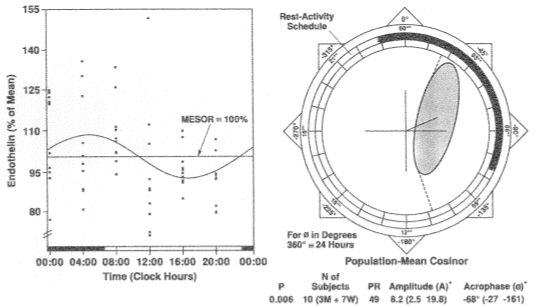
Circadian rhythm of plasma endothelin in clinical health. Data expressed as a percentage of each data series mean; analysis on original data (in pmol/ml) yields P=0.010; MESOR ± SE = 2.68 ± 0.11; A (95% CI) =0.23 (0.06; 0.54). Demonstration of circadian rhythm in endothelin-1 for the first 10 subjects investigated [286] in keeping with earlier work [286] but not with a follow-up [287-289].
Figure 37.
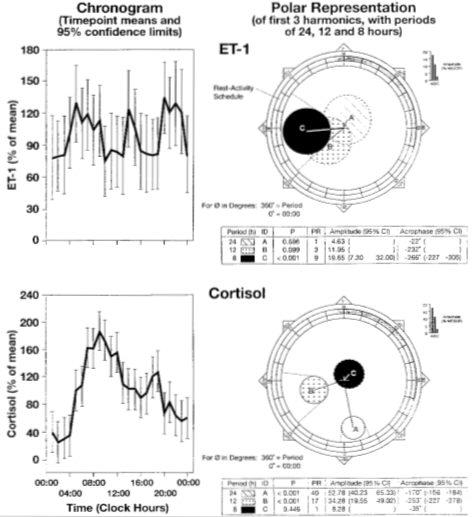
Coexisting 8-hour and 24-hour patterns in the same circulation. Circaoctohoran endothelin-1 (ET-1) versus circadian cortisol in 7 clinically healthy students. 2 women and 7 men, 22–27 years of age; note that 8-hour component (c) is most significant for ET-1 (P < 0.001) but it is not detected for cortisol (P > 0.4). Only an about 8-hour (circaoctohoran) group rhythm and no circadian variation characterizes the variability of circulating endothelin-1 in clinically healthy medical students in the presence of a circadian rhythm in circulating cortisol [289].
Figure 38.
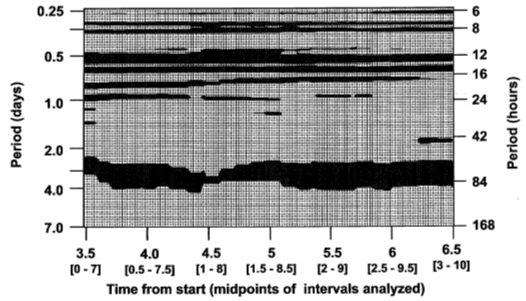
Ultradians, including an about-8-hourly component, and a prominent about-half-weekly wobbly band characterize the population density of endotheliocytes. Endotheliocytes in pinnal connective tissue – revealed by gliding spectral window periodogram as a contour map with consecutive 7-day intervals, displaced in 0.5-hour increments through a 10-day span of 3-hourly counts, made on presumably undisturbed C57B1 mice, before application of a trauma. Extension of circaoctohoran and 3.5-day (circasemiseptan) components in the endothelin-1 spectrum of the human circulation to the population density of murine endotheliocytes, the cells producing endothelin-1 (but not to the population density of other cells in the same ear pinna, not shown) [290].
References to clocks and oscillators are important and useful analogies and have been very largely responsible for calling attention to the field. By contrast, P-values and confidence intervals, spectra and cross-spectra, time-invariant and time-varying coherences or phase synchronizations all checked by subtraction and addition (remove-and-replace approaches) have not yet achieved the same popularity. Quantified relations among spectra, however, are the promise of the future, revealing relations at many more than one or even two frequencies in illustrative data analyses already completed for the future by Bärbel Schack [169]. Every day, oscillator theories and models or concepts can open new perspectives for new techniques [169], as Earl Bakken's free-running analogy did well over half a century ago [52]. But those analogies are not enough, even when they can lead to useful computer programs; they are the scaffolding which is useful to build houses but not to move into them. We need the necessary pacemakers not only for rehabilitation but for pre-habilitation [162].
I would defeat my attempt herein to bring unity to this field, and the same purpose of the inviting editor, if I did not try to explain why a broader-than-circadian mapping often becomes indispensable, right now and will be more and more helpful much more often in the future. Among biological variations that have obvious near-matches outside us, beyond the day, there is also the year [170] and now the trans-year of about 1.3 years [8,171]. The trans-year, so-called because it is somewhat (and statistically significantly) longer than the calendar year, with 95% confidence intervals in biological and physical variables examined thus far that cover neither the 1-year nor the 2-year period length, characterizes the human circulation: we find it in each blood pressure and heart rate series, covering 5 years or much longer spans available to us thus far (N>>12). The trans-year is a component of the least squares spectrum of the incidence of mortality from myocardial infarctions in Minnesota for the past 29 years, although, in this case, its amplitude is smaller than that of the circannual spectral peak; in other cases, the transannual can have the larger amplitude, as compared to the circannual.
The transannual is presumably a near-match (a signature) of Richardson's ~1.3–1.6-year feature of the largely unseen changes that occur in the speed of the stream from the sun into space of ionized gas, called the solar wind [172]. The solar wind is composed of hydrogen and helium nuclei and traces of heavier ions, accelerated to supersonic speed in the solar corona, and streams outward at a "typical" velocity of 400 km/sec-1 [173]. The solar wind changes speed with the Hale bipolarity cycle of sunspots of about 21 years, the Schwabe cycle of about 10.5 years, and the solar rotation period of perhaps 27 days, and along a more rapid time scale including occasional near-7-day components, also found in helio- and geo-magnetism [174,175]. Changes studied by us thus far in solar wind speed and in many interacting helio-geophysical, notably magnetic variables, have trans-yearly spectral components with 95% confidence intervals that do not cover a precise 1-year period [8,171]. Moreover, solar wind speed has no added precise yearly component, as does the earth with its changes from winter to summer, albeit it has a prominent circasemiannual spectral peak. Any photic, thermic or other, e.g., social effect now and/or in the past associated with the year and the solar wind's trans-year may beat, i.e., these two components' contributions may be added when their cycles are in phase and may cancel each other when out of phase, depending further on whether they originate from within, from without and perhaps from both, the ever-interacting organism and the environments near and far.
Beyond the biological day, year and trans-year, there is also (e.g., in the incidence of herpes or of aphthous ulcers of the mouth) a biomedical half-year [175,176]. There are circadecadal and circamultidecadal biospheric variations in the human circulation in health and disease [56]. Topping it, the week is another feature of the biosphere, longer known even than circadians [15-19,56]. A signature of the sunspot cycle of about 10.5 years in economics was found by Clarke in 1838 [315], the same year in which Schwabe published pertinent data but did not yet refer to a periodicity [316], as he did some years later [182]. Kondratieff described an about 50-year cycle in economics [317] again before we found this cycle length in strokes in the Czech Republic [318], as well as in Minnesota [56]. There is indeed the possibility that signatures of non-photic and photic environmental rhythms are coded in the population. The new millennium, however, will have the methods for transdisciplinary investigation that need not rely on correlations fraught with well-known dangers. Much less unspecific time-varying as well as global cross-spectral coherences and phase synchronizations are invaluable additions to the investigators of tomorrow [169].
Like circadians in 1950, circaseptans today are labeled "controversial" to some, so described in print [177], and "all nurture, not nature" to particularly expressive authors [178,179], notwithstanding the demonstration of free-running circaseptans for over 18 weeks [180], for over 38 weeks [181], and in an original case for over 156 weeks (Fig. 7 in ref. [16]). In the latter case, a study of urinary 17-ketosteroid excretion (17-KS), one may wish to have circadians in focus, notably if what we encounter may well be a time-macroscopically most prominent circadian rhythm shown in the time domain [46] dominating over the second highest circadecadal peak in the 17-KS spectrum (presumably the signature of one of the cycles in solar activity [155,182]. But a neglect of the about 10-year signature, in this steroidal hormone metabolite excretion, in 17-KS, can lead to unjustified hormone substitution therapy (Fig. 6 in ref [155]).
The neglect of circaseptans and circadecadals became particularly embarrassing to me in studies of the neonatal circulation [163,183,184]. An institutional review board limited friends and me to a "circadian study" of neonatal blood pressure and heart rate in healthy babies. We were allowed half-hourly measurements for only 48 hours, even though we had information available on prominent circaseptans from prematures, who are closely monitored out of necessity rather than choice for months, not only days. For several years, it seemed that an inference concerning vascular disease risk could be drawn on a circadian study basis. A statistically significantly larger circadian amplitude of neonatal blood pressure was found in babies with a positive as compared to babies with a negative family history of high blood pressure and/or other vascular disease [183]. This result seemed to be solid and was clinically interesting (Fig. 16a in [163]); it was corroborated for a large number of babies in years of a minimum in solar activity but did not apply thereafter in the ascending stage of solar activity [163,184]. Such data need not end up in the wastebasket of "secularity".
Instead of circadians, however, in the circulation early in extrauterine life, the circaseptans deserve major focus [15,163,164]. When the data obtained during different 2-day sections of the first week are pieced together, one finds an about 7-day feature with an amplitude much larger than that of any circadian (Fig. 16c in reference [163]), an impression which is in keeping with the blood pH of a premature boy (JK), Fig. 25 [175]. When eventually longitudinal data became available for the first 6 weeks of life on the circulation of a healthy boy born at term (FW), we find again prominent infradians in the first weeks of life [165,166], Figs. 26,27,28,29,30,31. An about 24-hour component, which can be demonstrated transversely on the first day of life, only gradually approximates by its amplitude that of an about-weekly component. JK and FW are the rule not the exception, Fig. 32[15,163-168,175], whereas the opposite is true in the adult, Fig. 33. Today the importance of circaseptans in medicine is well apparent from inferentially analyzed morbidity and mortality statistics [185], complementing the time-macroscopic, most impressive data of Hobart Reimann [117] and Curt Richter [118]. Circaseptan patterns can be so interesting that one professor of medicine married his female patient, the better to study her more thoroughly [117].
We are dealing with more than statistics in the incidence of various diseases and mortality therefrom. For cancer prevention, it is pertinent that the circaseptan and circadian pattern of drug administration can make quite a drastic difference in the outcome of pre-treatment with an immunomodulator [186]: a week's treatment with lentinan in equal daily doses accelerates, while a sinusoidally varying dose schedule, in the same total dose/week, inhibits the growth of a subsequently implanted immunocytoma, Fig. 39. For those focusing on eukaryotic unicells, Fig. 40 may be an eye-opener. In the electrical potential of Acetabularia acetabulum, kept previously in light and darkness alternating every 12 hours, the single stimulus of release into continuous light, that carries no 7-day information, is associated with a large time-macroscopic circaseptan while the circadian rhythm constitutes only a small ripple in the time structure of a unicellular organism [187], presumably on earth for the past 500 million years [188]. In such basic, Fig. 40, and applied, Fig. 39, circaseptan results lies the challenge of writing a few pages from a professional biography in the new millennium, keeping in mind that the emphasis should be on the circadian rhythms of half a century ago, while knowing that rhythms with many other frequencies interact in qualifying our circadian physiology from bacteria to humans. The current situation resembles that in the late 1940s with respect to circadians. Indices of adrenal function were determined without consideration of any changes along the 24-hour scale. Today, circadian changes are too often investigated without consideration of other cyclicities with shorter and/or longer periods.
Figure 39.
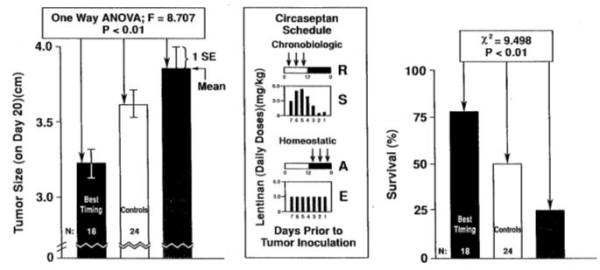
Harm or help: With or without chronobiologic patterning, the same total dose per week of Lentinan inhibits or enhances malignant growth, respectively, as compared to saline-treated controls. Key: treatment during active (A) or rest (R) span with sinusoidal weekly pattern (S) or equal daily doses (E) (P < 0.01). Difference in size corresponds to 50% difference in survival time; N = number of animals. Therapeutic optimization by timing drug administration according to biologic week and day. Timing treatment (with a sinusoidally changing vs. a fixed daily dose schedule with the same total dose per week) according to the biological week and preferably by the broader chronome can contribute to the difference between the inhibition or stimulation of a subsequently implanted malignant growth [186].
Figure 40.
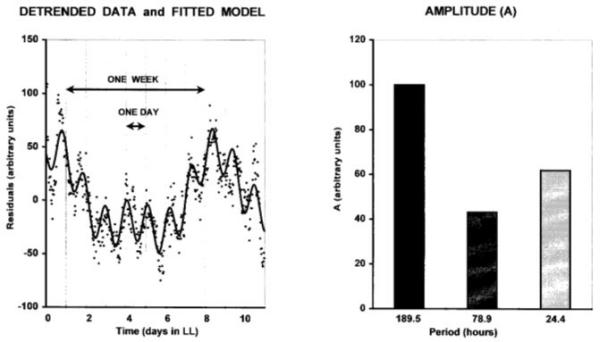
Larger about-weekly than about-daily cycle in electrical potential of a unicellular alga (Acetabularia Acetabulum evolved 500 million years ago). Nonlinear spectral analysis on signal averaged data from 20 single cells, released (zero time) into continuous light (LL), after prior standardization in light and darkness alternating at 12-hour intervals (LD12:12) for up to one week. Total number of observations: 38,578; experimental span: 376 days. Note a more prominent amplitude (A) for a component with a period near a week thanks the As of the about daily and about half-weekly components (all free-running). The circaseptan A is equated to 100 and the other As are expressed as percentage of the circaseptan. Meta-analyzed data of Dr Sigrid Berger, Dr Lübbo von Lindern and the late Dr Hans-Georg Schweiger. The about-7-day (circaseptan) component is more prominent than the circadian rhythm in the electrical potential of a eukaryotic unicell released into continuous light after prior exposure to a light-dark schedule alternating at 12-hour intervals [187]. Models such as Acetabularia may help to better understand circaseptan and circadecadal components (both demonstrated for Acetabularia) and still broader chronome organization. Along with even older cyanobacteria that also show circaseptans [15], Acetabularia may serve to explore the origins of life, another topic of inquiry into the chronomes of our evolution and even into the chronomes of our cosmoi in the broadest sense for which organisms can serve as transdisciplinary radiation detectors. Acetabularia [292], like air bacteria and staphylococci [293], also serves as a laboratory model for circadecadal rhythms.
Circadians have become an important, but still very limited aspect of chronobiology, the much broader science of biospheric diversity in time. This science matches in importance the genetic concern about biological diversity in space. This is the indispensable framework of any Minnesota autobiography, proposing that while genetics has spawned genomics, the circadians of the 1950s, upon which we gladly focus [34], have led chronobiologists eventually to the mapping of chaos [77,189,190] and of developmental [160,161] and other aging [155] trends, preferably in the context of rhythms [191-193]. Once we sample with sufficient density and length, chaos, trends and rhythms constitute inseparable computational features or elements of chronomes (time structures; from chronos, time, and nomos, rule, Fig. 41) in and around us. There is a need for chronomics, i.e., a mapping of time structures that include much more than circadians in us and that interact with chronomes outside us far beyond the patterns of lighting and feeding regimens.
Figure 41.
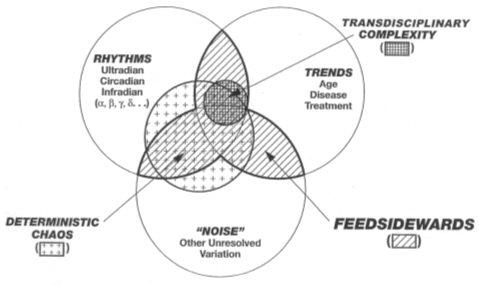
Measurable time structure (chronome) of a variable. The chronome (derived from chronos, time, and nomos, rule) represents quantitatively the measurable time structure of any variable, biological or environmental. In biology only, the ending "-ome" can also stand for "chromosome", to convey the genetic basis of (habitat- and broader cosmos-influenced) multifrequency rhythms, which are the major elements of chronomes, along with developmental and other age trends, and chaos, all interacting as feedsidewards among different frequencies in us and in our environment.
By mapping the spectral element of chronomics, we mean an inferential statistical resolution of multiple spectral components, each approached by hypothesis testing, preferably but not invariably before parameter estimation. Parameters can be given with the uncertainties involved, given preferably as 95% confidence intervals (CIs) for each period in the evaluable spectrum. At each period, CIs are preferred for the amplitude or acrophase for single or multiple component fits and remain to be sought for the composite (multiple component) model's magnitude and orthophase. Cartography is particularly needed for uncovering relations among time series by cross-spectral time-invariant and now time-varying coherences and phase synchronizations [169] as well as by remove-and (when possible) replace approaches of the adrenal [86,88,148,194], of the eyes [47,48], of half of the cerebral cortex [195], of the brain above the pons [196] and of the suprachiasmatic nuclei (SCN) [15,197-202], and by the solar wind, by the "spontaneous" removal and replacement of one or another of its spectral components [15,171,203].
Molecular biology need not continue to rely on a pseudo-functional genomics based only on the quicksand of time-unqualified averages and normal ranges of the blood pressure or of any other variable and (only) on deviations outside that range. This is why genomics focuses of necessity upon after-the-fact disease rather than upon everyday physiology and the recognition of risk. Genomics has much to gain if it is guided by the maps of dynamic characteristics in health and by the earliest deviations within the normal range as a function of disease risk elevation of endpoints of chronomes. To start, genomics could use the objectively estimated characteristics of circadians, even without immediate focus as yet upon other components in the spectrum of periodicities anchored in the genome. But eventually we have to pay attention to the resonances with the spectrum of periodicities in the environment, that brought circadians and other cycles into the genome in the first place. A magnetic storm [56,175,310-312] can override the synchronizing effects of both lighting and feeding [2,3].
The following eleven Puzzles in Minnesotan Endeavors help convey my feelings about the importance of a chronomic initiative:
Puzzle #1: Not a mere stress response but a preparatory built-in adrenocortical cycle
At the midpoint of the twentieth century, endocrinology was dominated by the opinion leaders in stress and endocrine research, Hans Selye and Gregory Pincus (the latter subsequently the discoverer of the contraceptive pill). Pincus deserves credit for discovering the large within-day changes in 17-ketosteroid excretion [204] that were fully confirmed in Minnesota by the group of Ancel Keys, Fig. 24, among very many others. Pincus interpreted this rhythm as reactive to motor and other activity, as originally did Selye. Rhythms were then epiphenomena; hence my first task was to remove stress as much as possible to test the possibility that adrenocortical and other periodicity was likely also anchored in part in the genome, as an alternative to Pavlov's behaviorism for whom rhythms had been "conditioned reflexes", as they were for Kleitman, yet for the latter with the important qualification "impressed from without and persisting from within" [205].
In 1951, I proposed the endogenous eosinopenia test [46,88,206] as a check for a morning decrease in counts of eosinophil cells, interpreted as a presumed increase in corticoid secretion before awakening, as also subsequently documented in mice [87,207] and men [208] with direct chemical determinations that incidentally dispensed with the need for any indirect endogenous eosinopenia test or other bioassay. This was in sharp contrast with a mere "stress response" and supported by my study of eosinophil counts from different stocks of mice, inbred or known hybrids of inbred strains in 1950, suggesting the genetic origin of (then-diurnal) rhythms, Figs. 9,10,11. In the studies of eosinophil counts of separate but comparable groups of mice of the same inbred strain, each animal was sampled only once to eliminate at least repeated stress from venisection for blood sampling: a drastically different count was found predictably along the 24-hour scale. The single stimulus (single "stress", such as a venisection) carried no information about a period of a day. Manifestation of a rhythm after the application of a single stimulus, if any, rather than an induction, constituted a weighty argument for a partly built-in biological day (or of any other cycle recurring regularly without damping after a single stimulus, as does a biological week). But, of course, the likelihood that there is in addition a circadian stage-dependent effect of the start of sampling remains; it also became apparent in studies by Alain Reinberg [209] that an increase (activation) of epinephrine secretion, among other hormones, is also initiated spontaneously during sleep, again in preparation for the next day's activities [46].
Puzzle #2: Circadian desynchronization and "free-running" periods ("paranoia")
Originally, by switching the temporal placement of the 12-hourly alternation of light and darkness (LD12:12), we thereby shifted the timing of the blood eosinophil counts [86]. To check whether this effect depended upon the eyes, we studied animals without and with this transducer of the LD12:12 effect [47,48]. We found consistent within-day changes in the presence but not in the absence of the eyes [47,48]. We pursued the proposition that the mice had a built-in near- but not exactly 24-hour frequency, that is normally synchronized by the lighting regimen and that mice can be desynchronized and can free-run with an endogenous period after removal of the eyes. That lighting is not invariably the master switch (as others may believe now [210,211]) was clear from the fact shown in Figs. 1,2,3, that restricted feeding can override the effect of lighting as a synchronizer. We wanted to follow-up on this possibility with more frequent sampling than twice a day, as we had done for eosinophil counts: there was a need for a variable that, by contrast to eosinophil counts, did not require venisections that seemingly altered the eosinophil count [212].
In keeping with blood eosinophil counts, this desired variable had to allow us to generalize from its behavior to the seemingly ubiquitous effects of the adrenal cortex. Rectal temperature, measured manually at 4-hour intervals around the clock, in several longitudinal studies for the lifespan of the mice investigated, was used as this variable. Since the research was regarded as "foolish" by my department head, we had to search for a place where the measurements could be made. That place was a state hospital for epileptics in Cambridge, Minnesota, ~40 miles north of Minneapolis and St. Paul. In retrospect, this circumstance greatly eased our work. At the state hospital, we eventually had assistance from Arlo Hubbard, an enthusiastic patient, and some others who helped with many of the measurements. In a makeshift lab set up in an old paint room, Arlo and we found the predicted desynchronization of a rhythm from the precisely 24-hour periodic lighting regimen after removal of the eyes, Fig. 19. Transducer (eye) removal, whether by genetics or surgically, had the immediate effect corresponding in principle to that of the institution of constancy with respect to darkness or illumination (the latter effect had been reported by de Candolle [213] more than a century earlier, and shown with eyeballing by Johnson over a decade earlier [149] and independently of me by Aschoff [147,214]).
Our study revealed deviations in period length from precisely 24 hours and, in some cases, from one animal to the next, Fig. 19; it validated the hypothesis that the shorter-but-near-24-hour length accounted for reversals of day-night differences in eosinophil counts that occurred only in groups of blinded (but not in groups of sham-operated control) mice, Fig. 19. As an example, on post-operative day 6, Fig. 19, a desynchronization of the rectal temperature rhythm in eyeless mice had led to an as-yet rather small difference in phase (between the rhythms in rectal temperature) of the two groups investigated.
At a chance meeting in a corridor, I showed the small difference in the data plotted on day 6 as we proceeded with the study in Cambridge, Minnesota, to a well-intentioned department head, who let me repair a broken thermistor in a room still assigned to me in his department. When I extrapolated to free-running from 6 days of 4-hourly data (showing a small inter-group difference) that without prior information was indeed too limited for any conclusions), yet when I added my intention to continue with 4-hourly around-the-clock measurements on two groups of mice, first for weeks and then, if need be, for much longer, he labeled my persistence "paranoia". Nonetheless, we continued in the state hospital by manual 4-hourly measurements with a thermistor bridge circuit, day and night, on groups of blinded and of sham-operated mice (the latter used as a control). The eyeless animals each exhibited, on periodogram analysis, periods shorter than 24 hours, the controls an average group period of 24 hours, with very little scatter around it, Fig. 19. There was no overlap among the periods of individuals in the two groups and no overlap among some of the periods in the particular first group of desynchronized blinded mice, Fig. 19.
The next step was to study ZRD mice born anophthalmic, with or without the additional loss of the optic nerve. ZRDs also showed non-but-near-24-hour periods, but only after the controls had been removed from the animal room housing the ZRD. The presence of the controls had synchronized the ZRDs with the regimen of light and darkness alternating at 12-hour intervals (LD12:12), perhaps by sound or smell, a problem as yet unsolved, but a model of socioecologic synchronization [47-49]. Animals that are eyeless for many generations, such as the ZRD, may be born with a lower threshold for non-photic synchronization and a lowering of threshold was also found many months after blinding in mice born with eyes.
This "paranoia" is now the generally accepted fact of a desynchronization of the period of many circadian rhythms in the experimental laboratory after blinding or under conditions of constant darkness or continuous light or for humans in isolation from society, studied long enough time-macroscopically in bunkers [214,215] and/or in the lab [212] or in longer time series collected in caves analyzed time-microscopically [180,181,216-226]. Desynchronization has been extended to circaseptans in caves and even to ordinary conditions [16]. Except for the already noted original studies on animals and plants, a large body of data from time-macroscopic studies on desynchronization, its importance notwithstanding, remains beyond our scope herein.
Puzzle #3: Susceptibility-resistance cycles: timing in the package insert of each drug?
Already by 1955, the fact emerged that rhythms are important as far as they accounted for the difference between life and death in the response to a single stimulus, to start with noise in rodents susceptible to it [227,228]. We soon learned that a critical role of timing also applied to another physical agent such as X-irradiation (see discussion of LD50 in [95]) [229], to microbial agents such as bacterial endotoxins [230,231], to chemicals such as ethanol [232], a rhythm that persisted in continuous darkness [233], and to drugs such as ouabain [234,235] or anticancer agents, the latter in joint studies proposed by Sergio Cardoso, then as now Professor of Pharmacology at the University of Tennessee in Memphis; implemented by the late Lawrence E. Scheving, Rebsamen Professor of Anatomy; Stanley (Tien-Hu) Tsai, Assistant Professor of Anatomy; E. Robert (Bob) Burns, Professor of Anatomy; and John Pauly, eventually vice-chancellor for academic affairs and sponsored research at the University of Arkansas; and Erhard Haus and Walter Nelson with a team at the University of Minnesota [236-243]. The accumulated evidence was eventually presented to the U.S. Food and Drug Administration (FDA) decades ago by a delegation I led, whose members included the late Frederic C. Bartter of Bartter syndrome fame; Larry Scheving and Sergio Cardoso.
Sergio had had the idea of testing ara-C for a susceptibility rhythm of mice to this agent, then used by NIH as a preferred experimental model [236]. With data published in Science [237] and Experientia [238] and eventually with a documentation of a great improvement in cures, Fig. 14[239-243], we recommended to the FDA commissioner that timing as well as dosing be considered in the administration of medications by a requirement in the package insert. The commissioner explicitly assured the delegation he would do something about it. Hardly had the delegation left, however, when – according to the late John Harter, an assistant FDA commissioner and, unbeknownst to his FDA superior, a chronobiologist (who developed alternate-day steroid treatment) – the commissioner told the staff no more than to proceed with "business as usual".
Even today, a mountain of evidence notwithstanding, an indication of timing is lacking in the package inserts of most medications, despite meetings with representatives of WHO hosted in Italy by Agostino Carandente and one in Oslo hosted by Augustus Garin, then head of WHO's cancer section. We had then recommended that treatment should be guided by a marker rhythm or at least by a clock-hour rather than by convenience, Fig. 13; the latter timing with reference at least to the sleep-wake routine would seem mandatory as a minimum.
Puzzle #4 ("paranoia"): Rhythms in nucleic acid, the "most constant" chemical entity
The "presumption" that rhythms may characterize nucleic acid formation was considered heretical in the 1950s, notwithstanding the proposition, shared with very few others then [244] and more now, that rhythms are the fundamental properties of life present in each cell and even in microorganisms. At that time, nucleic acid was regarded as the most constant feature of the body and was the (presumably time-invariant) reference standard to which any other chemical determination was to be related, among other reasons, because of the misconception that thereby the effect of rhythms is "eliminated" (see Figs. 1,2,3,4,5,6,7,8,9,10,11). In 1953, I had reviewed the long-known widespread periodicity of cell division in various species [46], which prompted my desire to examine a putative (sacrilegious!) periodicity in DNA formation. For this purpose, I requested a technician from Cyrus P. Barnum, then the leading Minnesotan biochemist in the field of nucleic acids. The strait-laced, by-the-book Barnum did not believe that he could assign a government grant-paid technician to the unorthodox possibility of seeking to examine the anticipated change in nucleic acid synthesis, predicted based on a regular daily periodic mitotic behavior. I had anticipated it based on the stunningly prominent rhythm which I had found myself in the cell division of growing mouse liver parenchyma after others before me had found it in the liver regenerating after hepatectomy.
The hypothesis – that if mitoses are periodic, so should be their teleonomic (as Colin Pittendrigh would put it) purpose, the distribution of the heritage as nucleic acid – was sufficiently interesting to Barnum [245] that he offered to become the "technician" himself. We combined his tracer methods, differential centrifugation and wet chemistry with our physiological and histological techniques in an ambitious series of studies eventually carried out with a team of dozens of enthusiastic people who joined work around the clock with us during a 24-hour sampling span. Groups of animals were killed every 4 hours to sample liver, blood and eventually other tissues. Measurements of rectal temperature on separate groups of mice, preceded the around-the-clock measurements along with preparations for the chemical work on an assembly line. The prompt work-up of chemistries where needed followed, so that these "24-hour" samplings were much longer than 24-hour endeavors also covering the preceding and following days.
We determined the (relative) specific activity of RNA and DNA phosphorus expressed as a percentage of inorganic (or acid-soluble) phosphorus (the pool) and thus approximated synthesis (not mere labelling). Thus we showed replicated rhythmicity in nucleic acid formation and in other variables, including phenomena at the membrane (phospholipid labeling), in the cytoplasm (RNA formation) and in the nucleus (DNA formation), along with the previously time-macroscopically known rhythm in liver glycogen and mitosis (Fig. 7 II, III and Fig. 2 in reference [15]) [49]. The liver glycogen rhythm is of such an unbelievably large extent that I had been preceded by another "paranoiac": When Eric Forsgren [246] first found changes in liver glycogen and reported them in his medical school thesis in Sweden, skepticism was such that he was reportedly denied his MD degree for years!
Puzzle #5: RNA is made first in each new circadian cycle
A related "paranoia" was that in the usual sequence of events, RNA synthesis precedes DNA formation in mouse liver, as does a circadian rhythm in RNA content of Euglena precede that in DNA content [15,247]. This cyclic sequence, rather than a linear dogma DNA ⇒ RNA ⇒ protein, which prevailed, as it does now, at the cellular level is still largely ignored, with a great putative waste of effort unless there is extended at least circadian mapping whenever new variables and techniques to measure them are found [248]. Effects upon growth become much more predictable after the mapping of cycles is done. This merit is ignored in time-unqualified linear schemes. Thus, I had learned that knowing the stages of the circadian cell cycle accounted not only for obtaining an effect of pituitary STH on growth with the endpoint mitosis [238] but also (by 1958) that the right time had to be known for finding the effect [49,249].
Timing is particularly important when the stages of several rhythms are involved, so that a given total weekly dose, depending on its about-daily and about-weekly administration pattern, inhibits rather than stimulates a malignant growth, Fig. 39[186]. Today, the precedence in a circadian cycle of RNA over DNA formation is also in keeping with thoughts about an RNA-world preceding our DNA-world [250]. RNA formation (or content; [247]) by preceding the formation of DNA along the circadian scale, may mimic if not recapitulate a precedent along the evolutionary scale, another topic of chronoastrobiology [56,159], while a possible electrolyte-world could have occurred still earlier in keeping with an extrapolation from the biological week [251].
Puzzle #6: The importance of the non-zero amplitude
Early inferential statistical approaches by Ed Batschelet had relied on phase only without considering the amplitude [252]; the time-macroscopy of activity onsets still does so often today, in the footsteps of Aschoff and Pittendrigh [157,253]. We complemented our time-macroscopic approach as soon as we could by phase with the inclusion of a test of the amplitude in the validation of an anticipated rhythm by the cosinor method [15]. Eventually, Batschelet did write, as he put it verbatim, that while he was not yet ready to sanctify the cosinor, he did beatify it [252]. A genetic anchor was thus documented for the circadian amplitude of human heart rate based on a study on twins reared apart [85]. The Minnesota psychologists Thomas J. Bouchard and David T. Lykken, with Elke Eckert and Naip Tuna, recruited twins reared apart from birth, some of whom met for the first time in Minnesota. A comparison of electrocardiograms from dozens of pairs of mono- vs. dizygotic twins showed the emergenic heritability of the adult human heart rate's extent of change along the 24-hour scale [85], Fig. 42. The textbook lesson that the heart may continue beating (with its own built-in frequency of ~1 Hz) after the sympathetic and vagal fibers are severed was extended to circadians [319], with the qualification that organisms are systems open to their environmental magnetic and other fields, and while the beating may persist ex vivo, the continued influence of environmental factors has not been excluded [3,56,253,254]. Indeed, the frequency of some geomagnetic pulsations can be in the region of 1 Hz, a point made without implications that similar periodicities are more than hints of causal relations. The latter are supported, however, by remove-and-replace approaches [56,203].
Figure 42.
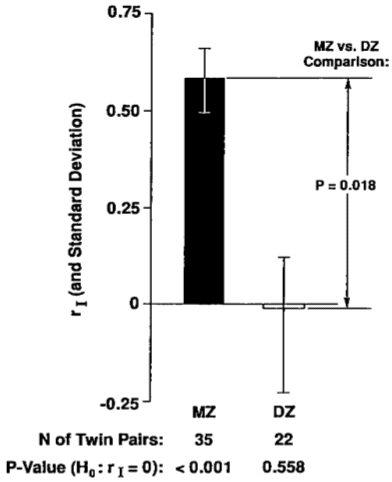
Emergenic heritability of the circadian amplitude of human heart rate. Assessed by statistically significant intra-class correlation (rI) for monozygotic (MZ) but not for dizygotic (DZ) twin pairs reared apart. Heart rate was assessed in 24-hour electrocardiograms, amplitude was computed by cosinor; a statistically significant intra-class correlation (r1) for monozygotic (MZ) but not for dizygotic (DZ) twin pairs reared apart was found [85,304].
The heritability of the circaseptans, and perhaps of other spectral components of non-photic origin [56] that may be gauged by periods as well as amplitudes may still appear to be "paranoia" to many. My recommendation is to assess an amplitude and to use it as an objective practical test for a rhythm with an anticipated frequency as the zero-amplitude [no-rhythm] test), e.g., in its cosinor form, as recognized in a historical context by Aschoff [65] and used for a phase-map by Pittendrigh (Fig. 4 in [157]), among others. Each test can be misused, or may appear to be misused, because of limited access to prior information. Each test gains from the accumulating mapping along different time scales that may all be pertinent to one's design and interpretation of sampling.
Puzzle #7: Prior information is compatible with timed spotchecks
With many years of blinding studies in hand, we could submit a proposal to NASA's Space Science Board on a single page while others, with help from corporations like General Electric, submitted thick volumes. We wrote that if, in the mice we had examined, the period was known to be ~23.5 hours after blinding and if most systems failed, a single time-specified spotcheck could validate our inquiry into whether a built-in period would be largely similar in extraterrestrial space as on earth. We were awarded what we proposed after we sent some mice to NASA's Ames Research Center in California, where John Tremor validated our prediction of antiphase on a few animals. The more the available prior information, the easier it is to draw inferences, even from a single predicted antiphase test based on a check at a single timepoint [255], although for the original mapping, very long, often as-yet unavailable series would be preferred, a reminder for the scientific community to start mapping and to analyze the already accumulating data as one goes [56,256].
Puzzle #8: Collaterally hierarchical cellulo-neuroendocrine mechanisms: no master oscillator
The nervous system and the adrenal cortex, both are rhythmic and each can be critical for one rhythm or another [15], but neither is indispensable for all rhythms, as seen by the persistence of eukaryotic cellular and prokaryotic rhythms under standardized conditions in vitro [15]. Again well over half a century ago, I learned that the electroencephalographically recorded pathology in the human EEG undergoes circadian variations [257], and by the 1960s that the power in different frequency regions of the Berger range is circadian in human health [258]. When the EEG is studied in conjunction with the adrenal cortex, the adrenocortical cycle has the much larger (relative to its mean, equated to 100%) circadian amplitude, responsive to changes in routine [258]. The amplitude of the adrenocortical rhythm increases during prolonged wakefulness, as seen directly by hormone determinations [258] or indirectly in counts of blood eosinophils [88].
The adrenal cortex is essential for rhythms in blood eosinophil count [86] and underlies the synchronization of rhythms in phospholipid labeling [259] and mitosis in healthy mouse ear pinna [260], but is dispensable for the rhythm in serum iron [260], which upon bilateral adrenalectomy persists with statistical significance, albeit with a reduced circadian amplitude and a change in phase [260]. By comparison, the circadian mitotic rhythm examined by Meng and Pohle in mice carrying an Ehrlich ascites carcinoma persisted with a time-macroscopically reduced amplitude after a bilateral adrenalectomy but perhaps without removal of ectopic tissue [261].
Likewise, when the results are examined time-microscopically, removal of the suprachiasmatic nuclei reduces the amplitude of the circadian rhythms in motor activity and water drinking to the point of their obliteration, but does not obliterate, only reduces the amplitude of circadian rhythms of many other variables, such as alcohol drinking, plasma ACTH and corticosterone [15], unless this latter variable is sampled at 6-h intervals rather than more densely. Histologically validated bilateral suprachiasmatic lesions are compatible with the continuance in sufficiently densely sampled data, of rhythmic changes in core temperature, Fig. 34, and in a number of cellular endpoints such as DNA labelling and cell division, invariably with an advance in phase [15], Fig. 35, and, as noted, in several cases with a statistically significantly reduced circadian amplitude, except for the stomach and colon, where an SCN lesion may be associated with a numerical increase of the amplitude, Fig. 35, as demonstrated by the late Lawrence E. Scheving with Ervin Powell, James Pasley and John Pauly [198-200,262].
Puzzle #9: High degree of generality if not ubiquity within an organism
A nearly ubiquitous circadian system may now perhaps be widely accepted as a fact, albeit usually for fields other than a given non-chronobiologist's topic. This attitude constitutes a drastic change from the 1950s, when a 24-hour or 1-year variation was recognized in only a few selected variables; the rule of that day for most of physiology (and for too many investigators even now) being a relative constancy in physiology in keeping with the elderly Claude Bernard [263], but not with the active founder of experimental physiology and medicine at the peak of his activity [264]. Rhythms in the 1950s were considered the exception. The concept of a relative constancy, or homeostasis, allowed for the drawing of "baselines", a word used in too many articles then and, unfortunately, now. It was, and is, as if the grand edifice of physiology, hardly any variable excluded, were built on the quicksand of single or a few time-unqualified samples that often proved highly variable, much too unstable to constitute thecontrol, referred to as the "baseline".
Much mapping and popularization has yet to be done to bring about a general awareness of an ever-present system of variations with different multifrequency rhythms constituting useful since predictable grounds for time-specified action. The 1950s offered new dynamic endpoints from choosing a system time for any serial sampling along a 24-hour scale and for using a much broader time horizon both for scheduling sampling replications and for data interpretation. Chronobiology, the study of mechanisms underlying rhythms spawned chronomics, the mapping of chronomes as objective endpoints, consisting of point-and-interval estimates of characteristics, justified by the recognition of a need to deal with the high extent of generality if not ubiquity of chronomes. The importance of time structures warrants a new cartography, chronomics, that should be useful, if not indispensable for routine consultation in any planning of data collection and/or interpretation. Conceivably, this journal could contribute to this still unrealized goal in biomedicine, also needed more broadly in other disciplines. Illustrative transdisciplinary examples are found in 2,759 published titles (through September 2003), most of them listed on my website http://www.msi.umn.edu/~halberg/.
Puzzle ("paranoia") #10: Microbial circadians
A circadian rhythm in bacteria was documented time-microscopically in 1961 [265] on impeccable data [266] collected by Lore A. Rogers (a noted bacteriologist described by a Cosmos Club Vignette of December 1967 as "the bright star in the [U.S. Department of Agriculture's] scientific horizon before World War II"). Rogers' data stemmed from a fluid culture of E. coli, analyzed both by a periodogram and by power spectra, showing clear free-running circadians. Nonetheless, for years international symposia and cell chronobiologists in particular, including a committee formed by them in 1975 [267], held the view that circadians are a property only of eukaryotes [15,265,267]. I wrote to each committee member asking why they ignored the demonstration in E. coli [265] and the extension of the finding by Sturtevant in John Pauly's laboratory in Arkansas [268,269]. I regarded, and continue to regard the organizers as friends. Both Woody Hastings and the late Hans-Georg Schweiger thereafter extended their focus to circaseptans, documenting their open mind [270,271]. Schweiger became a visiting professor at the University of Minnesota and was my house guest (and I his house and institute guest), and in later years cooperated extremely closely. A friend on the committee, however, wrote that he "ate crow" and noted that the "consensus" had been that there were "too many analyses" in the 1961 publication [265] and again too much time-microscopy in the follow-up study [268,269], a thesis notwithstanding. The consensus was also in keeping with negative unpublished results by several symposium participants; so went the critique leading to the committee's decree that circadians are limited to eukaryotes. Jürgen Aschoff also responded by asking something like "Do you wish to hold us responsible for posterity?" I answered in a qualified affirmative, that the rules we postulate today may be revised tomorrow, always based on data. Microbial circadians abound today and constitute an active field of investigation [272-277].
Puzzle #11: Biospheric and environmental spectral reciprocity
From rhythms with different specific ranges in the frequency domain in different physiological systems, by the 1960s I had arrived at a spectrum with components of many different frequencies in one and the same variable [16]. Eventually, for the genetically anchored multifrequency spectra, far beyond the scope of circadian rhythms, spectra with near-matching periods were found for physical environmental variables, prompting the concurrent consideration (or mapping, if need be, in chronomics) of environmental cycles, rather than giving just an indication of the lighting, temperature and feeding regimens and of the daily routine.
Temporal organization in and around us has led me to a useful rule to seek a reciprocity of the cycles in ourselves and in physical and societal nature [56]:
1. for each non-photic periodic component in the environment, just as for the photic day and year, a near-matching organismic component may be sought. This is why we mapped, among others, circadecadal, circadidecadal, circaquindecadal and an about half-yearly period in the biosphere, as now extended to the trans-year, Figs. 43 and 44[8,171], which can beat with the biological (equivalent in terms of period) calendar year. So does an artificial clock-determined 21-hour schedule imposed in the arctic summer months (with an only very slightly varying intensity of continuous light) beat with an endogenous free-running period of the human adrenocortical cycle [50,278,279]. Two circadian rhythms may also beat in a unicell [280]. The trans-year is the newest non-photic physical environmental signature, with its discovery prompted by the search for, if not by the rules of spectral reciprocity in chronomes [56]; its possibly innate features are in keeping with non-overlapping 95% confidence intervals between the period of a trans-year in us and in the solar wind, Figs. 43 and 44;
Figure 43.
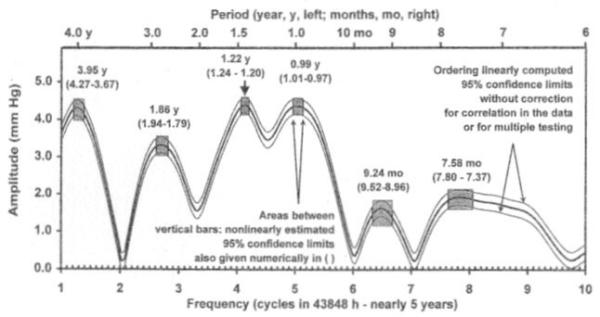
Spectral window of systolic blood pressure showing biggest amplitude (arrow) near period of Richardson's variation in solar wind speed. Data of 72-year old man at the start of the 5-year record of mostly 30-minute automatic "ambulatory" measurements with an A&D monitor (except for an about 2-month break). Uncertainty regions serve only for ordering. A trans-year is prominent and can be resolved in addition to an about-yearly component in human blood pressure [8,171], as anticipated from the role of biospheric-environmental spectral reciprocity [56]. The presence of a trans-year was confirmed in each of the available human blood pressure and heart rate series covering over 5 (up to 36) years.
Figure 44.

Closer agreement of about 1.3-year component in human blood pressure (BP) and heart rate (HR) with long-term than with concurrent solar wind (SW) speed. The non-overlapping 95% confidence intervals have to be qualified by the very wobbly nature of the Richardson component in SW and physiology. The 95% confidence intervals of a transannual spectral component in a subject's blood pressure and heart rate do not overlap that of the solar wind during the same time span: putative evidence in keeping with the assumption of some degree of endogenicity for a signature of a non-photic environmental cycle in the biosphere.
2. for each inferentially statistically validated rhythm as part of an organismic time structure, one can seek a corresponding element in the chronome of a natural physical environmental variable. This is how we detected a 6.74-day component in a record of geomagnetic disturbance (Kp) covering 59 years [175]. The finding in biology of a near- (but not precisely) 7-day week prompted us to search for a geophysical near-match. The near-weekly component was then further specified as to its variation with solar cycle stage [281] and was found in an even longer span of over 100 years of the geomagnetic antipodal aa index, available since 1868 [282]. We then also looked for changes with time in aa [283] to test the possibility that the difference in amplitude between two components, one human-made of 7 days and the other a natural physical environmental component, usually with a slightly shorter period than a week, may have changed gradually since 1868 because of less past vs. current anthropogenic magnetic pollution. We hypothesized that a human-made component of precisely one week may have been smaller in amplitude the farther back one goes, while the amplitude of the geomagnetic near-week was, if not about the same, then not steadily increasing, realizing, however, that this very wobbly, very small amplitude is also subject to the many cycles in solar activity [284]. We were confident only in assuming that the anthropogenic 7-day week as a feature of global magnetic pollution may be increasing with advancing time. The aforementioned wobbliness of the environmental near-week was demonstrated in the study of 22- or 21-year sections of the record now covering over 130 years of aa. With this qualification, the difference between the originally larger amplitude of the near-week and the precise 7-day amplitude in aa has decreased with time. Recently components with nearly equal amplitudes were found for the 7-day and near-weekly components in records of pulsations (provided by a stand-alone magnetometer) in Antarctica, showing apparently the increase in global magnetic pollution [285];
3. biological rhythms without environmental near-matches may point to the disappearance, in the course of life's development on earth, of a natural physical environmental cycle. Accordingly, it would be most interesting if a biological rhythm would have no environmental near-match. A current challenge is the search for a possible environmental counterpart for about 8-hourly rhythms in vasoactive substances such as in the case of endothelin-1, a powerful vasoconstrictor. We also find this component in the population density of the endotheliocyte. Moreover, these features of our time structure show "secular" changes to possibly be unmasked as rhythms with a low infradian frequency [286-291];
4. controversies about recapitulation of our morphology in space, in the sense of Haeckel notwithstanding, one may ask whether, in their growth and development, human beings and other multicellulars are living fossils that may replay in their rhythmic dynamics during ontogeny, some of the sequences that occurred during the development of life. In this context, multicellular organisms such as humans may be a favorite source of information for scholars on the origins of life. The growth, development and differentiation of eukaryote single cells or prokaryotes may not exhibit the time-lapse phenomena observed in more differentiated organisms, albeit circadecadals characterize both Acetabularia acetabulum [292] and bacteria [293,294].
In this same context, certain multicellular organisms may be better "fossils" for certain things as compared to others. Thus, crayfish may be a better subject of study [295] than human beings, pigs [296] or rats [297], for the investigation of the biological week. A circaseptan predominates over the circadian variation in the case of locomotor activity of crayfish, up to at least 6 months of age. In contrast, by the end of the first month of life the about 7-day component of physiological variables compares unfavorably in terms of its (circaseptan) amplitude with the amplitude of circadian rhythms in humans, Figs. 25,26,27,28,29,30,31,32, pigs, or rats. In old age, circaseptans and ultradians regain some relative prominence, but do not necessarily exceed a circadian rhythm in amplitude [298].
Conclusion
Basics aside, a journal of circadian rhythms is desirable in this millennium, when the American Dietetic Association ("Your link to nutrition and health") [299] can insist "It's not when you eat, but what you eat that counts. No matter when they're eaten, calories seem to have the same effect on the body". This misinformation is being distributed notwithstanding the evidence that timing can make the difference between a relative body weight gain vs. loss from the same number of calories in humans, Figs. 45,46,47,48, and in the laboratory for mice (without large fat reserves in a cool environment), meal timing can contribute to the difference between life and death [2,300].
Figure 45.
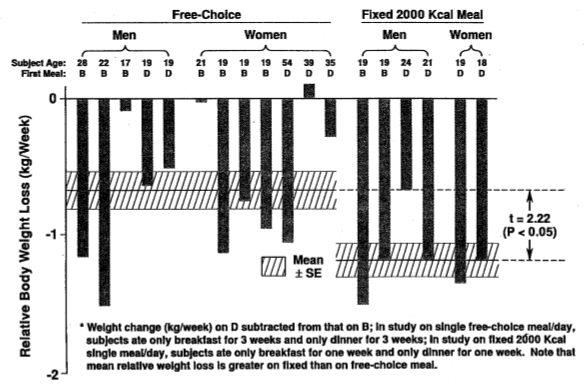
Meal-timing and body weight: relative body weight loss for individuals consuming single daily meal (free-choice or fixed) as breakfast (B) or dinner (D). Difference in body weight change on breakfast-only vs. dinner-only, when clinically healthy subjects consumed a fixed number of calories within 1 hour of getting up vs. not before 12 hours after getting up, respectively [2]. In two separate studies of the effect of meal timing on body weight, nine men and nine women consumed either, for 1 week, a fixed 2,000-kcal meal, or, for 3 weeks, a single free-choice meal as breakfast (B) or dinner (D). A relative body weight loss of about 1 kg/wk was noted on breakfast-only, as seen from a comparison of the hatched horizontal bands.
Figure 46.
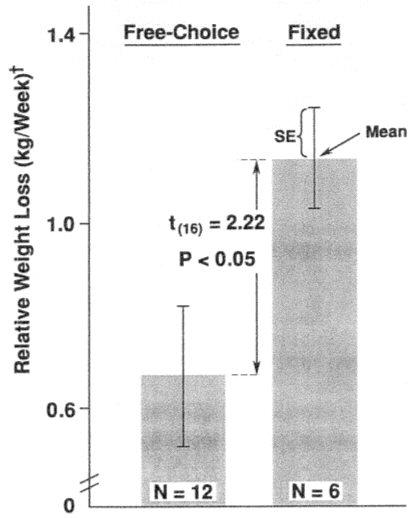
"Appetite" modifies effect of meal-timing on body weight. Relative body weight loss on breakfast-only (B) as compared to dinner-only (D) is less when meal is free-choice rather than fixed. *Here defined as choice of kind and amount of food. †Weight change (kg/week) on B subtracted from that on D. Appetite (here defined as choice and amount of food) modifies effect of meal timing on body weight. Relative body weight loss on breakfast-only (B) vs. dinner-only (D) is less when meal is free choice rather than fixed (see Fig. 45 for results on individuals) [2].
Figure 47.
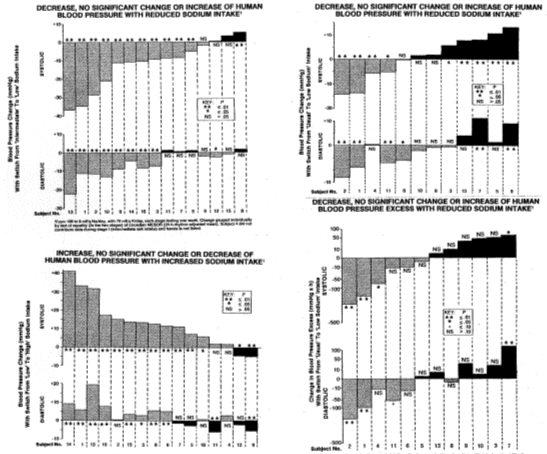
Effect of sodium intake on blood pressure. Blood pressure change in association with change in sodium intake is an individual's concern and cannot be generalized. The recommendation of reducing dietary sodium intake across the board to prevent blood pressure elevation is unwarranted, as shown in two different studies. Routine self-testing by each individual could avoid much controversial debate in the literature.
Figure 48.
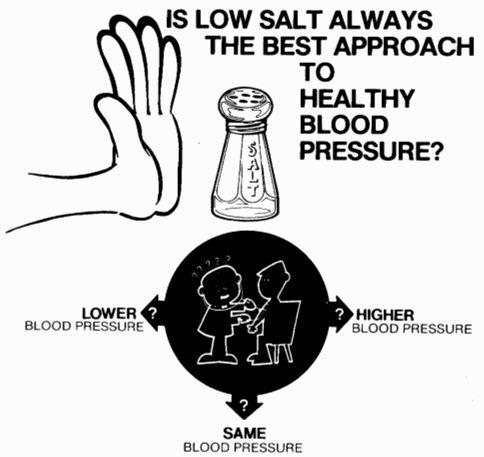
Shall we pass the salt? or pass, on the salt? Responses to a low-salt (low-sodium) diet differ: blood pressure may be lowered, may remain unchanged by reducing dietary salt, or may actually be raised when salt is restricted. Self-responsibility by the given individual in terms of manipulating sodium intake with surveillance of one's blood pressure seems to be the most suitable solution to determine the best course of action (see Fig. 47).
A journal on circadian rhythms is essential when radiotherapy is given at times of convenience but not necessarily pertinence, although marker rhythmometry has doubled the 2-year disease-free survival rate of patients with perioral cancers, Fig. 13.
A journal on circadian rhythms becomes indispensable for cost-effective health care when the circadian amplitude of blood pressure allows the detection of risks higher than a high blood pressure [8], but this fact is ignored in new official guidelines [301], and thus stroke prevention – prehabilitation – is ignored and the current resources assigned by law support only after-the-fact rehabilitation, Fig. 12.
My question for those in responsible positions such as the commissioner of the FDA or for institute heads at the NIH remains the same as that in the title of an invited lecture to the FDA decades ago: "Neglect of circadian rhythms: ignorance, indolence, or perhaps criminal negligence?" The evidence for the latter judgment was in hand in the 1970s when the survival time of leukemic mice was doubled in the laboratory and eventually the number of cures was greatly increased in the very test situation required by NIH.
May the new journal contribute to the recognition that circadians are an important matter of time-keeping in its own right, but also an indispensable step toward replacing imaginary "baselines" by circadian characteristics whenever they are shown to be pertinent to scientific research and to everyday human endeavors, as endorsed by a national medical academy [302]. It seems unlikely that a case is found when circadians can be ignored in physiology or biology more broadly without some loss of information [303] and usually also without a loss of potential benefit in health care and beyond. It may be argued that circadian rhythms are complex and expensive to map. This is why generally accessible maps of circadian systems are essential so that for each important endeavor, the best times for most people can be anticipated. When in turn individual differences are known, as in blood pressure behavior and salt intake, the individualized assessment of these rhythms can be implemented cost-effectively by previously validated sampling schemes.
It is good to focus on circadian systems to start drawing back the curtain of ignorance placed over the normal range by homeostasis, Fig. 18. But oversimplification reminds us of the aphorism attributed to Einstein: "Everything should be made as simple as possible, but not simpler" (Fig. 18).
May the story of a life spent in the study of variability, built-in [85,304] and other [56,175], also lead to unity by all of those who have the courage to recognize that circadians are just the tip of the iceberg of variability. The task of taking the entire evaluable time structure of any variable such as blood pressure into account, including, when possible, its very broad spectrum of rhythms, seems complex and utopian at first, like the building of roads in an unknown terrain or the suggestion to take to the air or to the stars [56,175,256]. This is what the BIOCOS project [56] in the footsteps of Janeway [41], collecting reference standards that are complex and costly, is all about [39,40,42]. It is hoped that the reference data base will be augmented for further work and used in the interim, for vascular disease prevention, the timed treatment and, as soon as possible, the timely prevention of cancer and, if we can dream, someday soon for the prevention of diseases of society. There is an important point in building highways or airplanes to bridge distances: it must be kept in mind that once the roads or the planes are available, they must not be rebuilt for every trip [305,306]. Users may pay figurative taxes, pay a toll or buy a ticket. But here the analogy ends. I thank Roberto Refinetti for providing the information herein via his journal in a form that is free for everyone. May Roberto succeed in eventually eliminating the "chrono" in chronobiology, chronophysiology and chronopharmacology, etc., by helping to introduce reference norms for characteristics of a circadian time structure for use in everyday human routines as well as in transdisciplinary science, as the indispensable control.
Afterthoughts on grants, contracts, dedications and co-authorship
Having had a chance to participate in a Biosatellite study, I learned that being part of a very specific contract in 9 places can be counterproductive: caring for the purely technical details of a large team reduces one's productivity. Having had opportunities of substantial grantors coming from industry, I also learned the benefits of not spending most of my time by writing grant applications and reports as a basis for new applications, as I had to do myself, albeit only occasionally part-time, while I have seen too many of my colleagues doing this nearly full-time on a figurative treadmill. Thus, above all, I thank those who made the work possible. In this context, I thank Woody Hastings, the late Colin Pittendrigh and others for their trust at the time to suggest that I work on a Biosatellite. I expressed my qualifications of the benefits of large grants in Nature [308].
There is no question that everybody who contributed to a piece of research being reported should have an opportunity to be a co-author (I also mean everybody who supported the work in one way or another, in order to arrive at whatever was accomplished by that publication). This is a very broad definition of "co-authorship". In some places, it was too broad, as in 1948 at the Brigham, at Harvard, where several (I cannot recall the exact number, it may have been 6 or 8 or perhaps 10–14) fellows all drew blood, each from different patients and in some cases at different times from the same patient, e.g., for a given test and thereby or otherwise contributed in any one way or another to the final product: the co-authorship was a sign of their participation, i.e., of team membership. As a dissenter about the epinephrine test, I am not a co-author in any one of the papers published by those I worked with at Harvard. Upon my arrival in Minneapolis, staff members of the University of Minnesota automatically became members of the graduate school at the Mayo Clinic. We sat on examinations of good physicians who also acquired PhDs or MSs by carrying blood or urine, respectively, from the patient to the chemistry or other laboratory. This action may appear to be a questionable contribution for a degree or for any co-authorship or even first authorship in a publication, but something that, by current standards if properly phrased, could be an author's contribution.
I realized in retrospect decades later that each link in a project is meritorious, when a cancer chronotherapy project could not be started, even though the residents in gynecological oncology and Erhard Haus, the head of the clinical chemical laboratory, were highly interested and had the staff to cooperate, and we had a very generous supply of expensive kits. What prevented the project was the lack of means to transfer around-the-clock samples of body fluids to the clinical laboratory, which was somewhat distant from the patients in the university hospital.
On another occasion, a competent friend, well-read in a field different from ours, called and told us a fact that led us to the demonstration of something predicted, yet completely new. The work could not have been done without the one telephone call or e-mail (I do not recall) telling us about the publication that triggered the entire endeavor. The common denominator for co-authorship in my papers was the ability, willingness and preferably enthusiasm in participating and in defending an unpopular endeavor, labeled unfavorably (e.g., "trivial", "inaccurate", "pretentious", "unbelievable" or, harshest of all, "paranoic"). When one confronts dominating concepts such as baselines or normal ranges in everyday use, or when one postulates that the most constant substance we contain – nucleic acid – against which we calibrate clinical chemical determinations, is periodic rather than constant, even colleagues who grant us the benefit of the doubt do not dare to help with the service of a technician paid by government funds and, as noted, fortunately for us, volunteer as "technicians" themselves.
If we are otherwise active all day and do not have time to read all we should, we appreciate help by friends who send us clippings and an e-mail note that leads to the discovery of a new rhythm with a period near one year which beats with the precise yearly period. That beat in turn explains why a spectral component is prominent at one time and disappears at another time. Each of these clipping providers, whether or not s/he adds funds in many places, will be offered the opportunity to see the result and, in one way or another, get credit for it. In my opinion an infinite list of other conditions warrant more than the customary acknowledgement, such as the enabling of the work, whether by provision of a laboratory, by funding, or even by moral support. Only in special cases is a dedication in order. Much work could not have been done without such support: William Harvey dedicated his book De Motu Cordis to King Charles I of England, whose physician he was, a good way to pay respect. Herein, I try to pay respect in the same fashion.
The suggestion that one should qualify what each author has done is not contested herein, but reminds me of two late senior colleagues, both world class scientists and both international leaders of their profession. Whenever I brought a new manuscript to them, and after each of them had kept it for a while, they thanked me for including them. They usually made no suggestion for changes but asked just one question: Y asked what X had done and X asked what Y had done. One is reminded of Wilhelm Busch describing the proud obstetrician who gets credit for the midwife's contribution (Stolz ist Dr. Pelikan weil er seine Pflicht getan). I am still grateful to both X and Y, and still would offer each of them co-authorship, because without the genetically invaluable, carefully mated mice one had provided, there would be no Minnesota chronobiology, and without the opportunity to stay in the USA provided by the other, my life could have taken a completely different course.
For those scientific accountants who wish to itemize what each of us did, the foregoing true story by two distinguished scholars serves as a reminder of human imponderables, if not frailties, involving those who offer and those who accept a co-authorship. Of my 2575 published titles as of September 2003, 2361 have co-authors, and I am most grateful to each of them. Some of them are first authors even when I wrote the entire paper. One of them, in a critical paper in Science, made his contribution when, at the last moment, our team was one person short. We called him in the early morning, and he jumped out of bed and played an important role in the study. I have a very great debt to these friends of chronobiology and to very many others. I can only hope that each coauthor enjoys this sign of recognition and that it may please the persons involved. If some of them help in overcoming the next hurdles of two new sciences, chronobiology and chronomics, or help at least in using circadian physiology in everyday life, so much the better. I remain red-faced for having failed to mention Rex Ingram, Mr. Hypothalamus, the late anatomist/dean in Iowa, who sent me CARE packages in post-war Innsbruck, and in whose home I spent my first Christmas vacation in the US, where, after a festive meal, we all washed the dishes – an introduction to Midwestern Americana (what a contrast to Harvard!). I practiced dishwashing figuratively (i.e., analyses) as well as literally after that visit to Iowa in 1949, thanks to innumerable others who offered an intellectual and/or caloric meal, but cannot mention them all; this paper was not yet meant to be an autobiography.
Epilogue: Diversity in time complements diversity in space: Chronobiology and chronomics complement Mendel's genetics and Purkinje's self-experimentation
A negative attitude prevailed in the late 1940s and earliest 1950s toward biological rhythms and toward what became chronobiology. This attitude resembled that prevailing in physics in 1857, described in a series of verbatim quotes by Manuel Johnson, then president of the Royal Astronomical Society, when he awarded the society's gold medal to Heinrich Schwabe, the discoverer of the wobbly sunspot cycle, which Galileo and Newton, both owners of good telescopes, had missed.
In biology in 1949 (as now), fixing the time of day was deemed to be a sufficient precaution to "eliminate the effect of rhythms". My comparison of counts of certain circulating blood cells then involved, as controls, a 24-h synchronized group of mice vs. one that was on the same lighting regimen, but without my realizing it immediately, it was phase-shifted by a diet restricted in calories offered in the morning, usually a time of rest for nocturnally feeding mice. I could not obtain the same results by comparisons of the same two groups when they were resampled at different times of day. In another case, I again compared a 24-h synchronized group with one that was phase-drifting after blinding. At different times after operation, but now at the same times of day, I had the conflicting results to be expected when one compares a 24-hour synchronized group with one that phase-drifts. The (adrenal and then pituitary and hypothalamic as well as cellular) mechanism and eventually galacto- and/or helio-geomagnetic mechanisms underlying rhythmic behavior had to be explored and ascertained before any data could be interpreted.
Pursuit of those puzzles initiated by phase-shifts and -drifts was then labeled "paranoia". To me the results conveyed the fact that an assessment of rhythms, not only of circadians but also of changes with many other frequencies, while an important aspect of biological time measurement, pursued by others and certainly by myself, is also very much more; we are replacing imaginary baselines by the control of everyday photically and non-photically influenced physiology and eventually of everyday cosmology, for which organisms are specialized sensitive radiation detectors. Then, it turned out, still in the 1950s, that these rhythms, used as "controls" of what happens, themselves can account for the difference between life and death under the seemingly standardized conditions of a laboratory, whether the stimulus was physical, like noise or whole-body irradiation; or other, such as a bacterial endotoxin or drug. Any variable I happened to sample with sufficient density for several 24-hour cycles replicated in the same individual and/or on different individuals happened to be structured in time. Often, when sampled long enough, the structure changed as a function of developmental and/or other trends and/or was buried in noise, i.e., in patterns then unknown, often rhythms with lower frequency and eventually deterministic chaos. A new science of the interplay of make-ups in time around and in us came about: chronobiology. For the spectral element covering frequencies of 10 orders of magnitude, a biospheric-environmental spectral reciprocity and interdigitated feedsidewards were uncovered by resolving characteristics such as periods and for each fundamental period, corresponding amplitudes, phases and waveforms, always with the uncertainties of these estimated parameters. These characteristics in their turn became dynamic reference standards of everyday science (e.g., everyday physiology, psychology, sociology, ecology, ...). These reference standards turned out to be critical for the recognition of harbingers of a highly elevated disease risk in the usual "normal" range, and thus for the preventive treatment of earliest alterations: prehabilitation. To those who had not seen firsthand that rhythms tipped the scale between life and death in the laboratory, chronobiology as a science at first appeared to be, as already noted, "trivial, unnecessary, pretentious and inaccurate" – words never said to my face but written in a letter almost certainly not meant for publication. The issue became, and today remains, the disciplinary stake. It was a great pleasure when the afore-cited critic, in a major publication summarizing his life's pursuits, requested and published a chronobiological phase chart. In this sense, he set an example for unity among those who do time-microscopy and time-macroscopy, who all contribute to transdisciplinary science based on assessment of rhythms and/or broader time structures. There is a need for unity whether the subject is taught time-macro- or -microscopically [1,55,119,120,126,130].
With respect to chronobiology and chronomics as science, Fig. 49, the issue is the same as that now accepted for most published research. There is a need for inferential statistical hypothesis testing and, in any event, invariably for an interval as well as point estimation of characteristics. For health care, in the presence of a multifactorial statistical causality and great inter-individual differences, there is the added need for an individualized inferential statistical approach in an evidence-based medicine subservient to the diagnosis of risk elevation and its treatment before (not only after) the fact of disease. The current gold standard in medical research consists of controlled clinical trials that ignore the person involved and will have to be replaced by individualized self-experimentation, to know for the given individual not only whether to pass on the salt or use the salt shaker (for an everyday example), but also whether one's risk of severe vascular disease is low, perhaps below 4%, or very high, nearing 100%. In the latter case the risk should be lowered before a severe disease occurs, so that, e.g, a massive stroke is prevented, Figs. 15, 16
Figure 49.
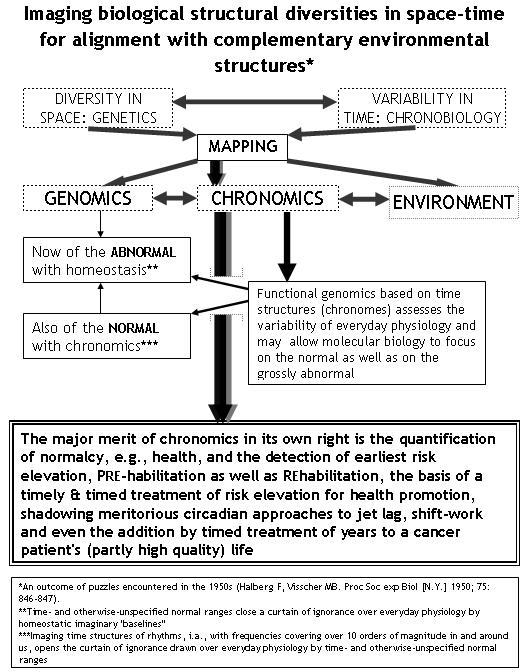
The concept of chronomics.
In concerns for both a controlled transdisciplinary science and literacy in preventive health maintenance, chronobiologists can agree and benefit from unity. They will accept the biological week sooner if they actually see, in a gliding spectrum, the towering week in the human baby's circulation, and the dominant circadian only toward the end of the first month of life. They will agree more rapidly on the importance of the biological week if they are interested in cancer prevention and find that sinusoidally increasing and then decreasing daily doses of an immunomodulator can inhibit the subsequently implanted malignant growth, whereas in equal daily doses the same total weekly dose enhances the malignant growth. Basic science will note that time-microscopy resolves what the naked eye may miss as the trans-year, a rhythm longer than the calendar year. Everybody may wish for a MESOR rather than an arithmetic average, when the former, because of a smaller standard deviation, but not the latter, allows the validation of a therapeutic effect for the given, e.g., MESOR-hypertensive person involved.
Omnia metire quaecumque licet; et immensa ad mensuram redige – tempestive, ergo significative, et quam simplicissime, sed non simplicius
("Measure all that is measurable; and render measurable what as yet is not – in time, hence meaningfully, as simply as possible, but no simpler")
Authors' contributions
FH provided the reminiscences that constitute the core of the article. GC did most of the checking and compiled the figures. GK, EVS, RBS, RZ, JH, FH, YW, and OS provided empirical data and/or support essential for the development of the concepts and the safeguards used, only a few of them described herein.
Supplementary Material
Table 1 - Summary of studies of Circaclian Hyper-Amplitude-Tension (CHAT) and Decreased Heart Rate Variability (DHRV)
Table 2 - Outcomes of Chronological screens of blood pressure and heart rate
Table 3 - Examples of self-surveillance chronobiological efforts
Acknowledgments
Acknowledgements
This article is dedicated to: my international attorney father, Julius Halberg, who set the course of my life and remains my role model; my late wife Erna, who was ever ready to provide factual and all other support; my co-authors, who helped with the addition of microscopic to macroscopic imaging in time; to a lifelong friend, Earl E. Bakken, of "free-running" fame, and to Henry Nash Smith for circadiana; and to four masters in indispensable time-macroscopy: to Jürgen Aschoff and Colin Pittendrigh, who emphasized the endogenicity of circadian systems; and Alexander Chizhevsky and Frank A. Brown Jr, who recognized that we are systems open to our cosmoi. Let me hope that it will serve all persons who will recognize, like Molière's Bourgeois gentilhomme, that they must use, in poetry and transdisciplinary science, the "4th R" of rhythms (or rather chronomics) for self-help in health care whereby, with proper archivization, they also contribute more than prose (read, inferential statistical science). When our technology readily enables the continuous surveillance of parking garages, supermarkets and tiny laboratory mice, the time is ripe to monitor the otherwise neglected range of everyday human physiology, thereby to prehabilitate rather than to rely only on rehabilitation after the facts of overt diseases of individuals and societies (homicide, other violent crimes, and wars, all cyclic and, to that extent, open to the seeking of underlying mechanisms). Again, I am deeply grateful to the editor-in-chief, who through correspondence and over the telephone has also become my valuable teacher. It is hoped that his endeavor to unite a fragmented field will be successful. Hence, I set everything aside to enjoy writing this article, remembering what is fun in retrospect but may not have been enjoyable at the time.
Special thanks are due to Mary Sampson (MS) for her tireless efforts in preparing this article for publication.
Support: Earl E. Bakken Fund (GC, MS); U.S. Public Health Service (GM-13981) (FH); University of Minnesota Supercomputing Institute (GC, FH).
Contributor Information
Franz Halberg, Email: halbe001@umn.edu.
Germaine Cornélissen, Email: corne001@umn.edu.
George Katinas, Email: katin001@umn.edu.
Elena V Syutkina, Email: masalov@sci.lebedev.ru.
Robert B Sothern, Email: sothe001@umn.edu.
Rina Zaslavskaya, Email: rinazas1@yandex.ru.
Francine Halberg, Email: fehalberg@yahoo.com.
Yoshihiko Watanabe, Email: yoshi-w@jd5.so-net.ne.jp.
Othild Schwartzkopff, Email: schwa115@umn.edu.
Kuniaki Otsuka, Email: frtotk99@baz.so_net.ne.jp.
Roberto Tarquini, Email: rtarquini@cestit1.unifi.it.
Perfetto Frederico, Email: perfetto@unifi.it.
Jarmila Siggelova, Email: Jarmila.siegelova@fnusa.cz.
References
- Refinetti R. Circadian Physiology. Boca Raton, Fl: CRC Press. 1999.
- Halberg F, Haus E, Cornélissen G. From biologic rhythms to chronomes relevant for nutrition. In: Marriott BM, editor. Not Eating Enough: Overcoming Underconsumption of Military Operational Rations. Washington DC: National Academy Press; 1995. pp. 361–372. [PubMed] [Google Scholar]
- Halberg F, Cornélissen G, Otsuka K, Schwartzkopff O, Halberg J, Bakken EE. Chronomics. Biomedicine and Pharmacotherapy. 2001;55:153–190. [PubMed] [Google Scholar]
- Halberg F. When to treat. Hæmatologica (Pavia) 1975;60:1–30. [PubMed] [Google Scholar]
- Halberg F. When to treat. Indian J Cancer. 1975;12:1–20. [PubMed] [Google Scholar]
- Halberg F, Cornélissen G, Wang ZR, Wan C, Ulmer W, Katinas G, Singh Ranjana, Singh RK, Singh Rajesh, Gupta BD, Singh RB, Kumar A, Kanabrocki E, Sothern RB, Rao G, Bhatt MLBD, Srivastava M, Rai G, Singh S, Pati AK, Nath P, Halberg Francine, Halberg J, Schwartzkopff O, Bakken E, Shastri VK. Chronomics: circadian and circaseptan timing of radiotherapy, drugs, calories, perhaps nutriceuticals and beyond. J Exp Therapeutics Oncol. 2003;3:223–260. doi: 10.1111/j.1533-869X.2003.01097.x. [DOI] [PubMed] [Google Scholar]
- Halberg F. Lieber Theo; Liebe Jutta. Neuroendocrinol Lett. 2003;24:10–11. [Google Scholar]
- Halberg F, Cornélissen G, Schack B. Self-experimentation on chronomes, time structures; chronomics for health surveillance and science: also transdisciplinary civic duty. Behavioral and Brain Sciences. avaliable online: http://www.bbsonline.org/preprints/roberts/commentators/.Halberg.html. [DOI] [PubMed]
- Halberg F, Halberg J, Halberg Francine, Halberg E. Reading, 'riting, 'rithmetic – and rhythms: a new "relevant" "R" in the educative process. Perspect Biol Med. 1973;17:128–141. doi: 10.1353/pbm.1973.0003. [DOI] [PubMed] [Google Scholar]
- Halberg F. More on educative chronobiology, health and the computer. Int J Chronobiol. 1974;2:87–105. [PubMed] [Google Scholar]
- Halberg F, Gupta BD, Haus E, Halberg E, Deka AC, Nelson W, Sothern RB, Cornélissen G, Lee JK, Lakatua DJ, Scheving LE, Burns ER. Steps toward a cancer chronopolytherapy. Proc. XIV International Congress of Therapeutics. Montpellier, France: L'Expansion Scientifique Française. 1977. pp. 151–196.
- Halberg J, Halberg E, Hayes DK, Smith RD, Halberg F, Delea CS, Danielson RS, Bartter FC. Schedule shifts, life quality and quantity modeled by murine blood pressure elevation and arthropod lifespan. Int J Chronobiol. 1980;7:17–64. [PubMed] [Google Scholar]
- Halberg J, Cornélissen G, Halberg F, Halberg Francine, Halberg E. The sphygmochron for chronobiologic blood pressure and heart rate assessment in cancer patients. In: Woolley PV, Kaiser H, editor. Cancer Growth and Progression. Vol. 10. Dordrecht: Kluwer Academic Publ; 1989. pp. 189–195. [Google Scholar]
- Halberg Francine, Halberg J, Halberg E, Halberg Franz. Chronobiology, radiobiology and steps toward the timing of cancer radiotherapy. In: Goldson AL, Kaiser H, editor. Cancer Growth and Progression. Vol. 9. Dordrecht: Kluwer Academic Publ; 1989. pp. 227–253. [Google Scholar]
- Cornélissen G, Halberg F. Introduction to Chronobiology. Medtronic Chronobiology Seminar #7, (Library of Congress Catalog Card #94-060580) 1994. p. 52.http://www.msi.umn.edu/~halberg/ [accessed 1994]
- Halberg F, Engeli M, Hamburger C, Hillman D. Spectral resolution of low-frequency, small-amplitude rhythms in excreted 17-ketosteroid; probable androgen induced circaseptan desychronization. Acta endocrinol (Kbh) 1965;Suppl 103:5–54. doi: 10.1530/acta.0.050s0005. [DOI] [PubMed] [Google Scholar]
- Halberg F. The week in phylogeny and ontogeny: opportunities for oncology. In vivo. 1995;9:269–278. [PubMed] [Google Scholar]
- Hildebrandt G, Bandt-Reges I. Chronobiologie in der Naturheilkunde: Grundlagen der Circaseptanperiodik. Heidelberg: Haug. 1992.
- Halberg F, Ratte J, Kühl JFW, Najarian J, Popovich V, Shiotsuka R, Chiba Y, Cutkomp L, Haus E. Rythmes circaseptidiens – environ 7 jours – synchronisés ou non avec la semaine sociale. CR Acad Sci (Paris) 1974;278:2675–2678. [PubMed] [Google Scholar]
- Halberg F. Chapter on "Medizin". Jahrbuch der Internationalen Hochschulwochen des Österreichen College. Salzburg: Igonta Verlag. 1946. pp. 336–351.
- Halberg F. Über Anwendungsarten des Penicillins, Kritik einer Kombinationstherapie Penicillin-Pitressin. Med Rdsch. 1947;3:4–6. [Google Scholar]
- Halberg F. A propos du traitement pénicille-sulfamide de la gonococcie. Bull mens Soc Méd mil franc. 1948;42:201–203. [Google Scholar]
- Selye H. The general adaptation syndrome and the diseases of adaptation. J Clin Endocrinol. 1946;6:117–230. doi: 10.1210/jcem-6-2-117. [DOI] [PubMed] [Google Scholar]
- Halberg F, Cornélissen G, Spector NH, Sonkowsky RP, Otsuka K, Baciu I. Stress/strain revisited. Quantification by blood pressure chronomics: benetensive, transtensive or maletensive chrono-vasculo-neuro-immuno-modulation. Biomed Pharmacother. 2003;67 (suppl 1):136–163. doi: 10.1016/j.biopha.2003.08.017. [DOI] [PubMed] [Google Scholar]
- Maschke C, Harder J, Cornélissen G, Hecht K, Otsuka K, Halberg F. Chronoecoepidemiology of "strain": infradian chronomics of urinary cortisol and catecholamines during nightly exposure to noise. Biomed Pharmacol. pp. 126–135. [DOI] [PubMed]
- Halberg F. Organisms as circadian systems; temporal analysis of their physiologic and pathologic reponses, including injury and death. Symposium on Medical Aspects of Stress in the Military Climate, Walter Reed Army Institute of Research (Col. William D. Tigertt, Medical Corps, Director and Commandant), Walter Reed Army Medical Center (Maj. Gen. A.L. Tynes, Medical Corps, Commanding), Washington DC, 22–24 April 1964. Washington DC: U.S. Government Printing Office 1965 – 778-714. 1965. pp. 1–36.
- Sundaram B, Holley DC, Cornélissen G, Naik D, Singh RB, Halberg F. Circadian and circaseptan (about-weekly) aspects of immigrant Indians' blood pressure and heart rate in California, USA. Proc BPCON Lucknow, India. 15–16 February 2003. [DOI] [PMC free article] [PubMed]
- Halberg F, Cornélissen G, Halpin C, Burchell H, Watanabe Y, Kumagai Y, Otsuka K, Zaslavskaya R. Fleeting "monitor-", "conflict-" or "grief-associated" blood pressure disorders: MESOR-hypertension and circadian hyperamplitudetension (CHAT) EuroRehab. 1996;6:225–240. [Google Scholar]
- Cornélissen G, Halberg F, Wall D, Siegelova J, Zaslavskaya RM. How long to screen: ice hockey game and transient circadian hyperamplitudetension, CHAT. Scripta medica (Brno) 1997;70:189–198. [Google Scholar]
- Halberg F, Cornélissen G, Shemerovsky C. From Pavlov's time coding and conditioned reflexes to a chronophysiology of human nutrition. Rom J Physiol. 1995;32:97–106. [PubMed] [Google Scholar]
- Dalton AJ, Selye H. Blood picture during alarm reaction. Folia Hematologica. 1939;62:397–407. [Google Scholar]
- Halberg F, Ahlgren A. Prologue: puzzles regarding biologic rhythms and their implications for self-help in health care. In: Scheving LE, Halberg F, editor. Chronobiology: Principles and Applications to Shifts in Schedules. Alphen aan den Rijn, The Netherlands: Sijthoff and Noordhoff; 1980. pp. v–xxiii. [Google Scholar]
- Halberg F, Bittner JJ, Visscher MB. Tail blood eosinophil levels in several inbred strains of mice under standard conditions. Blood. 1951;6:832–837. [PubMed] [Google Scholar]
- Halberg F, Visscher MB. Regular diurnal physiological variation in eosinophil levels in five stocks of mice. Proc Soc exp Biol (N Y) 1950;75:846–847. doi: 10.3181/00379727-75-18365. [DOI] [PubMed] [Google Scholar]
- Halberg F. Chronobiology. Annu Rev Physiol. 1969;31:675–725. doi: 10.1146/annurev.ph.31.030169.003331. [DOI] [PubMed] [Google Scholar]
- Bartter FC. Periodicity and medicine. In: Scheving LE, Halberg F, Pauly JE, editor. Chronobiology. Tokyo: Igaku Shoin Ltd; 1974. pp. 6–13. [Google Scholar]
- Levine H, Halberg F. Circadian rhythms of the circulatory system. Literature review Computerized case study of transmeridian flight and medication effects on a mildly hypertensive subject US Air Force Report SAM-TR-72-3 Brooks AFB, Texas: USAF School of Aerospace Medicine, Aerospace Medical Division (AFSC) 1972.
- Halberg F, Cornélissen G, Wall D, Otsuka K, Halberg J, Katinas G, Watanabe Y, Halhuber M, Müller-Bohn T, Delmore P, Siegelova J, Homolka P, Fiser B, Dusek J, Sanchez de la Peña S, Maggioni C, Delyukov A, Gorgo Y, Gubin D, Carandente F, Schaffer E, Rhodus N, Borer K, Sonkowsky RP, Schwartzkopff O. Engineering and governmental challenge: 7-day/24-hour chronobiologic blood pressure and heart rate screening. Biomedical Instrumentation & Technology. 2002;36:Part I 89–122–Part II, 183–197. doi: 10.2345/0899-8205(2002)36[183:EAGCHC]2.0.CO;2. [DOI] [PubMed] [Google Scholar]
- Halberg F, Smith HN, Cornélissen G, Delmore P, Schwartzkopff O, International BIOCOS Group Hurdles to asepsis, universal literacy, and chronobiology – all to be overcome. Neuroendocrinol Lett. 2000;21:145–160. doi: 10.1159/000030121. [DOI] [PubMed] [Google Scholar]
- Halberg F, Cornélissen G, Carandente A, Bakken E, Young E. Chronobiologic perspectives of international health care reform for the future of children. Chronobiologia. 1993;20:269–275. [PubMed] [Google Scholar]
- Janeway TC. The clinical study of blood pressure. New York: D Appleton & Co. 1904.
- Cornélissen G, Schwartzkopff O, Halberg F, Otsuka K, Watanabe Y. 7-day ambulatory monitoring for adults with hypertension and diabetes [letter] Am J Kidney Diseases. 2001;37:878. doi: 10.1016/s0272-6386(01)80145-1. [DOI] [PubMed] [Google Scholar]
- Bartter FC, Delea CS, Baker W, Halberg F, Lee JK. Chronobiology in the diagnosis and treatment of mesor-hypertension. Chronobiologia. 1976;3:199–213. [PubMed] [Google Scholar]
- Delea CS. Chronobiology of blood pressure. Nephron. 1979;23:91–97. doi: 10.1159/000181615. [DOI] [PubMed] [Google Scholar]
- Halberg F. Chronopharmacology and chronotherapy. In: Carpenter DO, editor. Cellular Pacemakers. New York: John Wiley and Sons Inc; 1982. pp. 261–297. [Google Scholar]
- Halberg F. Some physiological and clinical aspects of 24-hour periodicity. Journal-Lancet (Minneapolis) 1953;73:20–32. [PubMed] [Google Scholar]
- Halberg F. Beobachtungen über 24 Stunden-Periodik in standardisierter Versuchsanordnung vor und nach Epinephrektomie und bilateraler optischer Enukleation, 20th meeting of the German Physiological Society, Homburg/Saar, September, 1953. Ber ges Physiol. 1954;162:354–355. [Google Scholar]
- Halberg F, Visscher MB, Bittner JJ. Relation of visual factors to eosinophil rhythm in mice. Amer J Physiol. 1954;179:229–235. doi: 10.1152/ajplegacy.1954.179.2.229. [DOI] [PubMed] [Google Scholar]
- Halberg F, Halberg E, Barnum CP, Bittner JJ. Physiologic 24-hour periodicity in human beings and mice, the lighting regimen and daily routine. In: Withrow RB, editor. Photoperiodism and Related Phenomena in Plants and Animals. Vol. 55. Washington DC: AAAS; 1959. pp. 803–878. [Google Scholar]
- Halberg F. Temporal coordination of physiologic function. Cold Spr Harb Symp quant Biol. 1960;25:289–310. doi: 10.1101/sqb.1960.025.01.031. [DOI] [PubMed] [Google Scholar]
- Halberg F. Some correlations between chemical structure and maximal eosinopenia in adrenalectomized and hypophysectomized mice. J Pharmacol exp Ther. 1952;106:135–149. [PubMed] [Google Scholar]
- Halberg F, Cornélissen G, Otsuka K, Katinas G, Schwartzkopff O. Essays on chronomics spawned by transdisciplinary chronobiology: Witness in time: Earl Elmer Bakken. Neuroendocrinol Lett. 2001;22:359–384. [PubMed] [Google Scholar]
- Bakken EE. One Man's Full Life. Minneapolis: Medtronic Inc. 1999.
- Pauly JE, Scheving LE. Dedication. Progress in Clinical and Biological Research. 1987;227A&B:xxiii–xxvii. [PubMed] [Google Scholar]
- Ahlgren A, Halberg F. Cycles of Nature: An Introduction to Biological Rhythms. Washington DC: National Science Teachers Association. 1990.
- Halberg F, Cornélissen G, Otsuka K, Watanabe Y, Katinas GS, Burioka N, Delyukov A, Gorgo Y, Zhao ZY, Weydahl A, Sothern RB, Siegelova J, Fiser B, Dusek J, Syutkina EV, Perfetto F, Tarquini R, Singh RB, Rhees B, Lofstrom D, Lofstrom P, Johnson PWC, Schwartzkopff O. International BIOCOS Study Group: Cross-spectrally coherent ~10.5- and 21-year biological and physical cycles, magnetic storms and myocardial infarctions. Neuroendocrinol Lett. 2000;21:233–258. [PubMed] [Google Scholar]
- Halberg F. Physiologic 24-hour periodicity; general and procedural considerations with reference to the adrenal cycle. Z Vitamin- Hormon-u Fermentforsch. 1959;10:225–296. [PubMed] [Google Scholar]
- Halberg F, Carandente F, Cornélissen G, Katinas GS. Glossary of chronobiology. Chronobiologia. 1977;4:189. [PubMed] [Google Scholar]
- Macey SL, editor . Encyclopedia of Time. New York: Garland Publishing; 1994. [Google Scholar]
- Cornélissen G, Halberg F. Chronomedicine. In: Armitage P, Colton T, editor. Encyclopedia of Biostatistics. Vol. 1. Chichester, UK: John Wiley & Sons Ltd; 1998. pp. 642–649. [Google Scholar]
- Halberg F, Cornélissen G. Chronobiology: rhythms, clocks, chaos, aging, and other trends. In: Maddox GL, editor. The Encyclopedia of Aging. 3. New York: Springer; 2001. pp. 196–201. [Google Scholar]
- Halberg F. Biological rhythms. In: Parmeggiani L, editor. Encyclopaedia of Occupational Health and Safety. Geneva: International Labour Office; 1983. pp. 274–281. [Google Scholar]
- Sutcliffe J, Duin N. A History of Medicine. New York: Barnes & Noble. 1992.
- Lyons AS, Petrucelli RJ. Medicine: An Illustrated History. New York: Harry N Abrams. 1978.
- Aschoff J. Speech after dinner. In: Aschoff J, Ceresa F, Halberg F, editor. Chronobiological Aspects of Endocrinology. Vol. 1. Stuttgart: F.K. Schattauer Verlag, 1974/Chronobiologia; 1974. pp. 483–495. [Google Scholar]
- Aschoff J, Ceresa F, Halberg F, editors Chronobiological aspects of endocrinology. 8th Capri Conference, 1974 Milan: Il Ponte. 1974.
- Aschoff J, Ceresa F, Halberg F, editors Chronobiological aspects of endocrinology. 8th Capri Conference, 1974 Stuttgart/New York: Schattauer. 1974.
- Halberg F, Halberg E, Carandente F. Chronobiology and metabolism in the broader context of timely intervention and timed treatment. In: Lindenlaub E, editor. Diabetes Research Today, Meeting of the Minkowski Prize Winners, Symposia Medica Hoechst 12 (Capri) Stuttgart/New York: F.K. Schattauer Verlag; 1976. pp. 45–95. [Google Scholar]
- Halberg F, Scheving LE, Powell EW, Hayes DK, editors Chronobiology, Proc. XIII Int Conf Int Soc Chronobiol, Pavia, Italy, September. 1981;4–7, 1977. Milan: Il Ponte [Google Scholar]
- Carandente A, [The Publisher] Existence or possession. Chronobiologia. 1989;16:i. [Google Scholar]
- Fedor-Freybergh PG. Hommage à Franz Halberg. Neuroendocrinology Letters. 1999;20:44–47. doi: 10.1159/000056520. [DOI] [Google Scholar]
- Halberg E. 39 years of fun and excitement. Chronobiologia. 1989;16:iii–vi. [Google Scholar]
- Cornélissen G, Halberg E, Halberg Francine, Halberg J, Sampson M, Hillman D, Nelson W, Sánchez de la Peña S, Wu J, Delmore P, Marques N, Marques MD, Fernandez JR, Hermida RC, Guillaume F, Carandente F. Chronobiology: a frontier in biology and medicine. Chronobiologia. 1989;16:383–408. [PubMed] [Google Scholar]
- Halberg FE, Halberg E, Halberg J, Sothern RB, Halberg F. Inter-individual cardiovascular differences before and around menarche. Chronobiologia. 1985;12:248. [Google Scholar]
- Halberg J, Halberg E, Halberg Francine, Sothern RB, Halberg F. Systolic but not diastolic blood pressure, heart rate or oral temperature rise at menarche. Chronobiologia. 1985;12:249. [Google Scholar]
- Kumagai Y, Shiga T, Sunaga K, Cornélissen G, Ebihara A, Halberg F. Usefulness of circadian amplitude of blood pressure in predicting hypertensive cardiac involvement. Chronobiologia. 1992;19:43–58. [PubMed] [Google Scholar]
- Otsuka K, Cornélissen G, Halberg F. Circadian rhythmic fractal scaling of heart rate variability in health and coronary artery disease. Clinical Cardiology. 1997;20:631–638. doi: 10.1002/clc.4960200710. [DOI] [PMC free article] [PubMed] [Google Scholar]
- Otsuka K, ed Chronome & Janus-medicine: Heart Rate Variability (HRV) and BP Variability (BPV) from a viewpoint of chronobiology and ecology Tokyo: Medical Review. 1998.
- Otsuka K, Cornélissen G, Halberg F. Predictive value of blood pressure dipping and swinging with regard to vascular disease risk. Clinical Drug Investigation. 1996;11:20–31. [Google Scholar]
- Halberg F, Cornélissen G. International Womb-to-Tomb Chronome Initiative Group: Resolution from a meeting of the International Society for Research on Civilization Diseases and the Environment (New SIRMCE Confederation), Brussels, Belgium, March 17–18 1995: Fairy tale or reality? Medtronic Chronobiology Seminar #8. 1995. http://www.msi.umn.edu/~halberg/
- Shinagawa M, Kubo Y, Otsuka K, Ohkawa S, Cornélissen G, Halberg F. Impact of circadian amplitude and chronotherapy: relevance to prevention and treatment of stroke. Biomedicine and Pharmacotherapy. 2001;55:125–132. doi: 10.1016/s0753-3322(01)90017-4. [DOI] [PubMed] [Google Scholar]
- Watanabe Y, Cornélissen G, Watanabe M, Watanabe F, Otsuka K, Ohkawa S-i, Kikuchi T, Halberg F. Effects of autogenic training and antihypertensive agents on circadian and circaseptan variation of blood pressure. Clin Exp Hypertens. 2003;25:405–412. doi: 10.1081/CEH-120024984. [DOI] [PubMed] [Google Scholar]
- Halberg F, Cornélissen G, Schwartzkopff O, Cagnoni M, Perfetto F, Tarquini R. Pineal mythology and chronorisk: the swan song of Brunetto Tarquini (*February 8, 1938 – †December 10, 1998) Neuroendocrinology Letters. 1999;20:91–100. [PubMed] [Google Scholar]
- Halberg F, Reinhardt J, Bartter FC, Delea C, Gordon R, Reinberg A, Ghata J, Hofmann H, Halhuber M, Günther R, Knapp E, Peña JC, Garcia Sainz M. Agreement in endpoints from circadian rhythmometry on healthy human beings living on different continents. Experientia (Basel) 1969;25:107–112. doi: 10.1007/BF01903927. [DOI] [PubMed] [Google Scholar]
- Halberg F. Quo vadis basic and clinical chronobiology: promise for health maintenance. Am J Anat. 1983;168:543–594. doi: 10.1002/aja.1001680408. [DOI] [PubMed] [Google Scholar]
- Halberg F, Visscher MB, Bittner JJ. Eosinophil rhythm in mice: Range of occurrence; effects of illumination, feeding and adrenalectomy. Amer J Physiol. 1953;174:109–122. doi: 10.1152/ajplegacy.1953.174.1.109. [DOI] [PubMed] [Google Scholar]
- Halberg F, Barnum CP, Silber RH, Bittner JJ. 24-hour rhythms at several levels of integration in mice on different lighting regimens. Proc Soc exp Biol (NY) 1958;97:897–900. doi: 10.3181/00379727-97-23915. [DOI] [PubMed] [Google Scholar]
- Halberg F, Visscher MB, Flink EB, Berge K, Bock F. Diurnal rhythmic changes in blood eosinophil levels in health and in certain diseases. Journal-Lancet (Minneapolis) 1951;71:312–319. [PubMed] [Google Scholar]
- Halberg F, Bittner JJ, Smith D. Belichtungswechsel und 24-Stundenperiodik von Mitosen im Hautepithel der Maus. Z Vitamin- Hormon- u Fermentforsch. 1957;9:69–73. [PubMed] [Google Scholar]
- Halberg F, Albrecht PG, Barnum CP., Jr Phase shifting of liver-glycogen rhythm in intact mice. Amer J Physiol. 1960;199:400–402. doi: 10.1152/ajplegacy.1960.199.3.400. [DOI] [PubMed] [Google Scholar]
- Halberg F, Barnum CP. Continuous light or darkness and circadian periodic mitosis and metabolism in C and D8 mice. Amer J Physiol. 1961;201:227–230. doi: 10.1152/ajplegacy.1961.201.2.227. [DOI] [PubMed] [Google Scholar]
- Jores A. Klinische Endokrinologie: ein Lehrbuch für Ärzte und Studierende. Berlin: J Springer. 1939. p. 356.
- Jores A. "3mal täglich". Hippokrates (Stuttgart) 1939;10:1185–1188. [Google Scholar]
- Jores A. Physiologie und Pathologie der 24-Stundenrhythmik des Menschen. Ergebn inn Med Kinderheilk. 1935;48:574–629. [Google Scholar]
- Jores A. Die Urineinschränkung in der Nacht. Dtsch Arch klin Med. 1933;175:244–253. [Google Scholar]
- Jores A. Über den Einfluss des Lichtes auf die 24-Stundenperioden des Menschen. Dtsch Arch klin Med. 1934;176:544–549. [Google Scholar]
- Jores A. Die 24-Stundenperioden des Menschen. Med Klin. 1934;30:468–471. [Google Scholar]
- Jores A, Beck H. Nykturie als zentral bedingte Funktionsstörung des vegetativen System. Dtsch Z Nervenheilk. 1935;138:4–16. [Google Scholar]
- Jores A, Beck H. Nykturie und Ulcuskrankheit. Klin Wschr. 1935;14:526–530. [Google Scholar]
- Jores A. Das Problem der Tagesperiodik in der Biologie. Med Klin. 1935;31:1139–1143. [Google Scholar]
- Jores A. Rhythmikphysiologie und -pathologie des Menschen. Naturwissenschaften. 1936;24:408–412. [Google Scholar]
- Jores A. Die Tagesrhythmen in ihrer Bedeutung für die Hormontherapie. Med Welt (Berlin) 1936;10:1542–1545. [Google Scholar]
- Jores A. Untersuchungen über die rhythmische Tätigkeit der menschlichen Leber Die 24-Stundenvariation des Bilirubins, des Harnurobilinogens und des Harnfarbwertes. Z klin Med. 1936;129:62–69. [Google Scholar]
- Jores A, Strutz H. Untersuchungen über die 24-Stunden-Rhythmik der Blutsenkung unter normalen und pathologischen Bedingungen. Dtsch med Wschr. 1936;62:92–96. [Google Scholar]
- Jores A. Wunder des Lebensrhythmus. Volk und Welt, Hannover. 1936. pp. 21–25.
- Jores A. Gibt es einen Einfluss des Mondes auf den Menschen. Dtsch med Wschr. 1937;63:12–14. [Google Scholar]
- Jores A. Licht und Hypophysentätigkeit. Aus: Bericht des 3 internationalen Kongresses für Lichtforschung, Wiesbaden Sitzung vom 318-791936 Berlin. 1937. pp. 570–573.
- Jores A, Frees HJ. Tagesschwankungen der Schmerzempfindung. Dtsch med Wschr. 1937;63:962–963. [Google Scholar]
- Jores A. Die 24-Stundenperiodik in der Biologie. Tabul biol (s-Grav) 1937;14:77–109. [Google Scholar]
- Jores A. Was muss der Gutachter über die Tagesperiodik des Menschen wissen. Vertrauensarzt und Krankenkasse. 1938;6:49–53. [Google Scholar]
- Jores A. Zur Rhythmusforschung. Dtsch med Wschr. 1938;64:737–738. 989–990, 995–996. [Google Scholar]
- Jores A. Über rhythmische Vorgänge in der Lebewelt. Kolloid-Zeitschrift. 1939;89:163–164. [Google Scholar]
- Jores A. Biologische Rhythmusforschung. Forsch Fortschr dtsch Wiss. 1940;16:342–344. [Google Scholar]
- Jores A. Rhythmusstudien am hypophysektomierten Tier. Aus: Verh der. 1940;Suppl 108:114–120. [Google Scholar]
- Menzel W. Menschliche Tag-Nacht-Rhythmik und Schichtarbeit. Basel/Stuttgart: Benno Schwabe & Co Verlag. 1962.
- Sollberger A. Biological Rhythm Research. Amsterdam: Elsevier. 1965.
- Reimann H. Periodic diseases. Philadelphia: FA Davis. 1963.
- Richter CP. Biological Clocks in Medicine and Psychiatry. Springfield, Illinois: Charles C Thomas. 1965.
- Reinberg A, Smolensky MH. Biological rhythms and medicine. Cellular, metabolic, physiopathologic, and pharmacologic aspects. New York: Springer. 1983.
- Touitou Y, Haus E, editors Biological Rhythms in Clinical and Laboratory Medicine. Berlin: Springer-Verlag. 1992.
- Hildebrandt G, Moser M, Lehofer M. Chronobiologie und Chronomedizin: Biologische Rhythmen / Medizinische Konsequenzen. Stuttgart: Hippokrates. 1998.
- Bünning E. Die physiologische Uhr. Berlin: Springer. 1958.
- Karp VP, Katinas GS. Computative methods of analysis in chronobiology and chronomedicine. Chronobiology and Chronomedicine Problem Committee (Ed) Moscow: Russian Academy of Medical Sciences. 1997.
- Scheving LE, Halberg F, editors Chronobiology: Principles and Applications to Shifts in Schedules. Alphen aan den Rijn, Netherlands: Sijthoff & Noordhoff. 1980.
- Scheving LE, Halberg F, Pauly JE, editors . Int Soc for the Study of Biological Rhythms, Little Rock, Ark. Stuttgart: Georg Thieme Publishers/Tokyo: Igaku Shoin Ltd; 1974. Chronobiology, Proc. [Google Scholar]
- Palmer JD. The Living Clock: The Orchestrator of Biological Rhythms. Oxford: Oxford University Press. 2002.
- Biological Clocks Cold Spring Harbor Symp Quant Biol. 1960. pp. 1–524.
- Chizhevsky AL. Kosmische Einflüsse, die die Entstehung von Massenpsychosen begünstigen. Deutsch-Russische Medizinische Zeitschrift. 1928;4:86–116. [Google Scholar]
- Chizhevsky AL. Effect of the periodic solar activity on social phenomena. Traité de climatologie, biologique et médicale, Paris (in Russian) 1934;1:376–385. [Google Scholar]
- Chizhevsky AL. Cosmobiologie et Rythme du Milieu extérieur. Verhandlungen, Zweiten Konferenz der Internationalen Gesellschaft für Biologische Rhythmusforschung, am 25. und 26. August Utrecht, Holland. Acta Med Scand. 1939;108:211–226. [Google Scholar]
- Chizhevsky AL, Fedynsky VV, ed The Earth in the Universe. Translated from Russian [and edited by IRST staff] NASA TT F-345 Jerusalem: Israel Program for Scientific Translations [available from US Dept of Commerce, Clearinghouse for Federal Scientific and Technical Information, Springfield, Virginia] 1968.
- Sigel F. Vinovato solntse [The Sun is Guilty] übersetzern; Göring H, Wissenschaftl Red der deutschspvachigen (Dreier W, Lerche D, Schuld ist die Sonne Thun/Frankfurt am Main; Harri Deutsch; 1979.
- Brown FA., Jr Response to pervasive geophysical factors and the biological clock problem. Cold Spr Harb Symp Quant Biol. 1960;25:57–71. [Google Scholar]
- Kleitman N. Sleep and wakefulness: as alternating phases in the cycle of existence. Chicago: University of Chicago Press. 1939.
- Cornélissen G, Halberg F, Syutkina EV, Watanabe Y, Otsuka K, Maggioni C, Mello G, Perfetto F, Tarquini R, Haen E, Johnson D, Schwartzkopff O. From Theodor Hellbrügge to pre-habilitation, chronopediatrics and chronomics. Int J Prenat Perinat Psychol Med. 2000;12:275–303. [Google Scholar]
- Halberg F, Cornélissen G, Syutkina EV, Watanabe Y, Otsuka K, Maggioni C, Mello G, Perfetto F, Tarquini R, Haen E, Schwartzkopff O. A chronopediatric pioneer who practices prehabilitation: a tribute to Theodor Hellbrügge on his 80th birthday. Pädiatrie und Grenzgebiete. 2001;40:17–41. [Google Scholar]
- Cornélissen G, Schwartzkopff O, Niemeyer-Hellbrügge P, Halberg F, eds Time structures – chronomes – in child development. Neuroendocrinol Lett. 2003;24:1–256. [Google Scholar]
- Cambrosio A, Keating P. The disciplinary stake: the case of chronobiology. Social Studies of Science. 1983;13:323–353. doi: 10.1177/030631283013003001. [DOI] [PubMed] [Google Scholar]
- Halberg F, Engel R, Treloar AE, Gully RJ. Endogenous eosinopenia in institutionalized patients with mental deficiency. AMA Arch Neurol Psychiatr. 1953;69:462–469. doi: 10.1001/archneurpsyc.1953.02320280050005. [DOI] [PubMed] [Google Scholar]
- Halberg F, Visscher MB. Some physiologic effects of lighting. Proceedings of the First International Photobiological Congress (4th International Light Congress) Amsterdam. 1954. pp. 396–398.
- Koehler F, Okano FK, Elveback LR, Halberg F, Bittner JJ. Periodograms for the study of physiologic daily periodicity in mice and in man. Exp Med Surg. 1956;14:5–30. [PubMed] [Google Scholar]
- Halberg F, Panofsky H. I. Thermo-variance spectra; method and clinical illustrations Exp Med Surg. 1961;19:284–309. [PubMed] [Google Scholar]
- Panofsky H, Halberg F. II. Thermo-variance spectra; simplified computational example and other methodology Exp Med Surg. 1961;19:323–338. [PubMed] [Google Scholar]
- Halberg F, Tong YL, Johnson EA. Circadian system phase – an aspect of temporal morphology; procedures and illustrative examples. In: Mayersbach H v, editor. The Cellular Aspects of Biorhythms, Symposium on Biorhythms. New York: Springer-Verlag; 1967. pp. 20–48. [Google Scholar]
- Halberg F, Johnson EA, Nelson W, Runge W, Sothern R. Autorhythmometry – procedures for physiologic self-measurements and their analysis. Physiol Tchr. 1972;1:1–11. [Google Scholar]
- Halberg F, Nelson W, Runge WJ, Schmitt OH, Pitts GC, Tremor J, Reynolds OE. Plans for orbital study of rat biorhythms. Results of interest beyond the Biosatellite program. Space Life Sci. 1971;2:437–471. [Google Scholar]
- Aschoff J. Die 24-Stunden-Periodik der Maus unter konstanten Umgebungsbedingungen. Naturwissenschaften. 1951;38:506–507. [Google Scholar]
- Halberg F. Experimentelle Grundlagen des Adrenalzyklus. Proc of the IV International Congress on Biological Rhythms, University of Basel, Switzerland. 1953.
- Johnson MS. Effect of continuous light on periodic spontaneous activity of white-footed mice (Peromyscus) J Exp Zool. 1939;82:315–328. [Google Scholar]
- Ungar F, Halberg F. Circadian rhythm in the in vitro response of mouse adrenal to adrenocorticotropic hormone. Science. 1962;137:1058–1060. doi: 10.1126/science.137.3535.1058. [DOI] [PubMed] [Google Scholar]
- Ungar F, Halberg F. In vitro exploration of a circadian rhythm in adrenocorticotropic activity of C mouse hypophysis. Experientia (Basel) 1963;19:158–159. doi: 10.1007/BF02171611. [DOI] [PubMed] [Google Scholar]
- Sanchez de la Pena S. The feedsideward of cephalo-adrenal immune interactions. Chronobiologia. 1993;20:1–52. [PubMed] [Google Scholar]
- Fomon SJ, ed Circadian Systems: Report of the 39th Ross Conference on Pediatric Research. Columbus, Ohio: Ross Laboratories. 1961.
- Aschoff J. Zeitliche Strukturen biologischer Vorgänge. Nova Acta Leopoldina. 1959;21:147–177. [Google Scholar]
- Halberg F, Cornélissen G, Watanabe Y, Otsuka K, Fiser B, Siegelova J, Mazankova V, Maggioni C, Sothern RB, Katinas GS, Syutkina EV, Burioka N, Schwartzkopff O. Near 10-year and longer periods modulate circadians: intersecting anti-aging and chronoastrobiological research. J Gerontol A Biol Sci Med Sci. 2001;56:M304–M324. doi: 10.1093/gerona/56.5.m304. [DOI] [PubMed] [Google Scholar]
- Aschoff J, ed Circadian clocks Proceedings, Feldafing Summer School, 1964 Amsterdam: North-Holland. 1965.
- Pittendrigh CS. Temporal organization: reflections of a Darwinian clock-watcher. Ann Rev Physiol. 1993;55:17–54. doi: 10.1146/annurev.ph.55.030193.000313. [DOI] [PubMed] [Google Scholar]
- Halberg F, Cornélissen G, Katinas GS, Watanabe Y, Otsuka K, Maggioni C, Perfetto F, Tarquini R, Schwartzkopff O, Bakken EE. Feedsidewards: intermodulation (strictly) among time structures, chronomes, in and around us, and cosmo-vasculo-neuroimmunity. About ten-yearly changes: what Galileo missed and Schwabe found. In: Conti A, Maestroni GJM, McCann SM, Sternberg EM, Lipton JM, Smith CC, editor. Neuroimmunomodulation (Proc. 4th Int. Cong. International Society for Neuroimmunomodulation, Lugano, Switzerland, September 29–October 2, 1999). Ann NY Acad Sci. Vol. 917. 2000. pp. 348–376. [DOI] [PubMed] [Google Scholar]
- Halberg F, Cornélissen G, Otsuka K, Syutkina EV, Masalov A, Breus T, Viduetsky A, Grafe A, Schwartzkopff O. Chronoastrobiology: neonatal numerical counterparts to Schwabe's 10.5 and Hale's 21-year sunspot cycles. In memoriam Boris A. Nikityuk. Int J Prenat Perinat Psychol Med. 2001;13:257–280. [Google Scholar]
- Duboule D. Time for chronomics. [editorial] Science. 2003;301:277. doi: 10.1126/science.301.5631.277. [DOI] [PubMed] [Google Scholar]
- Kmita M, Duboule D. Organizing axes in time and space; 25 years of colinear tinkering. Science. 2003;301:331–333. doi: 10.1126/science.1085753. [DOI] [PubMed] [Google Scholar]
- Cornélissen G, Halberg F, Schwartzkopff O, Delmore P, Katinas G, Hunter D, Tarquini B, Tarquini R, Perfetto F, Watanabe Y, Otsuka K. Chronomes, time structures, for chronobioengineering for "a full life". Biomed Instrum Technol. 1999;33:152–187. [PubMed] [Google Scholar]
- Halberg F, Cornélissen G, Prikryl P, Katinas G, Dusek J, Homolka P, Karpisek Z, Sonkowsky RP, Schwartzkopff O, Fiser B, Siegelova J, International BIOCOS Project Team . Chronomics complement genomics in Brno. What Johann Gregor Mendel wished, Jarmilka Siegelova accomplished: Broadening system times and transdisciplinary time horizons. In: Halberg F, Kenner T, Fiser B, editor. Proceedings, Symposium: The Importance of Chronobiology in Diagnosing and Therapy of Internal Diseases. Faculty of Medicine, Masaryk University, Brno, Czech Republic, January 10–13 2002. Brno: Masaryk University; pp. 7–56. [Google Scholar]
- Cornélissen G, Halberg F, Tarquini B, Mainardi G, Panero C, Cariddi A, Sorice V, Cagnoni M. Blood pressure rhythmometry during the first week of human life. In: Tarquini B, editor. Social Diseases and Chronobiology: Proc. III Int. Symp. Social Diseases and Chronobiology, Florence, Nov. 29, 1986. Bologna: Società Editrice Esculapio; 1987. pp. 113–122. [Google Scholar]
- Watanabe Y, Cornélissen G, Hellbrügge T, Watanabe F, Otsuka K, Schwartzkopff O, Halberg F. Partial spectral element in the chronome of a human neonatal heart rate at term. Biomed Pharmacother. 2002;56:374s–378s. doi: 10.1016/s0753-3322(02)00321-9. [DOI] [PubMed] [Google Scholar]
- Watanabe Y, Nintcheu-Fata S, Katinas G, Cornélissen G, Otsuka K, Hellbrügge T, Bakken E, Schwartzkopff O, Halberg F. Methodology: Partial moving spectra of postnatal heart rate chronome. Neuroendocrinol Lett. 2003;24 (Supp1):139–144. [Google Scholar]
- Siegelova J, Dusek J, Fiser B, Nekvasil R, Muchova M, Cornélissen G, Halberg F. Circaseptan rhythm in blood pressure and heart rate in newborns. Scripta medica (Brno) 1996;67:63–70. [Google Scholar]
- Halberg F, Cornélissen G, Kopher R, Choromanski L, Eggen D, Otsuka K, Bakken E, Tarquini B, Hillman DC, Delmore P, Kawabata Y, Shinoda M, Vernier R, Work B, Cagnoni M, Cugini P, Ferrazzani S, Sitka U, Weinert D, Schuh J, Kato J, Kato K, Tamura K. Chronobiologic blood pressure and ECG assessment by computer in obstetrics, neonatology, cardiology and family practice. In: Maeda K, Hogaki M, Nakano H, editor. Computers and Perinatal Medicine: Proc. 2nd World Symp. Computers in the Care of the Mother, Fetus and Newborn, Kyoto, Japan, Oct. 23–26 1989. Amsterdam: Excerpta Medica; 1990. pp. 3–18. [Google Scholar]
- Halberg F, Cornélissen G, Bingham C, Witte H, Ribary U, Petsche H, Hesse W, Engebretson M, Geissler H-G, Weiss S, Klimesch W, Rappelsberger P, Katinas G, Schwartzkopff O. Chronomics: imaging in time by phase-synchronization reveals wide spectral-biospheric resonances beyond short rhythms ("Wenn man über kuvze Rhythmen hinausgeht"). In memoriam – lost future: Dr-Ing habil Dr rer nat Barbara Schack: 1952–2003 Neuroendocrinol Lett. 2003;24:355–380. [PubMed] [Google Scholar]
- Sundararaj BI, Vasal S, Halberg F. Circannual rhythmic ovarian recrudescence in the catfish Heteropneustes fossilis (Bloch) In: Takahashi R, Halberg F, Walker C, editor. Toward Chronopharmacology, Proc. 8th IUPHAR Cong. and Sat. Symposia, Nagasaki, July 27–28 1981. Oxford/New York: Pergamon Press; 1982. pp. 319–337. [Google Scholar]
- Cornélissen G, Masalov A, Halberg F, Richardson JD, Katinas GS, Sothern RB, Watanabe Y, Syutkina EV, Wendt HW, Bakken EE, Romanov Y. Multiple resonances among time structures, chronomes, around and in us. Is an about 1.3-year periodicity in solar wind built into the human cardiovascular chronome? Human Physiology, In Press. [PubMed]
- Richardson JD, Paularena KI, Belcher JW, Lazarus AJ. Solar wind oscillations with a 1.3-year period. Geophys Res Lett. 1994;21:1559–1560. doi: 10.1029/94GL01076. [DOI] [Google Scholar]
- Weissman PR, McFadden LA, Johnson TV, editors Encyclopedia of the Solar System. San Diego: Academic Press. 1999.
- Katinas G, Cornélissen G, Engebretson M, Breus T, Halberg F. A near-week in solar magnetism. In: Eriguchi M, editor. Abstract 12, Proceedings, 3rd International Symposium: Workshop on Chronoastrobiology and Chronotherapy. Research Center for Advanced Science and Technology, University of Tokyo; Nov 9 2002. [Google Scholar]
- Halberg F, Breus TK, Cornélissen G, Bingham C, Hillman DC, Rigatuso J, Delmore P, Bakken E. International Womb-to-Tomb Chronome Initiative Group: Chronobiology in space: Keynote. 37th Ann Mtg Japan Soc for Aerospace and Environmental Medicine, Nagoya, Japan, November 8–9 1991 University of Minnesota/Medtronic Chronobiology Seminar Series, #1. 1991.
- Cornélissen G, Halberg F, Katinas GS, Minne H, Breus T, Sothern RB, Watanabe Y, Tarquini R, Perfetto F, Maggioni C, Wilson D, Gubin D, Otsuka K, Bakken EE. Circasemiannual chronomics: half-yearly biospheric changes in their own right and as a circannual waveform. Biomed Pharmacol. 2003;57 (suppl 1):45–54. doi: 10.1016/j.biopha.2003.08.007. [DOI] [PubMed] [Google Scholar]
- Swaab DF. Biological rhythms in health and disease: the suprachiasmatic nucleus and the autonomic nervous system. In: Appenzeller O, editor. Handbook of Clinical Neurology 74 (30): The Autonomic Nervous System, Part I: Normal Functions. Amsterdam: Elsevier. 1999. pp. 467–521. [Google Scholar]
- Zerubavel E. The Seven Day Circle: The history and meaning of the week. New York: Free Press. 1985.
- Young M. The Metronomic Society: Natural rhythms and human timetables. Cambridge, Massachusetts: Harvard University Press. 1988.
- Sanchez de la Pena S, Halberg F, Galvagno A, Montalbini M, Follini S, Wu J, Degioanni J, Kutyna F, Hillman DC, Kawabata Y, Cornélissen G. Proc 2nd Ann IEEE Symp on Computer-Based Medical Systems, Minneapolis, June 26–27 1989. Washington DC: Computer Society Press; 1989. Circadian and circaseptan (about-7-day) free-running physiologic rhythms of a woman in social isolation; pp. 273–278. [Google Scholar]
- Halberg F, Cornélissen G, Sonkowsky RP, Lanzoni C, Galvagno A, Montalbini M, Schwartzkopff O. Chrononursing (chronutrics), psychiatry and language. New Trends in Experimental and Clinical Psychiatry. 1998;14:15–26. [Google Scholar]
- Schwabe H. Sonnen-Beobachtungen im Jahre 1843. Astronomische Nachrichten. 1844;21:254–256. no. 495. [Google Scholar]
- Halberg F, Cornélissen G, Bingham C, Tarquini B, Mainardi G, Cagnoni M, Panero C, Scarpelli P, Romano S, März W, Hellbrügge T, Shinoda M, Kawabata Y. Neonatal monitoring to assess risk for hypertension. Postgrad Med. 1986;79:44–46. [PubMed] [Google Scholar]
- Halberg F, Cornélissen G, Bakken E. Caregiving merged with chronobiologic outcome assessment, research and education in health maintenance organizations (HMOs) Progress in Clinical and Biological Research. 1990;341B:491–549. [PubMed] [Google Scholar]
- Cornélissen G, Breus TK, Bingham C, Zaslavskaya R, Varshitsky M, Mirsky B, Teibloom M, Tarquini B, Bakken E, Halberg F. International Womb-to-Tomb Chronome Initiative Group: Beyond circadian chronorisk: worldwide circaseptan-circasemiseptan patterns of myocardial infarctions, other vascular events, and emergencies. Chronobiologia. 1993;20:87–115. [PubMed] [Google Scholar]
- Halberg E, Halberg F. Chronobiologic study design in everyday life, clinic and laboratory. Chronobiologia. 1980;7:95–120. [PubMed] [Google Scholar]
- Halberg F, Cornélissen G, Katinas G, Hillman D, Schwartzkopff O. Season's Appreciations 2000: Chronomics complement, among many other fields, genomics and proteomics. Neuroendocrinol Lett. 2001;22:53–73. [PubMed] [Google Scholar]
- Berger S, Kaever MJ. Dasycladales: An Illustrated Monograph of a Fascinating Algal Order. Stuttgart: Thieme-Verlag. 1992.
- Burioka N, Cornélissen G, Halberg F, Kaplan DT. Relationship between correlation dimension and indices of linear analysis in both respiratory movement and electroencephalogram. Clin Neurophysiol. 2001;112:1147–1153. doi: 10.1016/S1388-2457(01)00566-1. [DOI] [PubMed] [Google Scholar]
- Burioka N, Cornélissen G, Halberg F, Kaplan DT, Suyama H, Sako T, Shimizu E. Approximate entropy of human respiratory movement during eye-closed waking and different sleep stages. Chest. 2003;123:80–86. doi: 10.1378/chest.123.1.80. [DOI] [PubMed] [Google Scholar]
- Schwartzkopff O, Cornélissen G, Johnson D, Halberg F. Chronome stage-dependent teratogenesis in meta-analyzed murine data on cortisone and hydroxyurea effects. Proc XXXIII Int Cong International Union of Physiological Sciences, St Petersburg, Russia. p. abstract P007.13. June 30–July 5 1997.
- Clayton DL, McMullen AW, Barnett CC. Circadian modification of drug-induced teratogenesis in rat fetuses. Chronobiologia. 1975;2:210–217. [PubMed] [Google Scholar]
- Sauerbier I. Recent findings relative to teratology and chronobiology. In: Scheving LE, Halberg F, editor. Chronobiology: Principles and Applications to Shifts in Schedules. Alphen aan den Rijn, The Netherlands: Sijthoff and Noordhoff; 1980. pp. 535–540. [Google Scholar]
- Kaine HD, Seltzer HS, Conn JW. Mechanism of diurnal eosinophil rhythm in man. J Lab Clin Med. 1955;45:247–252. [PubMed] [Google Scholar]
- Halberg F, French LA, Gully RJ. 24-hour rhythms in rectal temperature and blood eosinophils after hemidecortication in human subjects. J Appl Physiol. 1958;12:381–384. doi: 10.1152/jappl.1958.12.3.381. [DOI] [PubMed] [Google Scholar]
- Galicich JH, Halberg F, French LA, Ungar F. Effect of cerebral ablation on a circadian pituitary adrenocorticotropic rhythm in C mice. Endocrinology. 1965;76:895–901. doi: 10.1210/endo-76-5-895. [DOI] [PubMed] [Google Scholar]
- Halberg F, Halberg E, Halberg J. Collateral-interacting hierarchy of rhythm coordination at different organization levels, changing schedules and aging. In: Suda M, Hayaishi O, Nakagawa H, editor. Biological Rhythms and Their Central Mechanisms. Naito Foundation. Amsterdam: Elsevier North-Holland Biomedical Press; 1979. pp. 421–434. [Google Scholar]
- Halberg F, Lubanovic WA, Sothern RB, Brockway B, Powell EW, Pasley JN, Scheving LE. Nomifensine chronopharmacology, schedule shifts and circadian temperature rhythms in di-suprachiasmatically lesioned rats – modeling emotional chronopathology and chronotherapy. Chronobiologia. 1979;6:405–424. [PubMed] [Google Scholar]
- Scheving LE, Tsai TS, Powell EW, Pasley JN, Halberg F, Dunn J. Bilateral lesions of suprachiasmatic nuclei affect circadian rhythms in [3H]-thymidine incorporation into deoxyribonucleic acid in mouse intestinal tract, mitotic index of corneal epithelium, and serum corticosterone. Anat Rec. 1983;205:239–249. doi: 10.1002/ar.1092050302. [DOI] [PubMed] [Google Scholar]
- Cornélissen G, Halberg F, Sanchez de la Peña S, Wu J, Carandente F. The need for both macroscopy and microscopy in dealing with spectral structure. Chronobiologia. 1988;15:323–327. [PubMed] [Google Scholar]
- Stoynev AG, Penev PD, Ikonomov OC, Halberg F. Suprachiasmatic nuclei lesions eliminate the group circadian rhythm of systolic blood pressure but not of heart rate in rats. Acta Physiol Pharmacol Bulg. 1996;22:1–6. [PubMed] [Google Scholar]
- Dunn JD, Castro AJ, McNulty JA. Failure of medial forebrain bundle or raphe ablation to alter the daily temperature rhythm of the rat. Experientia. 1978;34:1588–1589. doi: 10.1007/BF02034691. [DOI] [PubMed] [Google Scholar]
- Cornélissen G, Halberg F, Wendt HW, Bingham C, Sothern RB, Haus E, Kleitman E, Kleitman N, Revilla MA, Revilla M, Jr, Breus TK, Pimenov K, Grigoriev AE, Mitish MD, Yatsyk GV, Syutkina EV. Resonance of about-weekly human heart rate rhythm with solar activity change. Biologia (Bratislava) 1996;51:749–756. [PubMed] [Google Scholar]
- Pincus G. A diurnal rhythm in the excretion of urinary ketosteroids by young men. J Clin Endocrinol. 1943;3:195–199. [Google Scholar]
- Kleitman N. Biological rhythms and cycles. Physiol Revs. 1949;29:1–30. doi: 10.1152/physrev.1949.29.1.1. [DOI] [PubMed] [Google Scholar]
- Halberg F, Cohen SL, Flink EB. Two new tools for the diagnosis of adrenal cortical dysfunction. J Lab Clin Med. 1951;38:817. [Google Scholar]
- Halberg F, Peterson RE, Silber RH. Phase relations of 24-hour periodicities in blood corticosterone, mitoses in cortical adrenal parenchyma and total body activity. Endocrinology. 1959;64:222–230. doi: 10.1210/endo-64-2-222. [DOI] [PubMed] [Google Scholar]
- Halberg F, Frank G, Harner R, Matthews J, Aaker H, Gravem H, Melby J. The adrenal cycle in men on different schedules of motor and mental activity. Experientia (Basel) 1961;17:282. doi: 10.1007/BF02161442. [DOI] [PubMed] [Google Scholar]
- Reinberg A, Ghata J, Halberg F, Apfelbaum M, Gervais P, Boudon P, Abulker C, Dupont J. Distribution temporelle du traitement de l'insuffisance corticosurrénalienne – essai de chronothérapeutique. Ann Endocrinol (Paris) 1971;32:566–573. [PubMed] [Google Scholar]
- Plautz JD, Kaneko M, Hall JC, Kay SA. Independent photoreceptive circadian clocks throughout Drosophila. Science. 1997;278:1632–1635. doi: 10.1126/science.278.5343.1632. [DOI] [PubMed] [Google Scholar]
- Pennisi E. Multiple clocks keep time in fruit fly tissues. Science. 1997;278:1560–1561. doi: 10.1126/science.278.5343.1560. [DOI] [PubMed] [Google Scholar]
- Halberg F. Changes in eosinophil count of mice with venisections repeated at intervals of several days. Proc Soc exp Biol (NY) 1953;82:160–162. doi: 10.3181/00379727-82-20053. [DOI] [PubMed] [Google Scholar]
- de Candolle AP. Physiologie vegetale; ou Exposition des forces et des fonctions vitales des vegetaux: pour servir de suite à l'organographie végétale, et d'introduction à la botanique géographique et agricole. Paris: Bechet. 1832.
- Aschoff J. Sources of thoughts from temperature regulation to rhythm research. Chronobiol Int. 1990;7:179–186. doi: 10.3109/07420529009056973. [DOI] [PubMed] [Google Scholar]
- Wever RA. The Circadian System of Man: Results of Experiments under Temporal Isolation. New York: Springer-Verlag. 1979.
- Haus E. Biologic aspects of a chronopathology. PhD Thesis, University of Minnesota. 1970.
- Halberg F, Siffre M, Engeli M, Hillman D, Reinberg A. Étude en libre-cours des rythmes circadiens du pouls de l'alternance veille-sommeil et de l'estimation du temps pendant les deux mois de séjour souterrain d'un homme adulte jeune. CR Acad Sci (Paris) 1965;260:1259–1262. [PubMed] [Google Scholar]
- Reinberg A, Halberg F, Ghata J, Siffre M. Spectre thermique (rythmes de la température rectale) d'une femme adulte avant, pendant et apres son isolement souterrain de trois mois. CR Acad Sci (Paris) 1966;262:782–785. [PubMed] [Google Scholar]
- Siffre M, Reinberg A, Halberg F, Ghata J, Perdriel G, Slind R. L'isolement souterrain prolongé. Étude de deux sujets adultes sains avant, pendant et apres cet isolement. Presse méd. 1966;74:915–919. [PubMed] [Google Scholar]
- Ghata J, Halberg F, Reinberg A, Siffre M. Rythmes circadiens désynchronisés (17-hydroxycorticostéroïdes, température rectale, veille-sommeil) chez deux sujets adultes sains. Ann Endocrinol (Paris) 1968;29:269–270. [PubMed] [Google Scholar]
- Ghata J, Halberg F, Reinberg A, Siffre M. Rythmes circadiens désynchronisés du cycle social (17-hydroxycorticostéroïdes, température rectale, veille-sommeil) chez deux sujets adultes sains. Ann Endocrinol (Paris) 1969;30:245–260. [PubMed] [Google Scholar]
- Halberg F, Reinberg A, Haus E, Ghata J, Siffre M. Human biological rhythms during and after several months of isolation underground in natural caves. Nat Speleol Soc Bull. 1970;32:89–115. [Google Scholar]
- Hillman DC, Siffre M, Milano G, Halberg F. Free-running psycho-physiologic circadians and three-month pattern in a woman isolated in a cave. New Trends in Experimental and Clinical Psychiatry. 1994;10:127–133. [Google Scholar]
- Hillman DC, Siffre M, Milano G, Halberg F. Urinary about-84-hour (circasemiseptan) variations of a woman isolated in a cave and cosmic ray effects. New Trends in Experimental and Clinical Psychiatry. 1994;10:173–178. [Google Scholar]
- Siffre M, Hillman DC, Halberg F. About 3. 5-day (circasemiseptan) aspects of urinary temperature in isolation from society Chronobiologia. 1994;21:157–158. [Google Scholar]
- Halberg F. Physiologic considerations underlying rhythmometry, with special reference to emotional illness. Cycles biologiques et psychiatrie. Symposium Bel-Air III. Geneva: Georg/Paris: Masson et Cie. 1968. pp. 73–126.
- Halberg F, Bittner JJ, Gully RJ, Albrecht PG, Brackney EL. 24-hour periodicity and audiogenic convulsions in I mice of various ages. Proc Soc exp Biol (NY) 1955;88:169–173. doi: 10.3181/00379727-88-21526. [DOI] [PubMed] [Google Scholar]
- Halberg F, Jacobson E, Wadsworth G, Bittner JJ. Audiogenic abnormality spectra, 24-hour periodicity and lighting. Science. 1958;128:657–658. doi: 10.1126/science.128.3325.657. [DOI] [PubMed] [Google Scholar]
- Haus E, Halberg F, Loken MK, Kim US. Circadian rhythmometry of mammalian radiosensitivity. In: Tobias A, Todd P, editor. Space Radiation Biology. New York: Academic Press; 1973. pp. 435–474. [Google Scholar]
- Halberg F, Spink WW, Albrecht PG, Gully RJ. Resistance of mice to brucella somatic antigen, 24-hour periodicity and the adrenals. J Clin Endocrinol. 1955;15:887. [Google Scholar]
- Halberg F, Johnson EA, Brown BW, Bittner JJ. Susceptibility rhythm to E. coli endotoxin and bioassay. Proc Soc exp Biol (NY) 1960;103:142–144. doi: 10.3181/00379727-103-25439. [DOI] [PubMed] [Google Scholar]
- Haus E, Halberg F. 24-hour rhythm in susceptibility of C mice to a toxic dose of ethanol. J Appl Physiol. 1959;14:878–880. doi: 10.1152/jappl.1959.14.6.878. [DOI] [PubMed] [Google Scholar]
- Halberg F. Symposium on "Some current research methods and results with special reference to the central nervous system's physiopathologic approach.". Amer J ment Defic. 1960;65:156–171. [PubMed] [Google Scholar]
- Halberg F, Stephens AN. Susceptibility to ouabain and physiologic circadian periodicity. Proc Minn Acad Sci. 1959;27:139–143. [Google Scholar]
- Halberg F, Haus E, Stephens A. Susceptibility to ouabain and physiologic 24-hour periodicity. Fed Proc. 1959;18:63. [Google Scholar]
- Cardoso SS, Scheving LE, Halberg F. Mortality of mice as influenced by the hour of the day of drug (ara-C) administration. Pharmacologist. 1970;12:302 (abstract). [Google Scholar]
- Haus E, Halberg F, Scheving L, Pauly JE, Cardoso S, Kühl JFW, Sothern R, Shiotsuka RN, Hwang DS. Increased tolerance of leukemic mice to arabinosyl cytosine given on schedule adjusted to circadian system. Science. 1972;177:80–82. doi: 10.1126/science.177.4043.80. [DOI] [PubMed] [Google Scholar]
- Halberg F, Haus E, Cardoso SS, Scheving LE, Kühl JFW, Shiotsuka R, Rosene G, Pauly JE, Runge W, Spalding JF, Lee JK, Good RA. Toward a chronotherapy of neoplasia: Tolerance of treatment depends upon host rhythms. Experientia (Basel) 1973;29:909–934. doi: 10.1007/BF01930381. [DOI] [PubMed] [Google Scholar]
- Halberg F, Nelson W, Cornélissen G, Haus E, Scheving LE, Good RA. On methods for testing and achieving cancer chronotherapy. Cancer Treatment Rep. 1979;63:1428–1430. [PubMed] [Google Scholar]
- Levi F, Halberg F, Nesbit M, Haus E, Levine H. Chrono-oncology. In: Kaiser H, editor. Neoplasms – Comparative Pathology of Growth in Animals, Plants and Man. Baltimore: Williams and Wilkins; 1981. pp. 267–316. [Google Scholar]
- Rose WC, Trader MW, Russer R, Jr, Schabel FM., Jr Chronochemotherapy of L1210 leukemia mice with cytosine arabinoside or cyclophosphamide. Cancer Treat Rep. 1978;62:1337–1349. [PubMed] [Google Scholar]
- Scheving LE, Cardoso SS, Pauly JE, Halberg F, Haus E. Variations in susceptibility of mice to the carcinostatic agent arabinosyl cytosine. In: Scheving LE, Halberg F, Pauly JE, editor. Chronobiology, Proc. Int. Soc. for the Study of Biological Rhythms, Little Rock, Ark. Stuttgart: Georg Thieme Publishers / Tokyo: Igaku Shoin Ltd; 1974. pp. 213–217. [Google Scholar]
- Nelson W, Zinneman H, Selden J, Schaper K, Halberg F, Bazin H. Circadian rhythm in Bence-Jones protein excretion by LOU rats bearing a transplantable immunocytoma, responsive to adriamycin treatment. Int J Chronobiol. 1974;2:359–366. [PubMed] [Google Scholar]
- Fessard A. Propriétés rythmiques de la matière vivante. Paris: Hermann. 1936.
- Barnum CP, Jardetzky CD, Halberg F. Time relations among metabolic and morphologic 24-hour changes in mouse liver. Amer J Physiol. 1958;195:301–310. doi: 10.1152/ajplegacy.1958.195.2.301. [DOI] [PubMed] [Google Scholar]
- Forsgren E. On the relationship between the formation of bile and glycogen in the liver of rabbit. Scand Arch Physiol. 1928;53:137–151. [Google Scholar]
- Edmunds LN, Halberg F. Circadian time structure of Euglena: a model system amenable to quantification. In: Kaiser H, editor. Neoplasms – Comparative Pathology of Growth in Animals, Plants and Man. Baltimore: Williams and Wilkins; 1981. pp. 105–134. [Google Scholar]
- Qu Y, Wang ZR, Huang X, Wan CW, Yang CL, Liu BL, Cornélissen G, Halberg F. Circadian telomerase activity and DNA synthesis for timing peptide administration. Peptides. 2003;24:363–369. doi: 10.1016/S0196-9781(03)00050-0. [DOI] [PubMed] [Google Scholar]
- Litman T, Halberg F, Ellis S, Bittner JJ. Pituitary growth hormone and mitoses in immature mouse liver. Endocrinology. 1958;62:361–364. doi: 10.1210/endo-62-3-361. [DOI] [PubMed] [Google Scholar]
- Cech TS. The efficiency and versatility of catalytic RNA: implications for an RNA world. Gene. 1993;135:33–36. doi: 10.1016/0378-1119(93)90046-6. [DOI] [PubMed] [Google Scholar]
- Ulmer W, Cornélissen G, Halberg F. Physical chemistry and the biologic week in the perspective of chrono-oncology. In vivo. 1995;9:363–374. [PubMed] [Google Scholar]
- Batschelet E. Statistical methods for the analysis of problems in animal orientation and certain biological rhythms. Washington DC: American Institute of Biological Sciences. 1965.
- Aschoff J. Exogenous and endogenous components in circadian rhythms. Cold Spr Harb Symp quant Biol. 1960;25:11–28. doi: 10.1101/sqb.1960.025.01.004. [DOI] [PubMed] [Google Scholar]
- Pittendrigh CS. Circadian rhythms and the circadian organization of living systems. Cold Spr Harb Symp quant Biol. 1960;25:159–184. doi: 10.1101/sqb.1960.025.01.015. [DOI] [PubMed] [Google Scholar]
- Halberg F. Some aspects of biologic data analysis; longitudinal and transverse profiles of rhythms. In: Aschoff J, editor. Circadian Clocks. Proceedings of the Feldafing Summer School. Amsterdam: North-Holland; 1965. pp. 13–22. [Google Scholar]
- Cornélissen G, Halberg F, Breus T, Syutkina EV, Baevsky R, Weydahl A, Watanabe Y, Otsuka K, Siegelova J, Fiser B, Bakken EE. Non-photic solar associations of heart rate variability and myocardial infarction. J Atmos Solar-Terr Phys. 2002;64:707–720. doi: 10.1016/S1364-6826(02)00032-9. [DOI] [Google Scholar]
- Halberg F, Engel R, Halberg E, Gully RJ. Diurnal variations in amount of electroencephalographic paroxysmal discharge and diurnal eosinophil rhythm of epileptics on days with clinical seizures. Fed Proc. 1952;11:62. [Google Scholar]
- Frank G, Halberg F, Harner R, Matthews J, Johnson E, Gravem H, Andrus V. Circadian periodicity, adrenal corticosteroids, and the EEG of normal man. J psychiatr Res. 1966;4:73–86. doi: 10.1016/0022-3956(66)90020-3. [DOI] [PubMed] [Google Scholar]
- Halberg F, Vermund H, Halberg E, Barnum CP. Adrenal hormones and phospholipid metabolism in liver cytoplasm of adrenalectomized mice. Endocrinology. 1956;59:364–368. doi: 10.1210/endo-59-3-364. [DOI] [PubMed] [Google Scholar]
- Halberg F, Howard RB. 24-hour periodicity and experimental medicine. Example and interpretations Postgrad Med. 1958;24:349–358. doi: 10.1080/00325481.1958.11692235. [DOI] [PubMed] [Google Scholar]
- Meng K, Pohle K. Die 24 Std-Mitoserhythmik beim Erlichschen Mäuse-Ascites-Carcinom nach Ovarektomie und Adrenalektomie. Z Krebsforsch. 1961;64:219–223. [Google Scholar]
- Pasley JN, Powell EW, Halberg F. Species differences in circadian drinking behaviors of ethanol and water in rats. Chronobiologia. 1985;12:264. [PubMed] [Google Scholar]
- Bernard C. Leçons sur les phénomènes de la vie communs aux animaux et aux végétaux. Paris: JB Bailliere. 1885.
- Bernard C. De la diversité des animaux soumis à l'expérimentation. De la variabilité des conditions organiques dans lesquelles ils s'offrent à l'expérimentateur. J Anat Physiol Normt Pathol. 1865;2:497–506. [Google Scholar]
- Halberg F, Conner RL. Circadian organization and microbiology: Variance spectra and a periodogram on behavior of Escherichia coli growing in fluid culture. Proc minn Acad Sci. 1961;29:227–239. [Google Scholar]
- Rogers LA, Greenbank GR. The intermittent growth of bacterial cultures. J Bacteriol. 1930;19:181–190. doi: 10.1128/jb.19.3.181-190.1930. [DOI] [PMC free article] [PubMed] [Google Scholar]
- Halberg F, Cornélissen G. The spectrum of rhythms in microorganisms revisited. Chronobiologia. 1991;18:114. [Google Scholar]
- Sturtevant R. Circadian patterns in linear growth of Escherichia coli. Anat Rec. 1973;175:453. [Google Scholar]
- Sturtevant R. Circadian variability in Klebsiella demonstrated by cosinor analysis. Int J Chronobiol. 1973;1:141–146. [PubMed] [Google Scholar]
- Halberg F, Hastings W, Cornélissen G, Broda H. Gonyaulax polyedra "talks" both "circadian" and "circaseptan". Chronobiologia. 1985;12:185. [Google Scholar]
- Schweiger H-G, Berger S, Kretschmer H, Mörler H, Halberg E, Sothern RB, Halberg F. Evidence for a circaseptan and a circasemiseptan growth response to light/dark cycle shifts in nucleated and enucleated Acetabularia cells, respectively. Proc Natl Acad Sci USA. 1986;83:8619–8623. doi: 10.1073/pnas.83.22.8619. [DOI] [PMC free article] [PubMed] [Google Scholar]
- Kondo T, Strayer CA, Kulkarni RD, Taylor W, Ishiura M, Golden SS, Johnson CH. Circadian rhythms in prokaryotes: luciferase as a reporter of circadian gene expression in cyanobacteria. Proc Natl Acad Sci USA. 1993;90:5672–5676. doi: 10.1073/pnas.90.12.5672. [DOI] [PMC free article] [PubMed] [Google Scholar]
- Sweeney BM, Borgese MB. A circadian rhythm in cell division in a prokaryote, the cyanobacterium Synechococcus WH7803. J Phycol. 1989;25:183–186. [Google Scholar]
- Grobbelaer N, Huang TC, Liu HY, Chow TJ. Dinitrogen-fixing endogenous rhythm in Synechococcus RF-1. FEMS Microbiol Lett. 1986;37:173–177. doi: 10.1016/0378-1097(86)90399-X. [DOI] [Google Scholar]
- Mitsui A, Kumazawa S, Takahashi A, Ikemoto H, Cao S, Arai T. Strategy by which nitrogen-fixing unicellular cyanobacteria grow photoautotrophically. Nature (London) 1986;323:720–722. [Google Scholar]
- Huang T-C, Tu J, Chow T-J, Chen T-H. Circadian rhythm of the prokaryote Synechococcus S. P. RS-1. Plant Physiol. 1990;92:531–533. doi: 10.1104/pp.92.2.531. [DOI] [PMC free article] [PubMed] [Google Scholar]
- Chen T-H, Chen T-L, Hung L-M, Huang T-C. Circadian rhythm in amino acid by Synechococcus RS-1. Plant Physiol. 1991;97:55–59. doi: 10.1104/pp.97.1.55. [DOI] [PMC free article] [PubMed] [Google Scholar]
- Simpson HW, Lobban MC, Halberg F. Urinary near-24-hour rhythms in subjects living on a 21-hour routine in the arctic. Arctic Anthropology. 1970;7:144–164. [Google Scholar]
- Halberg F, Loewenson R, Winter R, Bearman J, Adkins GH. Physiologic circadian systems (differences in period of circadian rhythms or in their component frequencies; some methodologic implications to biology and medicine) Proc Minn Acad Sci. 1960;28:53–75. [Google Scholar]
- Roenneberg T, Morse D. Two circadian oscillators in one cell [letter] Nature. 1993;362:362–364. doi: 10.1038/362362a0. [DOI] [PubMed] [Google Scholar]
- Roederer JG. Are magnetic storms hazardous to your health. Eos, Transactions, American Geophysical Union. 1995;76:444–445. [Google Scholar]
- Vladimirskii BM, Narmanskii VYa, Temuriantz NA. Global rhythmics of the solar system in the terrestrial habitat. Biophysics. 1995;40:731–736. [Google Scholar]
- Halberg F, Cornélissen G, Bingham C, Hillman D, Katinas G, Sampson M, Revilla M, Prikryl P, Sr, Prikryl P, Jr, Sanchez de la Pena S, Gonzalez C, Amory-Mazaudier C, Bouvet J, Barnwell F, Maggioni C, Sothern RB, Wang ZR, Schwartzkopff O, Bakken E. Season's Appreciations 2001. Neuroendocrinol Lett. 2002;23:170–187. doi: 10.1159/000064033. [DOI] [PubMed] [Google Scholar]
- Schove DJ, editor Sunspot Cycles. Benchmark Papers in Geology/68 Stroudsburg, PA: Hutchinson Ross. 1983.
- Cornélissen G, Engebretson M, Johnson D, Otsuka K, Burioka N, Posch J, Halberg F. The week, inherited in neonatal human twins, found also in geomagnetic pulsations in isolated Antarctica. Biomedicine and Pharmacotherapy. 2001;55:32–50. doi: 10.1016/s0753-3322(01)90004-6. [DOI] [PubMed] [Google Scholar]
- Tarquini B, Pini ME, Lapucci C, Navari N, Tarquini R, Curradi C, Perfetto F. Endothelin-1 circadian acrophase: a potential co-determinant in cardiovascular chronorisk. Abstract, 21st Conference, International Society for Chronobiology, Quebec. pp. XV–8. 11–15 July 1993.
- Tarquini B, Cornélissen G, Perfetto F, Tarquini R, Halberg F. About-half-weekly (circasemiseptan) component of the endothelin-1 (ET-1) chronome and vascular disease risk. Peptides. 1997;18:1237–1241. doi: 10.1016/S0196-9781(97)00140-X. [DOI] [PubMed] [Google Scholar]
- Tarquini B, Perfetto F, Tarquini R, Cornélissen G, Halberg F. Endothelin-1's chronome indicates diabetic and vascular disease chronorisk. Peptides. 1997;18:119–132. doi: 10.1016/S0196-9781(96)00258-6. [DOI] [PubMed] [Google Scholar]
- Herold M, Cornélissen G, Loeckinger A, Koeberle D, Koenig P, Halberg F. About 8-hourly variation of circulating human endothelin-1 (ET-1) in clinical health. Peptides. 1998;19:821–825. doi: 10.1016/S0196-9781(98)00035-7. [DOI] [PubMed] [Google Scholar]
- Katinas GS, Halberg F, Cornélissen G, Hawkins D, Bueva MV, Korzhevsky DE, Sapozhnikova LR, Rhodus N, Schaffer E. About 8- and ~84-hour rhythms in endotheliocytes as in endothelin-1 and effect of trauma. Peptides. 2001;22:647–659. doi: 10.1016/S0196-9781(01)00375-8. [DOI] [PubMed] [Google Scholar]
- Artigou JY, Salloum J, Carayon A, Lechat P, Maistre G, Isnard R, Legrand JC, Grosgogeat Y. Variations de l'endothéline plasmatique au cours du spasme coronaire. Arch Mal Coeur. 1993;86:1581–1586. [PubMed] [Google Scholar]
- Hillman D, Katinas G, Cornélissen G, Siegelova J, Dusek J, Halberg F. About 10-yearly (circadecennian) cosmo-helio-geomagnetic signatures in Acetabularia. MEFA 8th International Fair of Medical Technology and Pharmacy, Brno, Czech Republic. p. abstract 19. 7–10 Nov 2000.
- Faraone P, Cornélissen G, Katinas GS, Halberg F, Siegelova J. Astrophysical influences on sectoring in colonies of microorganisms. Scripta medica (Brno) 2001;74:107–114. [Google Scholar]
- Halberg F, Cornélissen G, Faraone P, Katinas G, Starbuck S, Tarquini R, Perfetto F, Laffi G, Schwartzkopff O. Chronobioclimatology and broader chronomics: Legacies of Giorgio Piccardi: 1895–1972. CIFA News. 2003;32:1–42. [Google Scholar]
- Fanjul Moles ML, Cornélissen G, Miranda Anaya M, Prieto Sagredo J, Halberg F. Larger infradian vs. Abstract, 6° Convegno Nazionale de Cronobiologia, Chianciano, Italy. p. 65. November 27–28 1998.
- Thaela M-J, Cornélissen G, Halberg F, Rantzer D, Svendsen J, Pierzynowski SG. Extra-circadian (about-weekly, half-weekly and 8-hourly) variation in pancreatic secretion of piglets. Proc XXXIII Int Cong International Union of Physiological Sciences, St Petersburg, Russia. p. abstract P041.36. June 30–July 5 1997.
- Díez-Noguera A, Cambras T, Cornélissen G, Halberg F. A biological week in the activity chronome of the weanling rat: a chrono-meta-analysis. Abstract, 4° Convegno Nazionale, Società Italiana di Cronobiologia, Gubbio (Perugia), Italy. pp. 81–82. June 1–2 1996.
- Gubin D, Cornélissen G, Halberg F, Gubin G, Uezono K, Kawasaki T. The human blood pressure chronome: a biological gauge of aging. In vivo. 1997;11:485–494. [PubMed] [Google Scholar]
- American Dietetic Association National Nutrition Month®: Food & Fitness: Build a Healthy Lifestyle. [Display card] American Dietetic Association. 2001. [DOI] [PubMed]
- Nelson W, Cadotte L, Halberg F. Circadian timing of single daily "meal" affects survival of mice. Proc Soc exp Biol (NY) 1973;144:766–769. doi: 10.3181/00379727-144-37678. [DOI] [PubMed] [Google Scholar]
- JNC 7 Express: The Seventh Report of the Joint National Committee on Detection, Evaluation, and Treatment of High Blood Pressure. Bethesda, MD: US Department of Health and Human Services, National Institutes of Health, National Heart, Lung, and Blood Institute, National High Blood Pressure Education Program NIH Publ #03-5233. 2003.
- Halberg F, Syutkina EV, Cornélissen G. Chronomes render predictable the otherwise-neglected human "physiological range": position paper of the BIOCOS project. Human Physiology. 1998;24:14–21. [PubMed] [Google Scholar]
- Halberg F, Visscher MB. A difference between the effects of dietary calorie restriction on the estrous cycle and on the 24-hour adrenal cortical cycle in rodents. Endocrinology. 1952;51:329–335. doi: 10.1210/endo-51-4-329. [DOI] [PubMed] [Google Scholar]
- Hanson BR, Halberg F, Tuna N, Bouchard TJ, Jr, Lykken DT, Cornélissen G, Heston LL. Rhythmometry reveals heritability of circadian characteristics of heart rate of human twins reared apart. Cardiologia. 1984;29:267–282. [PubMed] [Google Scholar]
- Strughold H. Cycloecology in space on the moon and beyond. In: Scheving LE, Halberg F, Pauly JE, editor. Chronobiology, Proc. Int. Soc. for the Study of Biological Rhythms, Little Rock, Ark. Stuttgart: Georg Thieme Publishers/Tokyo: Igaku Shoin Ltd; 1974. pp. 417–423. [Google Scholar]
- Halberg F, Cornélissen G. Chronoastrobiology. Proc. 3rd International Symposium of Chronobiology and Chronomedicine, Kunming, China, October 7–12 1998. Chengdu, China: Chinese Society for Chronobiology and Chronomedicine. 1998. pp. 128–142.
- Halberg F. Chronobiologie; rythmes et physiologie statistique. In: Marois M, editor. Theoretical Physics and Biology. Amsterdam: North-Holland; 1969. pp. 347–393. [Google Scholar]
- Halberg F. John J. Bittner, Obituary. Nature. 1963;197:539–540. [Google Scholar]
- Cornélissen G, Halberg F, Burioka N, Perfetto F, Tarquini R, Bakken EE. Do plasma melatonin concentrations decline with age? Am J Med. 2000;109:343–344. doi: 10.1016/S0002-9343(00)00515-5. [Letter to the editor] [DOI] [PubMed] [Google Scholar]
- Breus T, Cornélissen G, Halberg F, Levitin AE. Temporal associations of life with solar and geophysical activity. Annales Geophysicae. 1995;13:1211–1222. doi: 10.1007/s005850050260. [DOI] [Google Scholar]
- Breus TK, Pimenov KYu, Cornélissen G, Halberg F, Syutkina EV, Baevsky RM, Petrov VM, Orth-Gomer K, Åkerstedt T, Otsuka K, Watanabe Y, Chibisov SM. The biological effects of solar activity. Biomed Pharmacother. 2002;56:273s–283s. doi: 10.1016/s0753-3322(02)00302-5. [DOI] [PubMed] [Google Scholar]
- Masalov AV, Syutkina EV. Magnetic storms and neonatal blood pressure and heart rate chronomes. Neuroendocrinol Lett. 2003;24 (suppl 1):111–116. [Google Scholar]
- Revilla M, Sr, Hillman D, Otsuka K, Katinas G, Revilla M, Jr, Singh RB, Zhao ZY, Cornélissen G, Halberg F. Chronobiological assessment of physiological chronomes in the field and laboratory. In: Eriguchi M, editor. Abstract 14, Proceedings, 3rd International Symposium: Workshop on Chronoastrobiology and Chronotherapy. Research Center for Advanced Science and Technology, University of Tokyo; Nov 9 2002. [Google Scholar]
- Marques N, Marques MD, Marques RD, Marques LD, März W, Halberg F. Delayed adjustment after transequatorial flight of circannual blood pressure variation in 4 family members. Il Policlinico, Sez Medica. 1995;102:209–214. [Google Scholar]
- Schove DJ, ed Sunspot Cycles. Benchmark Papers in Geology/68. Stroudsburg, PA: Hutchinson Ross. 1983. p. 227.
- Schwabe H. Über die Flecken der Sonne. Astronomische Nachrichten. 1838;15:244–248. [Google Scholar]
- Kondratieff ND. The long waves in economic life. Review Econ Statistics. 1935;17:105–115. [Google Scholar]
- Fiser B, Cornélissen G, Siegelova J, Dusek J, Homolka P, Mazankova V, Halberg F. Increase in stroke deaths after 1997 in the Czech Republic. MEFA 8th International Fair of Medical Technology and Pharmacy, Brno, Czech Republic. p. abstract 4. 7–10 Nov 2000.
- Han HW, Shao DL, Wu JY, Cornélissen G, Halberg F. Chronobiologic approach to beat-to-beat variations of cultured murine myocardial cells. Cell Biophysics. 1991;18:217–229. doi: 10.1007/BF02989815. [DOI] [PubMed] [Google Scholar]
Associated Data
This section collects any data citations, data availability statements, or supplementary materials included in this article.
Supplementary Materials
Table 1 - Summary of studies of Circaclian Hyper-Amplitude-Tension (CHAT) and Decreased Heart Rate Variability (DHRV)
Table 2 - Outcomes of Chronological screens of blood pressure and heart rate
Table 3 - Examples of self-surveillance chronobiological efforts


